Paul van Yperen's Blog, page 47
June 20, 2024
Giuliano Gemma
Handsome Italian film actor Giuliano Gemma (1938-2013) enjoyed great success as one of the heroes of the Spaghetti Western during the 1960s. He survived the demise of the Spaghetti Western genre and was also successful in comedies, Giallo's and Art House films.
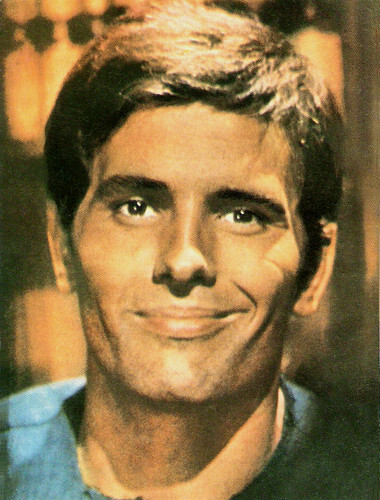
Yugoslavian postcard by Cik Razglednica.
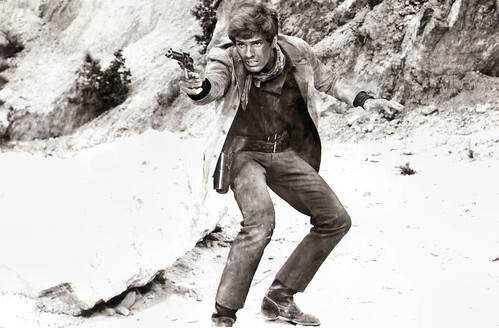
Romanian postcard by Casa Filmului Acin, no. 302. Giuliano Gemma (as Montgomery Wood) in Per pochi dollari ancora/Fort Yuma Gold (Giorgio Ferroni, 1966).
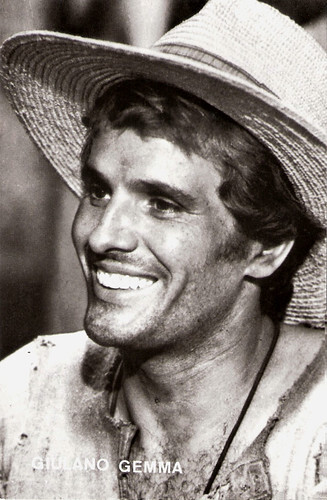
Italian postcard by Forte. Photo: publicity still for Amico, stammi lontano almeno un palmo/Ben and Charlie (Michele Lupo, 1972).
Ringo a.k.a. Angel Face
Giuliano Gemma was born in Rome in 1938. While he was playing as a kid, he found a WW II bomb in the grass that exploded and the signs of injury stayed visible on his face. He practised many sports like boxing, gymnastics, and tennis. Dante Balzano at IMDb : "In the early years of his youth he discovered a great passion for the cinema. He knew the most important Italian actors; his idol was Burt Lancaster and he decided to start acting." Gemma first worked as a stuntman, then was offered real acting parts.
His first parts included bit roles in the comedies Venezia, la luna e tu/Venice, the Moon and You (Dino Risi, 1958), starring Alberto Sordi and the ‘Italian Jayne Mansfield’, Marisa Allasio , and Arrangiatevi!/You're on Your Own (Mauro Bolognini, 1959) with Peppino De Filippo and Totò . Director Duccio Tessari offered him his first leading part in the Peplum satire Arrivano i titani/My Son, the Hero (Duccio Tessari, 1962), co-starring Jacqueline Sassard , Pedro Armendáriz and Antonella Lualdi .
He also appeared as Garibaldi’s General in Luchino Visconti's classic Il Gattopardo/The Leopard (1963), based on Giuseppe Tomasi di Lampedusa's novel of the same name. Encouraged by the success of Sergio Leone's Per un pugno di dollari/A Fistful of Dollars (1964), Duccio Tessari decided to produce his own Spaghetti Western, Una pistola per Ringo/A Pistol for Ringo (1965). The score was composed by Ennio Morricone. Giuliano Gemma, billed as Montgomery Wood, starred as the gunfighter Ringo a.k.a. Angel Face. Gemma portrayed his character, loosely based on gunfighter Johnny Ringo, as the antithesis of Clint Eastwood’s Man with No Name. Ringo is talkative, well-dressed, clean-shaven and prefers milk to whiskey.
A Pistol for Ringo was an Italian-Spanish coproduction, shot on location in Almeria, Spain. The film was a huge success on the domestic market following its release in Italy and Spain and a year later it also did well in the other West-European countries and in the US. The success of A Pistol for Ringo inspired numerous sequels, most notably Il ritorno di Ringo/The Return of Ringo (Duccio Tessari, 1965) with Lorella De Luca (aka Hally Hammond). Gemma went on to star in Spaghetti Westerns like Un dollaro bucato/Blood for a Silver Dollar (Giorgio Ferroni, 1965), Adios, Gringo (Giorgio Stegani, 1965) and I giorni dell'ira/Day of Anger (Tonino Valerii, 1967) opposite Lee van Cleef.
Gemma also appeared in non-Westerns, like the French historical romantic adventure film Angélique et le Roy/Angelique and the King (Bernard Borderie, 1966), the third part in the Angélique series featuring Michèle Mercier . Other examples were the Euro-Spy film Kiss Kiss... Bang Bang (Duccio Tessari, 1966), and the crime film I bastardi/Sons of Satan (Duccio Tessari), starring Rita Hayworth .
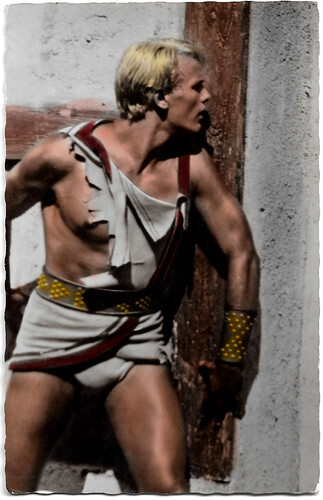
Vintage card. Giuliano Gemma in Arrivano i titan/My Son, the Hero (Duccio Tessari, 1962).
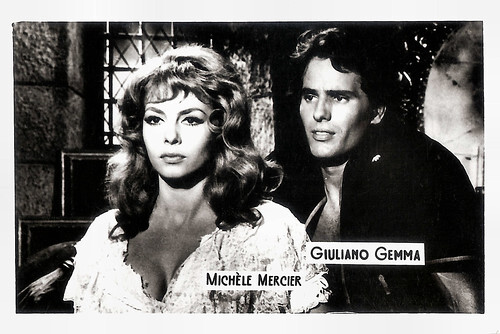
Romanian mini-card. Photo: Michèle Mercier and Giuliano Gemma in Angélique, marquise des anges/Angélique (Bernard Borderie, 1964).
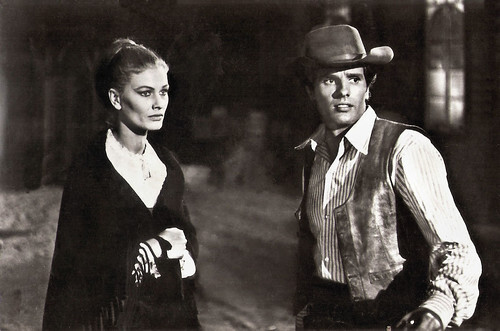
Romanian postcard by Casa Filmului Acin, no. 304. Giuliano Gemma (as Montgomery Wood) and Ida Galli (as Evelyn Stewart) in Adiós gringo (Giorgio Stegani, 1965).
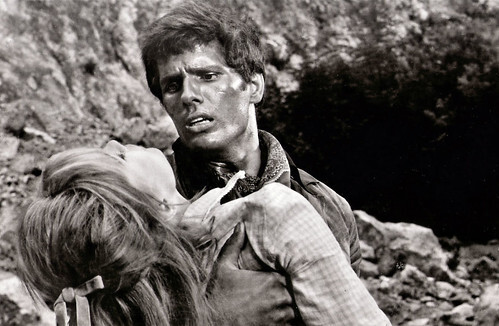
Romanian postcard by Casa Filmului Acin, no. 303.Giuliano Gemma (as Montgomery Wood) and Sophie Daumier in Per pochi dollari ancora/Fort Yuma Gold (Giorgio Ferroni, 1966).
Even Angels Eat Beans
Giuliano Gemma's career survived the demise of the Spaghetti Western genre. In 1970 he had a huge success with the comedy Quando le Donne Avevano la Coda/When Women Had Tails (Pasquale Festa Campanile, 1970), set in pre-historic times when 'women had tails' and were hunted by cavemen. Another box office hit was the action comedy Anche gli angeli mangiano fagioli/Even Angels Eat Beans (Enzo Barboni, 1973) opposite Bud Spencer . In Germany, it was awarded the Goldene Leinwand (Golden Screen) Award in 1974. He returned in the sequel, Anche gli angeli tirano di destro/Charleston (Enzo Barboni, 1974) with the debuting Ricky Bruch who replaced Bud Spencer .
Gemma also played in a variety of art-house offerings, such as the drama Delitto d'amore/Somewhere Beyond Love (Luigi Comencini, 1974) with Stefania Sandrelli, and Il deserto dei tartari/Desert of Tartars (Valerio Zurlini, 1976) for which he won a David di Donatello, the Italian equivalent of the Oscar. Three years later, he won the Grolla d'oro award for Best Actor for his part in the crime-drama Un uomo in ginocchio/A Man on His Knees (Damiano Damiani, 1979) with Michele Placido. He also worked with Damiani on the Giallo (Italian horror thriller) L'avvertimento/The Warning (Damiano Damiani, 1980), co-starring Martin Balsam.
He appeared in the Giallo Tenebrae/Tenebre (Dario Argento, 1982), starring Anthony Franciosa. In 1985 he reunited with Ducio Tessari for Tex e il signore degli abissi/Tex And The Lord Of The Deep (1985), based on the Italian comic series about ranger Tex Willer, written by Gian Luigi Bonelli. The film was meant to be the pilot of a TV Series but had very little success. More successful was the comedy Speriamo che sia femmina/Let's Hope It's a Girl (Mario Monicelli, 1986), which won the David di Donatello for Best Film and many other awards.
Gemma remained active on Italian television and incidentally appeared in interesting films like Un bel dì vedremo/One Fine Day We'll See (Tonino Valerii, 1997) and the period drama Juana la Loca/Mad Love (Vicente Aranda, 2001) which received 3 Goya awards. Pilar López de Ayala starred as the tragic Queen Joanna of Castile madly in love with an unfaithful husband, Philip the Handsome, Archduke of Austria. Gemma also worked as a sculptor. He starred in a webcomic called Man Born Again (2012) by Eclypsed Word, and he had a role in Woody Allen ’s magical realist comedy To Rome with Love (2012).
On 1 October 2013, Giuliano Gemma died following a car accident near Rome. He was taken to a hospital in Civitavecchia and pronounced dead shortly after his arrival. He was 75. Two other passengers, a man and his son, were also injured in the accident. Giuliano Gemma was married to Baba Richerme. They had two daughters, Vera and Giuliana Gemma. Vera Gemma is an actress and director. Giuliana Gemma produced Vera's documentary Giuliano Gemma: Un italiano nel mondo (Vera Gemma, 2013) about their father.
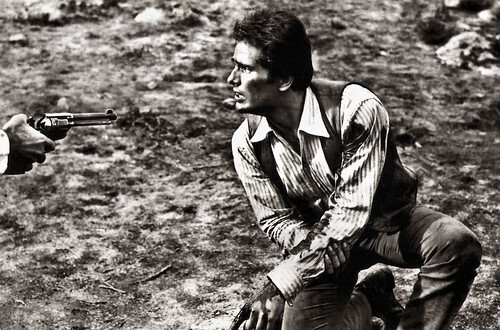
Romanian postcard by Casa Filmului Acin. Giuliano Gemma (as Montgomery Wood) in Adiós gringo (Giorgio Stegani, 1965).
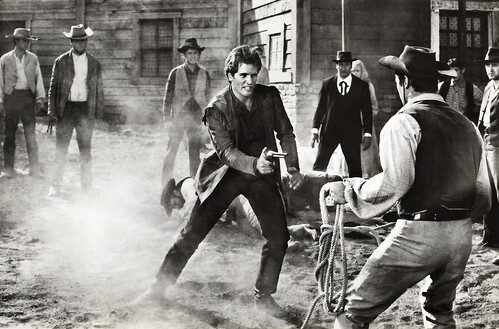
Romanian postcard by Casa Filmului Acin. Giuliano Gemma (as Montgomery Wood) in Adiós gringo (Giorgio Stegani, 1965).
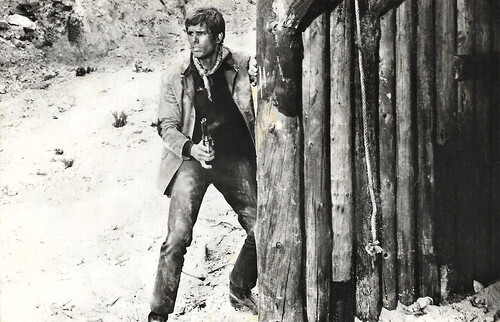
Romanian postcard by Casa Filmului Acin, no. 317. Giuliano Gemma (as Montgomery Wood) in Per pochi dollari ancora/Fort Yuma Gold (Giorgio Ferroni, 1966).
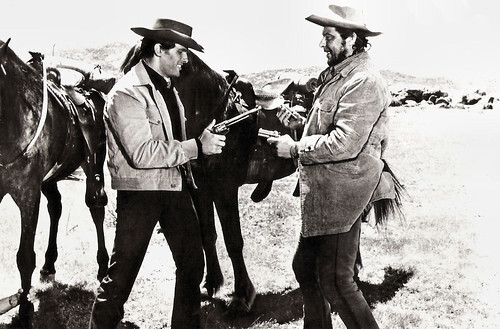
Romanian postcard by Casa Filmului Acin, no. 328. Giuliano Gemma (as Montgomery Wood) and José Calvo in Per pochi dollari ancora/Fort Yuma Gold (Giorgio Ferroni, 1966).
Sources: (IMDb), Wikipedia and .

Yugoslavian postcard by Cik Razglednica.

Romanian postcard by Casa Filmului Acin, no. 302. Giuliano Gemma (as Montgomery Wood) in Per pochi dollari ancora/Fort Yuma Gold (Giorgio Ferroni, 1966).

Italian postcard by Forte. Photo: publicity still for Amico, stammi lontano almeno un palmo/Ben and Charlie (Michele Lupo, 1972).
Ringo a.k.a. Angel Face
Giuliano Gemma was born in Rome in 1938. While he was playing as a kid, he found a WW II bomb in the grass that exploded and the signs of injury stayed visible on his face. He practised many sports like boxing, gymnastics, and tennis. Dante Balzano at IMDb : "In the early years of his youth he discovered a great passion for the cinema. He knew the most important Italian actors; his idol was Burt Lancaster and he decided to start acting." Gemma first worked as a stuntman, then was offered real acting parts.
His first parts included bit roles in the comedies Venezia, la luna e tu/Venice, the Moon and You (Dino Risi, 1958), starring Alberto Sordi and the ‘Italian Jayne Mansfield’, Marisa Allasio , and Arrangiatevi!/You're on Your Own (Mauro Bolognini, 1959) with Peppino De Filippo and Totò . Director Duccio Tessari offered him his first leading part in the Peplum satire Arrivano i titani/My Son, the Hero (Duccio Tessari, 1962), co-starring Jacqueline Sassard , Pedro Armendáriz and Antonella Lualdi .
He also appeared as Garibaldi’s General in Luchino Visconti's classic Il Gattopardo/The Leopard (1963), based on Giuseppe Tomasi di Lampedusa's novel of the same name. Encouraged by the success of Sergio Leone's Per un pugno di dollari/A Fistful of Dollars (1964), Duccio Tessari decided to produce his own Spaghetti Western, Una pistola per Ringo/A Pistol for Ringo (1965). The score was composed by Ennio Morricone. Giuliano Gemma, billed as Montgomery Wood, starred as the gunfighter Ringo a.k.a. Angel Face. Gemma portrayed his character, loosely based on gunfighter Johnny Ringo, as the antithesis of Clint Eastwood’s Man with No Name. Ringo is talkative, well-dressed, clean-shaven and prefers milk to whiskey.
A Pistol for Ringo was an Italian-Spanish coproduction, shot on location in Almeria, Spain. The film was a huge success on the domestic market following its release in Italy and Spain and a year later it also did well in the other West-European countries and in the US. The success of A Pistol for Ringo inspired numerous sequels, most notably Il ritorno di Ringo/The Return of Ringo (Duccio Tessari, 1965) with Lorella De Luca (aka Hally Hammond). Gemma went on to star in Spaghetti Westerns like Un dollaro bucato/Blood for a Silver Dollar (Giorgio Ferroni, 1965), Adios, Gringo (Giorgio Stegani, 1965) and I giorni dell'ira/Day of Anger (Tonino Valerii, 1967) opposite Lee van Cleef.
Gemma also appeared in non-Westerns, like the French historical romantic adventure film Angélique et le Roy/Angelique and the King (Bernard Borderie, 1966), the third part in the Angélique series featuring Michèle Mercier . Other examples were the Euro-Spy film Kiss Kiss... Bang Bang (Duccio Tessari, 1966), and the crime film I bastardi/Sons of Satan (Duccio Tessari), starring Rita Hayworth .

Vintage card. Giuliano Gemma in Arrivano i titan/My Son, the Hero (Duccio Tessari, 1962).

Romanian mini-card. Photo: Michèle Mercier and Giuliano Gemma in Angélique, marquise des anges/Angélique (Bernard Borderie, 1964).

Romanian postcard by Casa Filmului Acin, no. 304. Giuliano Gemma (as Montgomery Wood) and Ida Galli (as Evelyn Stewart) in Adiós gringo (Giorgio Stegani, 1965).

Romanian postcard by Casa Filmului Acin, no. 303.Giuliano Gemma (as Montgomery Wood) and Sophie Daumier in Per pochi dollari ancora/Fort Yuma Gold (Giorgio Ferroni, 1966).
Even Angels Eat Beans
Giuliano Gemma's career survived the demise of the Spaghetti Western genre. In 1970 he had a huge success with the comedy Quando le Donne Avevano la Coda/When Women Had Tails (Pasquale Festa Campanile, 1970), set in pre-historic times when 'women had tails' and were hunted by cavemen. Another box office hit was the action comedy Anche gli angeli mangiano fagioli/Even Angels Eat Beans (Enzo Barboni, 1973) opposite Bud Spencer . In Germany, it was awarded the Goldene Leinwand (Golden Screen) Award in 1974. He returned in the sequel, Anche gli angeli tirano di destro/Charleston (Enzo Barboni, 1974) with the debuting Ricky Bruch who replaced Bud Spencer .
Gemma also played in a variety of art-house offerings, such as the drama Delitto d'amore/Somewhere Beyond Love (Luigi Comencini, 1974) with Stefania Sandrelli, and Il deserto dei tartari/Desert of Tartars (Valerio Zurlini, 1976) for which he won a David di Donatello, the Italian equivalent of the Oscar. Three years later, he won the Grolla d'oro award for Best Actor for his part in the crime-drama Un uomo in ginocchio/A Man on His Knees (Damiano Damiani, 1979) with Michele Placido. He also worked with Damiani on the Giallo (Italian horror thriller) L'avvertimento/The Warning (Damiano Damiani, 1980), co-starring Martin Balsam.
He appeared in the Giallo Tenebrae/Tenebre (Dario Argento, 1982), starring Anthony Franciosa. In 1985 he reunited with Ducio Tessari for Tex e il signore degli abissi/Tex And The Lord Of The Deep (1985), based on the Italian comic series about ranger Tex Willer, written by Gian Luigi Bonelli. The film was meant to be the pilot of a TV Series but had very little success. More successful was the comedy Speriamo che sia femmina/Let's Hope It's a Girl (Mario Monicelli, 1986), which won the David di Donatello for Best Film and many other awards.
Gemma remained active on Italian television and incidentally appeared in interesting films like Un bel dì vedremo/One Fine Day We'll See (Tonino Valerii, 1997) and the period drama Juana la Loca/Mad Love (Vicente Aranda, 2001) which received 3 Goya awards. Pilar López de Ayala starred as the tragic Queen Joanna of Castile madly in love with an unfaithful husband, Philip the Handsome, Archduke of Austria. Gemma also worked as a sculptor. He starred in a webcomic called Man Born Again (2012) by Eclypsed Word, and he had a role in Woody Allen ’s magical realist comedy To Rome with Love (2012).
On 1 October 2013, Giuliano Gemma died following a car accident near Rome. He was taken to a hospital in Civitavecchia and pronounced dead shortly after his arrival. He was 75. Two other passengers, a man and his son, were also injured in the accident. Giuliano Gemma was married to Baba Richerme. They had two daughters, Vera and Giuliana Gemma. Vera Gemma is an actress and director. Giuliana Gemma produced Vera's documentary Giuliano Gemma: Un italiano nel mondo (Vera Gemma, 2013) about their father.

Romanian postcard by Casa Filmului Acin. Giuliano Gemma (as Montgomery Wood) in Adiós gringo (Giorgio Stegani, 1965).

Romanian postcard by Casa Filmului Acin. Giuliano Gemma (as Montgomery Wood) in Adiós gringo (Giorgio Stegani, 1965).

Romanian postcard by Casa Filmului Acin, no. 317. Giuliano Gemma (as Montgomery Wood) in Per pochi dollari ancora/Fort Yuma Gold (Giorgio Ferroni, 1966).

Romanian postcard by Casa Filmului Acin, no. 328. Giuliano Gemma (as Montgomery Wood) and José Calvo in Per pochi dollari ancora/Fort Yuma Gold (Giorgio Ferroni, 1966).
Sources: (IMDb), Wikipedia and .
Published on June 20, 2024 22:00
June 19, 2024
Anouk Aimée (1932-2024)
On 18 June 2024, glamorous French film actress Anouk Aimée (1932) passed away at her home in Paris. She appeared in 70 films since 1947 and worked with many talented directors. She had major international successes in the 1960s with Lola (1961) and Un homme et une femme/A Man and a Woman (1966) in which she defined a new kind of modern heroine. Anouk Aimée was 92.
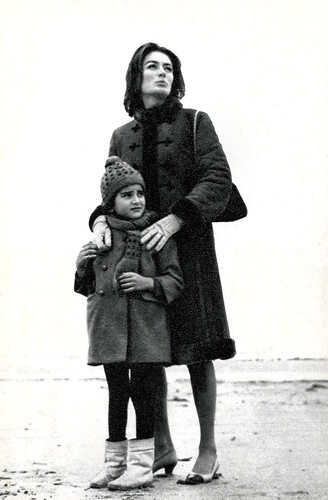
Romanian postcard by Casa Filmului Acin, no. 33. Anouk Aimée in Un homme et une femme/A Man and a Woman (Claude Lelouch, 1966).
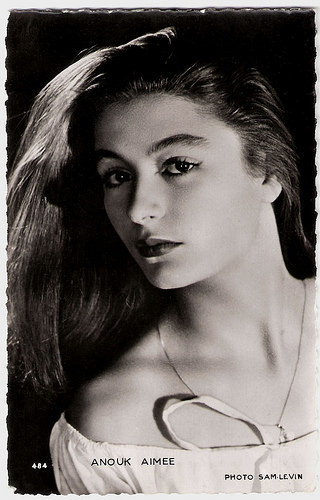
French postcard by Editions P.I., no. 484. Photo: Sam Lévin.
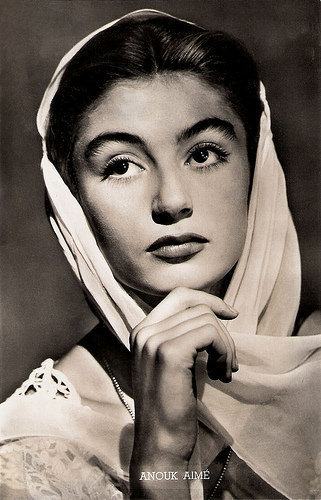
Dutch postcard, no. 453. Photo: Cornel Lucas. Anouk Aimée in The Golden Salamander (Ronald Neame, 1959).
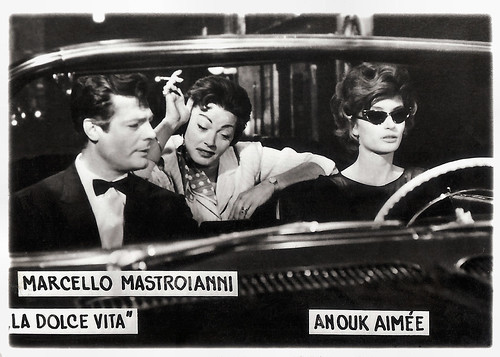
Small Romanian collectors card. Photo: Marcello Mastroianni , Adriana Moneta and Anouk Aimée in La Dolce Vita (Federico Fellini, 1960).
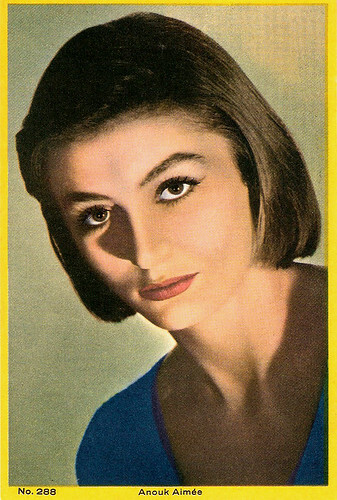
Mexican card, no. 288.
Romeo and Juliet
Anouk Aimée was born Françoise Nicole Sorya Dreyfus in Paris, France, in 1932. She was the daughter of actors Geneviève Sorya (née Durand) and Henri Murray (born Dreyfus). She was trained in acting and dancing at the Bauer-Therond school.
Aimée began her film career in 1946 at the age of 14. Reportedly she was walking down the rue Colisée in the eighth arrondissement in Paris with her mother when director Henri Calef stopped her and asked if she would like to be in a film. Her film debut was his La maison sous la mer/The House by the Sea (Henri Calef, 1947) starring Viviane Romance . She was simply billed as Anouk, the name of her character in La maison sous la mer. Next, she played in Marcel Carné’s unfinished film La Fleur de l’âge/The Flower of the Age (1947).
She played Juliette opposite Serge Reggiani as Romeo in Les amants de Vérone/Lovers of Verona (Andre Cayatte, 1949), an updated adaptation of William Shakespeare's Romeo and Juliet, specifically written for her by the poet Jacques Prevert. Prévert playfully added the symbolic last name, Aimée (Beloved), that would forever associate her with the affective power of her screen roles. Les amants de Vérone was a worldwide success.
She then worked three times with director Alexandre Astruc, at Le Rideau Cramoisi/The Crimson Curtain (1951), Deux Crimes d'Amour/Two Love Crimes (1953) and Les Mauvaises Rencontres/The Bad Liaisons (1955). She appeared in the British espionage drama Contraband Spain (Lawrence Huntington, 1955) opposite Richard Greene , and starred in the ‘perfect crime’ melodrama Tous Peuvent Me Tuer/Everybody Wants To Kill Me (Henri Decoin, 1956).
In 1958 she portrayed the artist Jeanne Hébuterne in Les Amants de Montparnasse/Montparnasse 19 (1958) about the tragic, troubled life of Italian abstract painter Amedeo Modigliani ( Gérard Philipe ). She made her Hollywood debut as a French Resistance fighter in The Journey (Anatole Litvak, 1959).
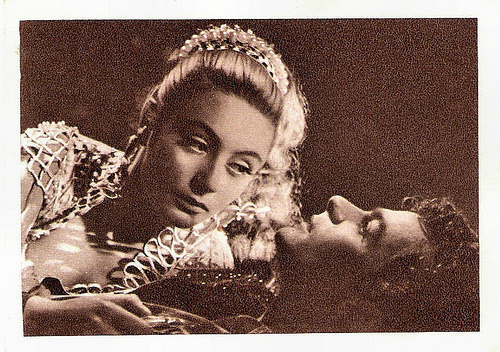
French collectors card. Photo: publicity still for Les amants de Vérone/The Lovers of Verona (André Cayatte, 1949) with Serge Reggiani .
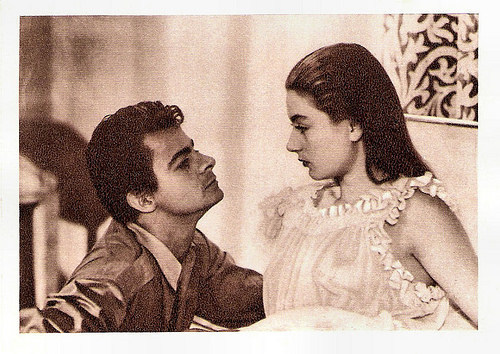
French collectors card. Photo: publicity still for Les amants de Vérone/The Lovers of Verona (André Cayatte, 1949) with Serge Reggiani .
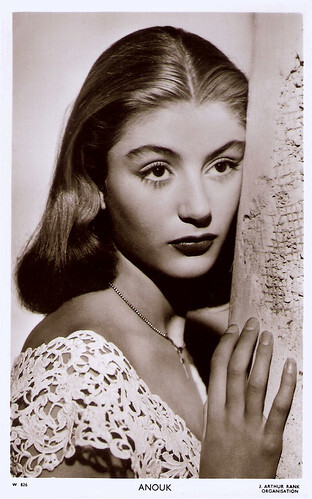
British postcard by Picturegoer Post Card, London, no. W 826. Photo: J. Arthur Rank Organisation.
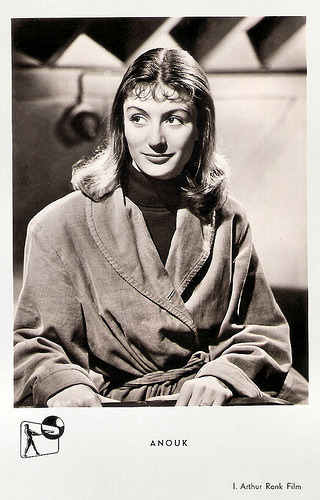
German postcard by Film und Bild, Berlin, no. A 1029. Photo: J. Arthur Rank Film. Publicity still for The Man Who Watched Trains Go By (Harold French, 1952).
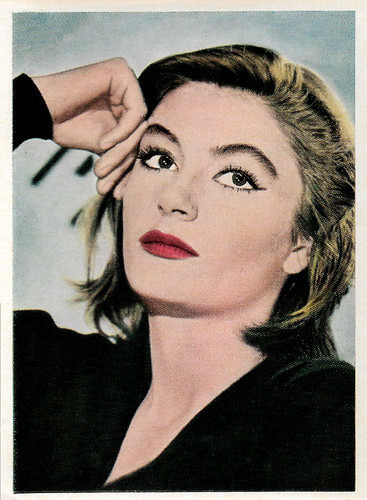
German collectors card in the "Filmstars von Hollywood bis Tokio" series III. Photo: Gabriele. Anouk Aimée in Ich suche dich/I search for you (O.W. Fischer, 1956).
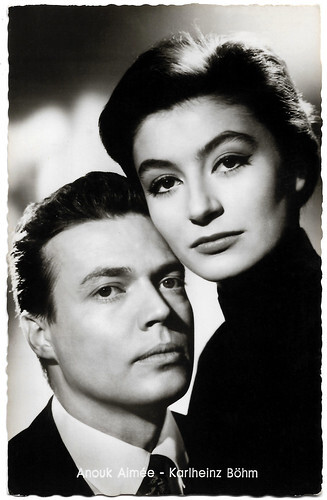
West German postcard by Kolibri-Verlag G.m.b.H., Minden/Westf., no. 2063. Photo: Corona / Schorcht. Anouk Aimée and Karlheinz Böhm in Nina (Rudolf Jugert, 1957).
Musical Without Music
Possessed of an aloof, haunting beauty, Anouk Aimée has given her best performances under the direction of such master directors as Federico Fellini and Jacques Demy. She appeared in two major films by Fellini, as a bored socialite in La dolce vita/The Sweet Life (Federico Fellini, 1960) and as Marcello Mastroianni ’s long-suffering wife in 8 ½ (1963).
Aimée had a huge success with Jacques Demy's debut film Lola (1961), a musical ‘without music’ set in the port city of Nantes. Aimée stars as the title character, a cabaret singer awaiting the return of her long-absent lover and the father of her child, who went to America seven years ago and promised to return when he became rich.
Another milestone was her work as the sexually ambivalent queen in the bible epic Sodom and Gomorrah (Robert Aldrich, 1962). Aimee reunited with Jacques Demy for The Model Shop (1969), in which Lola is an older French model living in Los Angeles who poses for photographs to pay the bills.
In between these two films, she played Anne Gauthier in the wildly romantic drama Un homme et une femme/A Man and a Woman (Claude Lelouch, 1966), a widow who falls in love with widower Jean-Louis Trintignant . This role brought her more international fame and awards. She won the 1967 Golden Globe Award for Best Actress - Motion Picture Drama and was nominated for an Academy Award for Best Actress.
She had the chance to establish herself in Hollywood but she refused many roles, including that of Vicki Anderson, the insurance investigator eventually played by Faye Dunaway opposite Steve McQueen in the first The Thomas Crown Affair (Norman Jewison, 1968). She did play the title role in Justine (George Cukor, 1969) with Michael York and in The Appointment (Sidney Lumet, 1969) with Omar Sharif, but her American film career went nowhere.
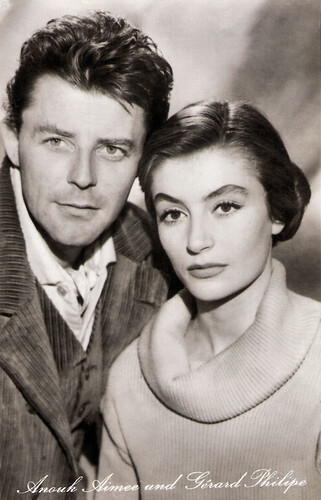
East-German postcard by VEB Progress Filmvertrieb, Berlin no. 1272, 1960. Photo: Gérard Philipe and Anouk Aimée in Les amants de Montparnasse/The Lovers of Montparnasse (Jacques Becker, 1958).
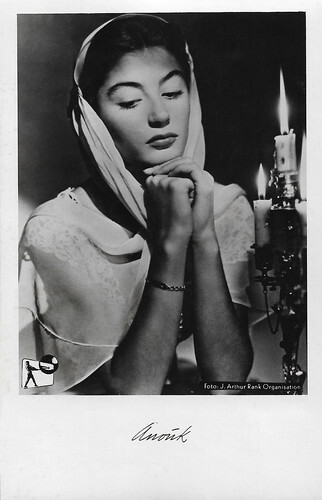
Vintage postcard. Photo: J. Arthur Rank Organisation. Anouk Aimée in The Golden Salamander (Ronald Neame, 1959).
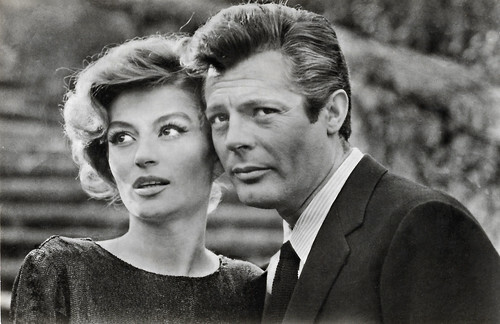
Romanian postcard by Casa Filmului Acin, no. 159. Anouk Aimée and Marcello Mastroianni in La dolce vita/The Sweet Life (Federico Fellini, 1960).
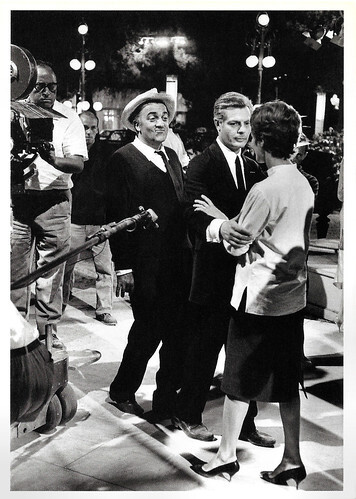
Swiss postcard by News Productions, Baulmes, no. 55590. Photo: Michelangelo Durazzo / ANA. Collection: Musée de l'Elysée, Lausanne. Caption: Federico Fellini directing a scene of the film 8 ½ (1963) with Marcello Mastroianni and Anouk Aimée.
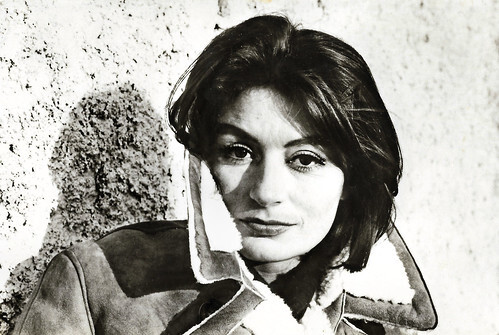
Romanian postcard by Casa Filmului Acin, no. 135. Anouk Aimée in Un homme et une femme/A Man and a Woman (Claude Lelouch, 1966).
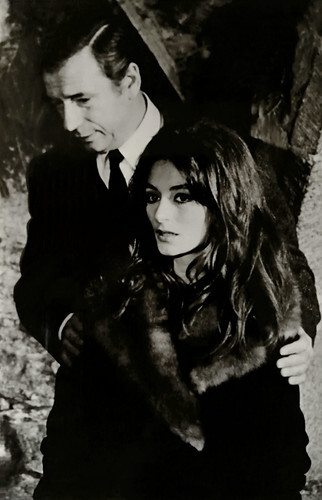
Romanian postcard by Casa Filmului Acin, no. 291. Yves Montand and Anouk Aimee in Un soir un train/One Night... a Train (André Delvaux, 1968). Collection: Alina Deaconu.
Icon of Cool
After a break of seven years, Anouk Aimée returned to the cinema in Si c'était à refaire/If It Could Be Done Over Again (Claude Lelouch, 1976) with Catherine Deneuve as two former prison buddies who get on with the business of living. She was awarded the Award for Best Actress at the 1980 Cannes Film Festival for her performance in Marco Bellocchio's Salto nel vuoto/Leap Into The Void (1979), with her co-star Michel Piccoli winning the Best Actor Prize. It was followed by roles in La tragedia di un uomo ridicolo/The Tragedy of a Ridiculous Man (Bernardo Bertolucci, 1980) opposite Ugo Tognazzi , and Success is the Best Revenge (Jerzy Skolimowsky, 1984) starring Michael York.
Looking every bit as alluring as she had in 1966, Aimee reprised her most famous role as Anne Gauthier in Un Homme et une Femme: Vingt Ans Déjà/A Man and a Woman: Twenty Years Later (Claude Lelouch, 1986), again opposite Jean-Louis Trintignant . She also portrayed the worldly-wise designer Simone Lowenthal in Prêt-à-Porter/Ready to Wear (1994), Robert Altman's comedy about the Parisian fashion scene.
Aimée was known as a champion of human rights. In 2002 she supported Lionel Jospin's presidential campaign. That year she was awarded a César d'honneur (an honorary César Award), and the following year she received an honorary Golden Bear at the Berlin Film Festival. As Sandy Flitterman-Lewis writes in the Jewish Women Encyclopedia , Anouk Aimée was "known for her remarkable presence as an icon of cool, sophisticated beauty in more than seventy films across seven decades. (...) Words like ‘regal,’ ‘intelligent’ and ‘enigmatic’ are frequently associated with her, giving Aimée an aura of disturbing and mysterious beauty that has earned her the status of one of the hundred sexiest stars in film history (in the 1995 poll conducted by Empire Magazine )".
Anouk Aimee remained active. Later films in which she appeared, include the comedy Ils se marièrent et eurent beaucoup d'enfants/Happily Ever After (Yvan Attal, 2004) with Charlotte Gainsbourg , the political thriller De Particulier à Particulier/Hotel Harabati (Brice Chauvin, 2006), Celle que j'aime/The One I Love (Elie Chouraqui, 2009), the romance Ces amours-là/These Courtship (Claude Lelouch, 2010) and Paris Connections (Harley Cokeliss, 2010), a glittering adaptation of a Jackie Collins novel produced by American supermarket giant Tesco.
Anouk Aimée died in Paris in 2024, at the age of 92. Aimée was married four times. From 1949 to 1950 she was married to Edouard Zimmermann. Her second husband (1951–1954) was the film director Nikos Papatakis, with whom she has a daughter Manuela (1951). Her third marriage was to composer ;Pierre Barouh (1966-1969). From 1970 to 1978, she was married to the British actor Albert Finney .
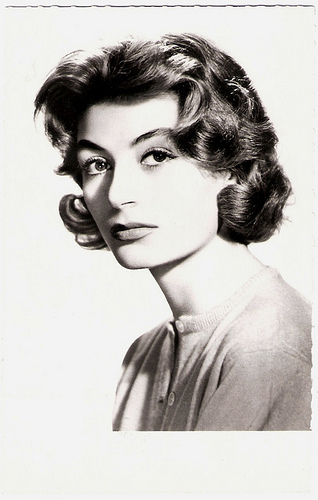
French postcard by Editions P.I., Paris, no. 952. Photo: Sam Lévin.
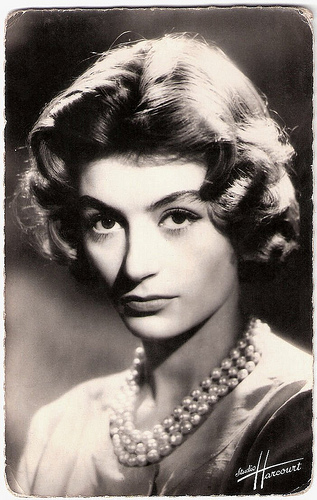
French postcard by Editions du Globe (E.D.U.G.), Paris, no. 702. Photo: Studio Harcourt.
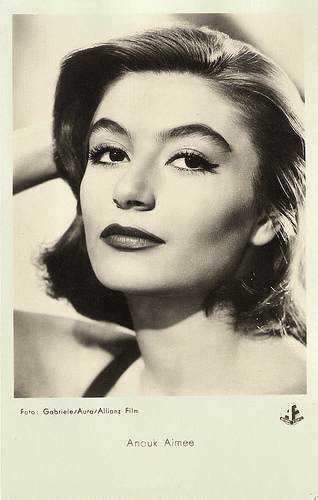
French postcard by Editions P.I., Paris, no. FK 2195. Photo: Gabriele / Aura / Allianz-Film.
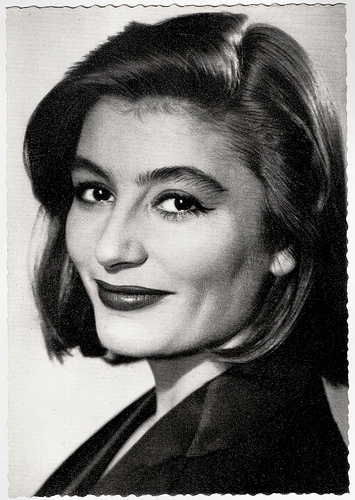
German postcard by Filmbilder-Vertrieb Ernst Freihoff, Essen, no. 116. Photo: Allianz Film.
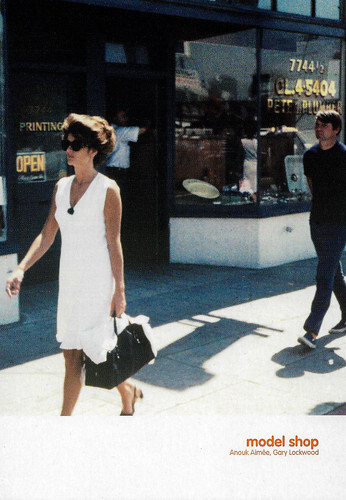
French postcard by Ciné-Tamaris and Arte Video to promote the DVD and CD box 'Intégrale Jacques Demy'. Anouk Aimée and Gary Lockwood in Model Shop (Jacques Demy, 1969).
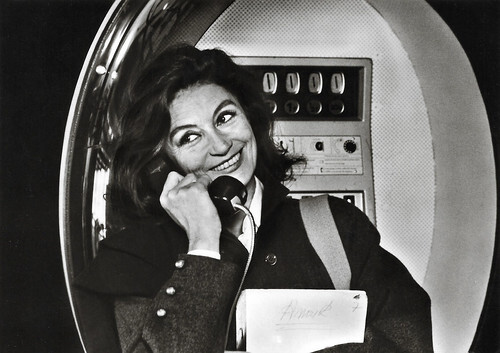
Big East-German card by Progress Film-Verleih.
French trailer of Lola (1961). Source: Fondation Gan pour le Cinéma (YouTube).
Trailer for 8 1/2 (1963). Source: Soundtracks and Trailers (YouTube).
Trailer of Justine (1969). Source: modcinema (YouTube).
Sources: Hal Erickson (AllMovie - page now defunct), (IMDb), Sandy Flitterman-Lewis (Jewish Women Encyclopedia), AlloCiné (French - page now defunct), Wikipedia, and .

Romanian postcard by Casa Filmului Acin, no. 33. Anouk Aimée in Un homme et une femme/A Man and a Woman (Claude Lelouch, 1966).

French postcard by Editions P.I., no. 484. Photo: Sam Lévin.

Dutch postcard, no. 453. Photo: Cornel Lucas. Anouk Aimée in The Golden Salamander (Ronald Neame, 1959).

Small Romanian collectors card. Photo: Marcello Mastroianni , Adriana Moneta and Anouk Aimée in La Dolce Vita (Federico Fellini, 1960).

Mexican card, no. 288.
Romeo and Juliet
Anouk Aimée was born Françoise Nicole Sorya Dreyfus in Paris, France, in 1932. She was the daughter of actors Geneviève Sorya (née Durand) and Henri Murray (born Dreyfus). She was trained in acting and dancing at the Bauer-Therond school.
Aimée began her film career in 1946 at the age of 14. Reportedly she was walking down the rue Colisée in the eighth arrondissement in Paris with her mother when director Henri Calef stopped her and asked if she would like to be in a film. Her film debut was his La maison sous la mer/The House by the Sea (Henri Calef, 1947) starring Viviane Romance . She was simply billed as Anouk, the name of her character in La maison sous la mer. Next, she played in Marcel Carné’s unfinished film La Fleur de l’âge/The Flower of the Age (1947).
She played Juliette opposite Serge Reggiani as Romeo in Les amants de Vérone/Lovers of Verona (Andre Cayatte, 1949), an updated adaptation of William Shakespeare's Romeo and Juliet, specifically written for her by the poet Jacques Prevert. Prévert playfully added the symbolic last name, Aimée (Beloved), that would forever associate her with the affective power of her screen roles. Les amants de Vérone was a worldwide success.
She then worked three times with director Alexandre Astruc, at Le Rideau Cramoisi/The Crimson Curtain (1951), Deux Crimes d'Amour/Two Love Crimes (1953) and Les Mauvaises Rencontres/The Bad Liaisons (1955). She appeared in the British espionage drama Contraband Spain (Lawrence Huntington, 1955) opposite Richard Greene , and starred in the ‘perfect crime’ melodrama Tous Peuvent Me Tuer/Everybody Wants To Kill Me (Henri Decoin, 1956).
In 1958 she portrayed the artist Jeanne Hébuterne in Les Amants de Montparnasse/Montparnasse 19 (1958) about the tragic, troubled life of Italian abstract painter Amedeo Modigliani ( Gérard Philipe ). She made her Hollywood debut as a French Resistance fighter in The Journey (Anatole Litvak, 1959).

French collectors card. Photo: publicity still for Les amants de Vérone/The Lovers of Verona (André Cayatte, 1949) with Serge Reggiani .

French collectors card. Photo: publicity still for Les amants de Vérone/The Lovers of Verona (André Cayatte, 1949) with Serge Reggiani .

British postcard by Picturegoer Post Card, London, no. W 826. Photo: J. Arthur Rank Organisation.

German postcard by Film und Bild, Berlin, no. A 1029. Photo: J. Arthur Rank Film. Publicity still for The Man Who Watched Trains Go By (Harold French, 1952).

German collectors card in the "Filmstars von Hollywood bis Tokio" series III. Photo: Gabriele. Anouk Aimée in Ich suche dich/I search for you (O.W. Fischer, 1956).

West German postcard by Kolibri-Verlag G.m.b.H., Minden/Westf., no. 2063. Photo: Corona / Schorcht. Anouk Aimée and Karlheinz Böhm in Nina (Rudolf Jugert, 1957).
Musical Without Music
Possessed of an aloof, haunting beauty, Anouk Aimée has given her best performances under the direction of such master directors as Federico Fellini and Jacques Demy. She appeared in two major films by Fellini, as a bored socialite in La dolce vita/The Sweet Life (Federico Fellini, 1960) and as Marcello Mastroianni ’s long-suffering wife in 8 ½ (1963).
Aimée had a huge success with Jacques Demy's debut film Lola (1961), a musical ‘without music’ set in the port city of Nantes. Aimée stars as the title character, a cabaret singer awaiting the return of her long-absent lover and the father of her child, who went to America seven years ago and promised to return when he became rich.
Another milestone was her work as the sexually ambivalent queen in the bible epic Sodom and Gomorrah (Robert Aldrich, 1962). Aimee reunited with Jacques Demy for The Model Shop (1969), in which Lola is an older French model living in Los Angeles who poses for photographs to pay the bills.
In between these two films, she played Anne Gauthier in the wildly romantic drama Un homme et une femme/A Man and a Woman (Claude Lelouch, 1966), a widow who falls in love with widower Jean-Louis Trintignant . This role brought her more international fame and awards. She won the 1967 Golden Globe Award for Best Actress - Motion Picture Drama and was nominated for an Academy Award for Best Actress.
She had the chance to establish herself in Hollywood but she refused many roles, including that of Vicki Anderson, the insurance investigator eventually played by Faye Dunaway opposite Steve McQueen in the first The Thomas Crown Affair (Norman Jewison, 1968). She did play the title role in Justine (George Cukor, 1969) with Michael York and in The Appointment (Sidney Lumet, 1969) with Omar Sharif, but her American film career went nowhere.

East-German postcard by VEB Progress Filmvertrieb, Berlin no. 1272, 1960. Photo: Gérard Philipe and Anouk Aimée in Les amants de Montparnasse/The Lovers of Montparnasse (Jacques Becker, 1958).

Vintage postcard. Photo: J. Arthur Rank Organisation. Anouk Aimée in The Golden Salamander (Ronald Neame, 1959).

Romanian postcard by Casa Filmului Acin, no. 159. Anouk Aimée and Marcello Mastroianni in La dolce vita/The Sweet Life (Federico Fellini, 1960).

Swiss postcard by News Productions, Baulmes, no. 55590. Photo: Michelangelo Durazzo / ANA. Collection: Musée de l'Elysée, Lausanne. Caption: Federico Fellini directing a scene of the film 8 ½ (1963) with Marcello Mastroianni and Anouk Aimée.

Romanian postcard by Casa Filmului Acin, no. 135. Anouk Aimée in Un homme et une femme/A Man and a Woman (Claude Lelouch, 1966).

Romanian postcard by Casa Filmului Acin, no. 291. Yves Montand and Anouk Aimee in Un soir un train/One Night... a Train (André Delvaux, 1968). Collection: Alina Deaconu.
Icon of Cool
After a break of seven years, Anouk Aimée returned to the cinema in Si c'était à refaire/If It Could Be Done Over Again (Claude Lelouch, 1976) with Catherine Deneuve as two former prison buddies who get on with the business of living. She was awarded the Award for Best Actress at the 1980 Cannes Film Festival for her performance in Marco Bellocchio's Salto nel vuoto/Leap Into The Void (1979), with her co-star Michel Piccoli winning the Best Actor Prize. It was followed by roles in La tragedia di un uomo ridicolo/The Tragedy of a Ridiculous Man (Bernardo Bertolucci, 1980) opposite Ugo Tognazzi , and Success is the Best Revenge (Jerzy Skolimowsky, 1984) starring Michael York.
Looking every bit as alluring as she had in 1966, Aimee reprised her most famous role as Anne Gauthier in Un Homme et une Femme: Vingt Ans Déjà/A Man and a Woman: Twenty Years Later (Claude Lelouch, 1986), again opposite Jean-Louis Trintignant . She also portrayed the worldly-wise designer Simone Lowenthal in Prêt-à-Porter/Ready to Wear (1994), Robert Altman's comedy about the Parisian fashion scene.
Aimée was known as a champion of human rights. In 2002 she supported Lionel Jospin's presidential campaign. That year she was awarded a César d'honneur (an honorary César Award), and the following year she received an honorary Golden Bear at the Berlin Film Festival. As Sandy Flitterman-Lewis writes in the Jewish Women Encyclopedia , Anouk Aimée was "known for her remarkable presence as an icon of cool, sophisticated beauty in more than seventy films across seven decades. (...) Words like ‘regal,’ ‘intelligent’ and ‘enigmatic’ are frequently associated with her, giving Aimée an aura of disturbing and mysterious beauty that has earned her the status of one of the hundred sexiest stars in film history (in the 1995 poll conducted by Empire Magazine )".
Anouk Aimee remained active. Later films in which she appeared, include the comedy Ils se marièrent et eurent beaucoup d'enfants/Happily Ever After (Yvan Attal, 2004) with Charlotte Gainsbourg , the political thriller De Particulier à Particulier/Hotel Harabati (Brice Chauvin, 2006), Celle que j'aime/The One I Love (Elie Chouraqui, 2009), the romance Ces amours-là/These Courtship (Claude Lelouch, 2010) and Paris Connections (Harley Cokeliss, 2010), a glittering adaptation of a Jackie Collins novel produced by American supermarket giant Tesco.
Anouk Aimée died in Paris in 2024, at the age of 92. Aimée was married four times. From 1949 to 1950 she was married to Edouard Zimmermann. Her second husband (1951–1954) was the film director Nikos Papatakis, with whom she has a daughter Manuela (1951). Her third marriage was to composer ;Pierre Barouh (1966-1969). From 1970 to 1978, she was married to the British actor Albert Finney .

French postcard by Editions P.I., Paris, no. 952. Photo: Sam Lévin.

French postcard by Editions du Globe (E.D.U.G.), Paris, no. 702. Photo: Studio Harcourt.

French postcard by Editions P.I., Paris, no. FK 2195. Photo: Gabriele / Aura / Allianz-Film.

German postcard by Filmbilder-Vertrieb Ernst Freihoff, Essen, no. 116. Photo: Allianz Film.

French postcard by Ciné-Tamaris and Arte Video to promote the DVD and CD box 'Intégrale Jacques Demy'. Anouk Aimée and Gary Lockwood in Model Shop (Jacques Demy, 1969).

Big East-German card by Progress Film-Verleih.
French trailer of Lola (1961). Source: Fondation Gan pour le Cinéma (YouTube).
Trailer for 8 1/2 (1963). Source: Soundtracks and Trailers (YouTube).
Trailer of Justine (1969). Source: modcinema (YouTube).
Sources: Hal Erickson (AllMovie - page now defunct), (IMDb), Sandy Flitterman-Lewis (Jewish Women Encyclopedia), AlloCiné (French - page now defunct), Wikipedia, and .
Published on June 19, 2024 22:00
June 18, 2024
Fred Solm
Fred Solm (1899-1982) was a German actor of the silent era who ended his career in Hollywood.
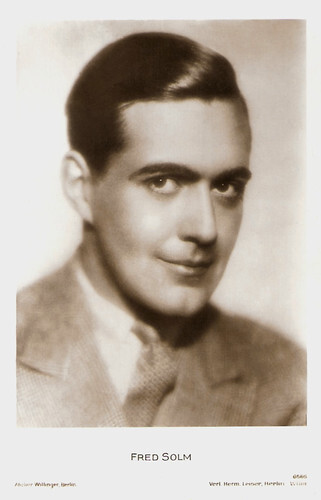
German postcard by Verlag Hermann Leiser, Berlin-Wilm., no. 6565. Photo: Atelier Willinger, Berlin.
At 16 to the front
Fred Solm was born Friedrich Richard Salomon in Frankfurt, Germany, in 1899.
Standing 1.89 metres tall, Solm enlisted for the front in 1915 at the age of 16 and was assigned to a cavalry unit. Solm was conscripted until 1920, after which he began studying art history and also took dramaturgy lessons. These courses took him to Florence and Munich.
He also tried his hand at writing on the side. According to his account, he talked to a friend of Conrad Veidt about film subjects in the Berlin artists' pub Schwannecke and thus made his first contact with the celluloid industry.
Conrad Veidt persuaded Solm to concentrate on working in front of the camera rather than writing scripts. Fred Solm made his debut as a film actor in Der Herr des Todes/The Master of Death (Hans Steinhoff, 1926).
During the silent film era, he appeared in such German films as Der Meister der Welt/The Champion of the World (Gennaro Righelli, 1927), the war film U-9 Weddigen (Heinz Paul, 1927) starring Carl de Vogt , Mathilde Sussin and Fritz Alberti, and the drama Die berühmte Frau/The Famous Woman (Robert Wiene, 1927) starring Lily Damita .
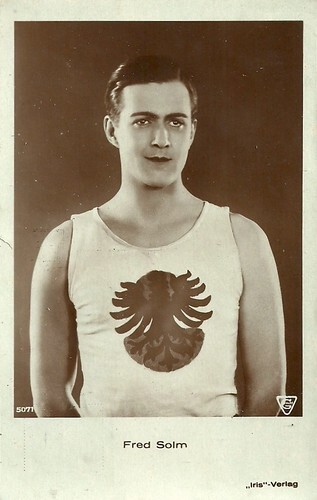
Austrian postcard by Iris Verlag, no. 5071. Photo: Greenbaum- Film. Fred Solm in the German silent film Der Meister der Welt/The Champion of the World (Gennaro Righelli, 1927).
Number 17
Fred Solm appeared opposite Francesca Bertini in the silent drama Mein Leben für das Deine/Odette (Luitz-Morat, 1928) based upon the play by Victorien Sardou. He also co-starred in the comedy Die große Abenteuerin/The Great Adventuress (Robert Wiene, 1928) opposite Lily Damita and Georg Alexander . Much of the film's funding came from Britain.
Solm had a supporting part in Haus Nummer 17/Number 17 (Géza von Bolváry, 1928), a German-British silent crime film starring Guy Newall, Lien Deyers , and Carl de Vogt . The English version was produced with sound. While the sound version has no audible dialogue, it features a synchronised musical score with sound effects.
Haus Nummer 17/Number 17 was based on the 1925 play 'Number 17' by Joseph Jefferson Farjeon, later adapted by Alfred Hitchcock for his film Number Seventeen (1932). The 1928 film was one of several co-productions made in the 1920s between Britain's Gainsborough Pictures and Germany's Felsom Film. It was shot at the Tempelhof Studios in Berlin. Solm was the leading man in the comedy Das Spreewaldmädel/When the Guard Marches (Hans Steinhoff, 1928) starring Claire Rommer .
He appeared uncredited as a chauffeur in the American silent film The Single Standard (John S. Robertson, 1929) starring Greta Garbo . Then followed a bigger role in Marianne (Robert Z. Leonard, 1929), a romantic drama about a French farm girl who, despite already having a French fiancé (Solm, credited as Robert Castle), falls in love with an American soldier (Oscar Shaw) during World War I. It was made first as a silent film, then as a musical with a different cast, but Marion Davies starred in both versions.
The rising sound film ended Fred Solm's brief Hollywood career. There is nothing known about his later life. According to IMDb , he was born in Iglau, Austria-Hungary, but the database combines his life and filmography with that of Austrian actor Alfred Solm, whose film career only started after the Second World War.
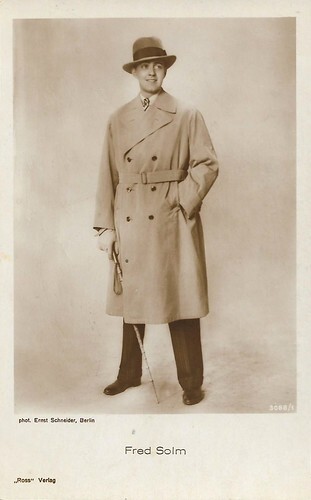
German postcard by Ross Verlag, no. 3088/1, 1928-1929. Photo: Ernst Schneider.
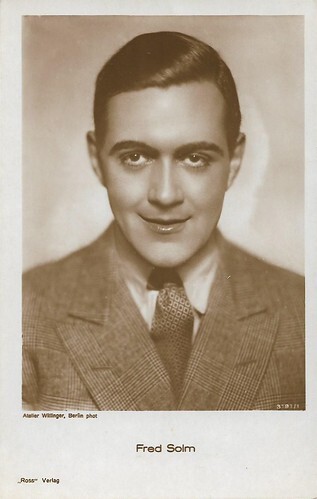
German postcard by Ross Verlag, no. 3181/1, 1928-1929. Photo: Atelier Willinger, Berlin.
Sources: Wikipedia (German and English) and .

German postcard by Verlag Hermann Leiser, Berlin-Wilm., no. 6565. Photo: Atelier Willinger, Berlin.
At 16 to the front
Fred Solm was born Friedrich Richard Salomon in Frankfurt, Germany, in 1899.
Standing 1.89 metres tall, Solm enlisted for the front in 1915 at the age of 16 and was assigned to a cavalry unit. Solm was conscripted until 1920, after which he began studying art history and also took dramaturgy lessons. These courses took him to Florence and Munich.
He also tried his hand at writing on the side. According to his account, he talked to a friend of Conrad Veidt about film subjects in the Berlin artists' pub Schwannecke and thus made his first contact with the celluloid industry.
Conrad Veidt persuaded Solm to concentrate on working in front of the camera rather than writing scripts. Fred Solm made his debut as a film actor in Der Herr des Todes/The Master of Death (Hans Steinhoff, 1926).
During the silent film era, he appeared in such German films as Der Meister der Welt/The Champion of the World (Gennaro Righelli, 1927), the war film U-9 Weddigen (Heinz Paul, 1927) starring Carl de Vogt , Mathilde Sussin and Fritz Alberti, and the drama Die berühmte Frau/The Famous Woman (Robert Wiene, 1927) starring Lily Damita .

Austrian postcard by Iris Verlag, no. 5071. Photo: Greenbaum- Film. Fred Solm in the German silent film Der Meister der Welt/The Champion of the World (Gennaro Righelli, 1927).
Number 17
Fred Solm appeared opposite Francesca Bertini in the silent drama Mein Leben für das Deine/Odette (Luitz-Morat, 1928) based upon the play by Victorien Sardou. He also co-starred in the comedy Die große Abenteuerin/The Great Adventuress (Robert Wiene, 1928) opposite Lily Damita and Georg Alexander . Much of the film's funding came from Britain.
Solm had a supporting part in Haus Nummer 17/Number 17 (Géza von Bolváry, 1928), a German-British silent crime film starring Guy Newall, Lien Deyers , and Carl de Vogt . The English version was produced with sound. While the sound version has no audible dialogue, it features a synchronised musical score with sound effects.
Haus Nummer 17/Number 17 was based on the 1925 play 'Number 17' by Joseph Jefferson Farjeon, later adapted by Alfred Hitchcock for his film Number Seventeen (1932). The 1928 film was one of several co-productions made in the 1920s between Britain's Gainsborough Pictures and Germany's Felsom Film. It was shot at the Tempelhof Studios in Berlin. Solm was the leading man in the comedy Das Spreewaldmädel/When the Guard Marches (Hans Steinhoff, 1928) starring Claire Rommer .
He appeared uncredited as a chauffeur in the American silent film The Single Standard (John S. Robertson, 1929) starring Greta Garbo . Then followed a bigger role in Marianne (Robert Z. Leonard, 1929), a romantic drama about a French farm girl who, despite already having a French fiancé (Solm, credited as Robert Castle), falls in love with an American soldier (Oscar Shaw) during World War I. It was made first as a silent film, then as a musical with a different cast, but Marion Davies starred in both versions.
The rising sound film ended Fred Solm's brief Hollywood career. There is nothing known about his later life. According to IMDb , he was born in Iglau, Austria-Hungary, but the database combines his life and filmography with that of Austrian actor Alfred Solm, whose film career only started after the Second World War.

German postcard by Ross Verlag, no. 3088/1, 1928-1929. Photo: Ernst Schneider.

German postcard by Ross Verlag, no. 3181/1, 1928-1929. Photo: Atelier Willinger, Berlin.
Sources: Wikipedia (German and English) and .
Published on June 18, 2024 22:00
June 17, 2024
Ruth-Maria Kubitschek (1931-2024)
Czech-born, German-Swiss actress Ruth-Maria Kubitschek (1931) died on 1 June 2024 in Ascona. She appeared in over 160 film and television productions in around six decades. Kubitschek became known to television audiences as Annette von Soettingen, alias ‘Spatzl’, in Monaco Franze - Der ewige Stenz (1983), as newspaper publisher Friederike von Unruh in Kir Royal (1986) and as Margot Balbeck in Das Erbe der Guldenburgs (1987). Ruth-Maria Kubitschek was 92.
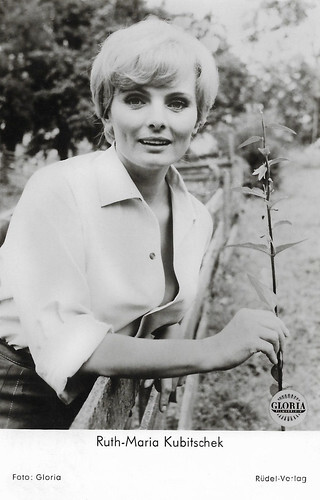
West German postcard by Rüdel-Verlag, Hamburg, no. 4731. Photo: Gloria. Ruth-Maria Kubitschek in Mitsommernacht/Midsummer Night (Paul May, 1967).
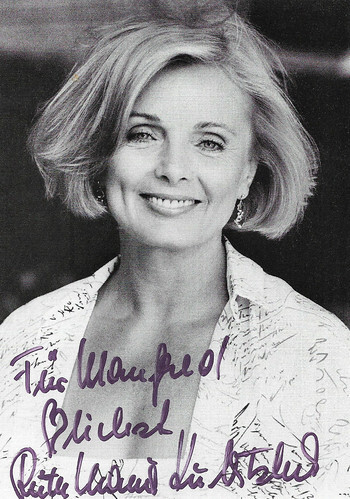
West German autograph card.
The first East German/Polish Science Fiction film in colour
Ruth-Maria Kubitschek was born in 1931 in Komotau, Czechoslovakia (now Chomutov, Czech Republic). She was one of five sisters. Her father was in charge of a coal mining operation in northern Bohemia in the Czech Republic until the end of the Second World War. After the end of World War II, the family fled to Köthen (Saxony-Anhalt). Kubitschek grew up in the GDR.
Against her parents' wishes, she decided to become an actor. After high school, she went to the University for Theatre and Music (Hochschule für Theater und Musik) in Halle and then to the German Theatre Institute (Deutsches Theater-Institut) in Weimar. She made her stage debut in Bertold Brecht's 'Herr Puntila und sein Knecht Matti'. Then, she had engagements at the Maxim-Gorki-Bühne Schwerin, the Theater der Freundschaft Berlin, and the Staatstheater Schwerin.
Already a noted star on the East German stage, she began her screen career with DEFA. In 1953, Kubitschek made her film debut in the comedy Jacke wie Hose/Swings or Roundabouts (Eduard Kubat, 1953) in the role of Eva. She also had supporting parts in the East German films Thomas Muentzer (Martin Hellberg, 1956), about the life of the 16th-century Protestant theologian and peasant leader Thomas Muentzer, and Der Fackelträger (Johannes Knittel, 1957).
She also acted in Der schweigende Stern/Milcząca Gwiazda/The Silent Star (Kurt Maetzig, 1960), starring Günther Simon and Yoko Tani . The first East German/Polish Science Fiction film in colour was based on the novel 'The Astronauts' by Polish Sci-Fi writer Stanisław Lem. In 1959, Kubitschek stayed in West Germany after a theatre performance. There she initially also performed various theatre performances.
She also appeared in a few West German films such as the mystery Er kann's nicht lassen/He Can't Stop Doing It (Axel von Ambesser, 1962) starring Heinz Rühmann . It was loosely based on the Father Brown stories by G. K. Chesterton. Rühmann reprised his role from the film The Black Sheep (1960). Other films were the comedy-drama Sperrbezirk (Will Tremper, 1966) starring Harald Leipnitz, the Norway-situated Heimatfilm Mitsommernacht/Midsummer Night (Paul May, 1967) with American TV actor Robert Fuller, and the Guy de Maupassant adaptation Madame und ihre Nichte/Madame and Her Niece (Eberhard Schröder, 1969) with Edwige Fenech and Fred Williams.
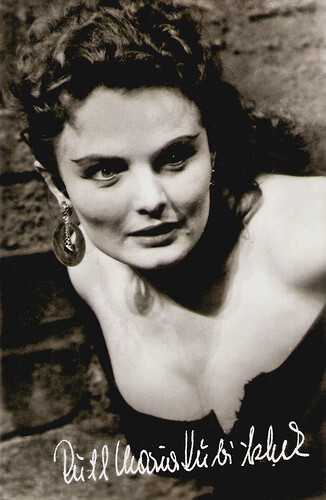
East German postcard by VEB Progress Film-Vertrieb, Berlin, no. 305, 1957. Photo: Albert Kolbe / DEFA.
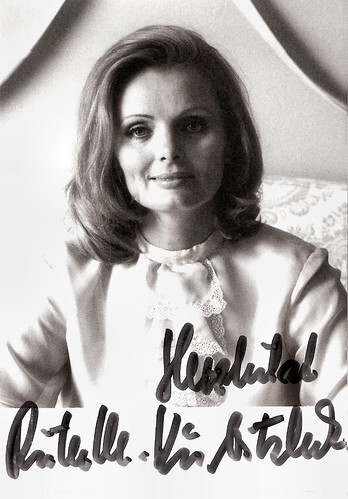
West German autograph card by TURA.
The artistic highlights of her career
Ruth-Maria Kubitschek gained great popularity through television. First, she appeared in the Francis Durbridge thriller Melissa (Paul May, 1966). She starred alongside Ralf Wolter in the 13-part series Ein Fall für Titus Bunge/A Case for Titus Bunge (Günter Gräwert, 1967). She had other well-known television roles in Tatort: Blechschaden/Crime Scene: Fender Bender (Wolfgang Petersen, 1971) with Klaus Schwarzkopf and Götz George , Der Kommissar: Blinde Spiele/The Commissioner: Blinde Spiele (Theodor Grädler, 1972), and Das Erbe der Guldenburgs/The Legacy of the Guldenburgs (Gero Erhardt, Jürgen Goslar, 1986-1989).
She later rated two series directed by Helmut Dietl, Monaco Franze – Der ewige Stenz/ Monaco Franz - the Eternal Dandy (Helmut Dietl, 1983) with Helmut Fischer, Kir Royal (Helmut Dietl, 1986) with Franz Xaver Kroetz, as the artistic highlights of her career. Kubitschek appeared alongside Mathieu Carrière as Countess Sophie von Hohenstein in the TV series Schloß Hohenstein/Hohenstein Castle (1992-1995) and played the successful businesswoman Marlies Holbein in Freunde fürs Leben/Friends for life (1992-2001).
In the cinema, Kubitscheck showed her comedic talent alongside Dieter Hallervorden in the comedy of mistaken identity Didi - Der Doppelgänger/Non-Stop Trouble with My Double (Reinhard Schwabenitzky, 1984) in the female leading role of Heidi Immer. In 1992, she took on the role of Frau von Lodenwald in the comedy Otto - Der Liebesfilm/Otto: The Love Film (Otto Waalkes, Bernd Eilert, 1992), Otto Waalkes ' fourth feature film.
In addition to her stage and film work, Kubitschek worked as a dubbing actress and lent her voice to Danielle Darrieux for 8 femmes/8 Women (François Ozon, 2002), Daliah Lavi for Old Shatterhand (Hugo Fregonese, 1964) and Delphine Seyrig for Muriel ou Le temps d’un retour/Muriel or the Time of Return (Alain Resnais, 1963). Kubitschek was also the author of novels and esoteric books. She was a strong supporter of meditation and believed in elfins and ghosts. In 1953 she married opera director and writer Götz Friedrich. They had a son, Alexander (1957) and divorced in 1962 or 1963. From 1976 until he died in 2016, she was the companion of TV producer Wolfgang Rademann. Since 2013, she was a Swiss citizen.
Wolf Gremm directed her in Im Fluss des Lebens/Journey of Life (Wolf Gremm, 2011), based on Kubitschek's novella of the same name. She played the leading role of writer Agnes Berg. In 2013, she shot her last film, the comedy-road movie Frau Ella (Markus Goller, 2013) opposite Matthias Schweighöfer. For her title role, she received the Jupiter Film Award. That year, she also received the Bavarian Television Prize, an honorary award from the Bavarian Prime Minister for her life's work. In 2014, she withdrew from the public eye, but still exhibited her paintings. Ruth-Maria Kubitschek died in 2024 in Ascona at the Lago Maggiore in Switzerland.
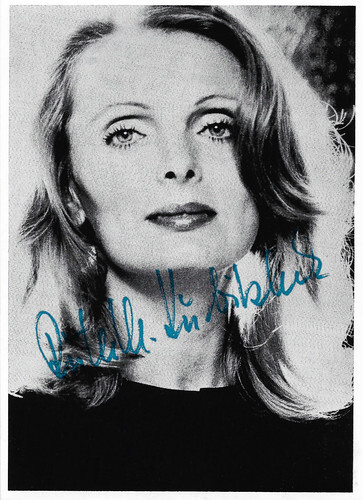
West German autograph card.
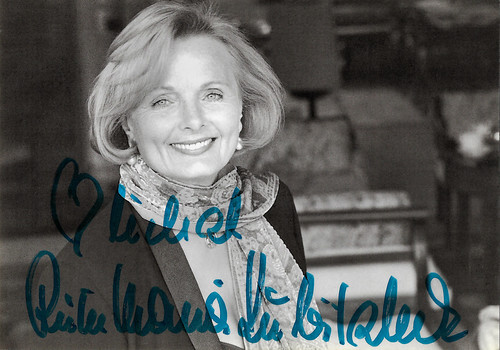
West German postcard by Franz Josef Rüdel, Filmpostkartenverlag, Hamburg. Photo: Roberto Ferrantini, Roma.
Sources: Wikipedia (German, Dutch and English) and .

West German postcard by Rüdel-Verlag, Hamburg, no. 4731. Photo: Gloria. Ruth-Maria Kubitschek in Mitsommernacht/Midsummer Night (Paul May, 1967).

West German autograph card.
The first East German/Polish Science Fiction film in colour
Ruth-Maria Kubitschek was born in 1931 in Komotau, Czechoslovakia (now Chomutov, Czech Republic). She was one of five sisters. Her father was in charge of a coal mining operation in northern Bohemia in the Czech Republic until the end of the Second World War. After the end of World War II, the family fled to Köthen (Saxony-Anhalt). Kubitschek grew up in the GDR.
Against her parents' wishes, she decided to become an actor. After high school, she went to the University for Theatre and Music (Hochschule für Theater und Musik) in Halle and then to the German Theatre Institute (Deutsches Theater-Institut) in Weimar. She made her stage debut in Bertold Brecht's 'Herr Puntila und sein Knecht Matti'. Then, she had engagements at the Maxim-Gorki-Bühne Schwerin, the Theater der Freundschaft Berlin, and the Staatstheater Schwerin.
Already a noted star on the East German stage, she began her screen career with DEFA. In 1953, Kubitschek made her film debut in the comedy Jacke wie Hose/Swings or Roundabouts (Eduard Kubat, 1953) in the role of Eva. She also had supporting parts in the East German films Thomas Muentzer (Martin Hellberg, 1956), about the life of the 16th-century Protestant theologian and peasant leader Thomas Muentzer, and Der Fackelträger (Johannes Knittel, 1957).
She also acted in Der schweigende Stern/Milcząca Gwiazda/The Silent Star (Kurt Maetzig, 1960), starring Günther Simon and Yoko Tani . The first East German/Polish Science Fiction film in colour was based on the novel 'The Astronauts' by Polish Sci-Fi writer Stanisław Lem. In 1959, Kubitschek stayed in West Germany after a theatre performance. There she initially also performed various theatre performances.
She also appeared in a few West German films such as the mystery Er kann's nicht lassen/He Can't Stop Doing It (Axel von Ambesser, 1962) starring Heinz Rühmann . It was loosely based on the Father Brown stories by G. K. Chesterton. Rühmann reprised his role from the film The Black Sheep (1960). Other films were the comedy-drama Sperrbezirk (Will Tremper, 1966) starring Harald Leipnitz, the Norway-situated Heimatfilm Mitsommernacht/Midsummer Night (Paul May, 1967) with American TV actor Robert Fuller, and the Guy de Maupassant adaptation Madame und ihre Nichte/Madame and Her Niece (Eberhard Schröder, 1969) with Edwige Fenech and Fred Williams.

East German postcard by VEB Progress Film-Vertrieb, Berlin, no. 305, 1957. Photo: Albert Kolbe / DEFA.

West German autograph card by TURA.
The artistic highlights of her career
Ruth-Maria Kubitschek gained great popularity through television. First, she appeared in the Francis Durbridge thriller Melissa (Paul May, 1966). She starred alongside Ralf Wolter in the 13-part series Ein Fall für Titus Bunge/A Case for Titus Bunge (Günter Gräwert, 1967). She had other well-known television roles in Tatort: Blechschaden/Crime Scene: Fender Bender (Wolfgang Petersen, 1971) with Klaus Schwarzkopf and Götz George , Der Kommissar: Blinde Spiele/The Commissioner: Blinde Spiele (Theodor Grädler, 1972), and Das Erbe der Guldenburgs/The Legacy of the Guldenburgs (Gero Erhardt, Jürgen Goslar, 1986-1989).
She later rated two series directed by Helmut Dietl, Monaco Franze – Der ewige Stenz/ Monaco Franz - the Eternal Dandy (Helmut Dietl, 1983) with Helmut Fischer, Kir Royal (Helmut Dietl, 1986) with Franz Xaver Kroetz, as the artistic highlights of her career. Kubitschek appeared alongside Mathieu Carrière as Countess Sophie von Hohenstein in the TV series Schloß Hohenstein/Hohenstein Castle (1992-1995) and played the successful businesswoman Marlies Holbein in Freunde fürs Leben/Friends for life (1992-2001).
In the cinema, Kubitscheck showed her comedic talent alongside Dieter Hallervorden in the comedy of mistaken identity Didi - Der Doppelgänger/Non-Stop Trouble with My Double (Reinhard Schwabenitzky, 1984) in the female leading role of Heidi Immer. In 1992, she took on the role of Frau von Lodenwald in the comedy Otto - Der Liebesfilm/Otto: The Love Film (Otto Waalkes, Bernd Eilert, 1992), Otto Waalkes ' fourth feature film.
In addition to her stage and film work, Kubitschek worked as a dubbing actress and lent her voice to Danielle Darrieux for 8 femmes/8 Women (François Ozon, 2002), Daliah Lavi for Old Shatterhand (Hugo Fregonese, 1964) and Delphine Seyrig for Muriel ou Le temps d’un retour/Muriel or the Time of Return (Alain Resnais, 1963). Kubitschek was also the author of novels and esoteric books. She was a strong supporter of meditation and believed in elfins and ghosts. In 1953 she married opera director and writer Götz Friedrich. They had a son, Alexander (1957) and divorced in 1962 or 1963. From 1976 until he died in 2016, she was the companion of TV producer Wolfgang Rademann. Since 2013, she was a Swiss citizen.
Wolf Gremm directed her in Im Fluss des Lebens/Journey of Life (Wolf Gremm, 2011), based on Kubitschek's novella of the same name. She played the leading role of writer Agnes Berg. In 2013, she shot her last film, the comedy-road movie Frau Ella (Markus Goller, 2013) opposite Matthias Schweighöfer. For her title role, she received the Jupiter Film Award. That year, she also received the Bavarian Television Prize, an honorary award from the Bavarian Prime Minister for her life's work. In 2014, she withdrew from the public eye, but still exhibited her paintings. Ruth-Maria Kubitschek died in 2024 in Ascona at the Lago Maggiore in Switzerland.

West German autograph card.

West German postcard by Franz Josef Rüdel, Filmpostkartenverlag, Hamburg. Photo: Roberto Ferrantini, Roma.
Sources: Wikipedia (German, Dutch and English) and .
Published on June 17, 2024 22:00
June 16, 2024
Directed by Richard Eichberg
German film director and producer Richard Eichberg (1888-1952) directed 87 films between 1915 and 1949 and produced 77 films between 1915 and 1950. In the 1920s he made a string of popular comedies with such stars as Lee Parry and Lilian Harvey. Eichberg traversed a consistent middle road between artistry and more prosaic mainstream fare. He had a special fondness for setting his films in exotic locales.
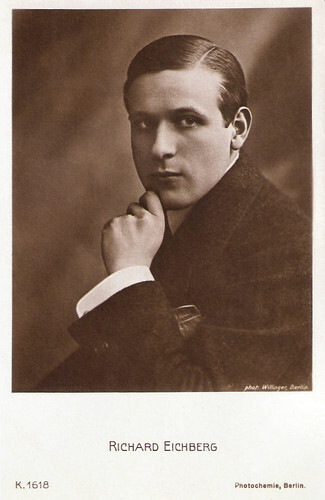
German postcard by Photochemie, Berlin, no. K. 1618. Photo: Willinger, Berlin.
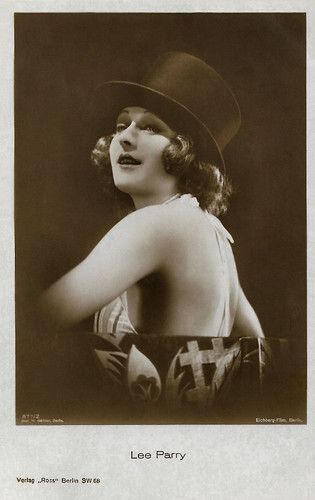
German postcard by Ross Verlag, Berlin, no. 877/2, 1925-1926. Photo: Heinrich Gärtner, Berlin / Richard Eichberg-Film, Berlin. In 1925, Lee Parry starred in four films, produced by Richard Eichberg-Film with cinematography by Heinrich Gärtner: Die Motorbraut/The Motor Bride (Richard Eichberg, 1925), Luxusweibchen/Luxury Wife (Erich Schönfelder, 1925), Die Frau mit dem Etwas/The woman With Something (Erich Schönfelder, 1925), and Der Liebeskäfig/The Love Cage (Richard Eichberg, Erich Schönfelder, 1925).
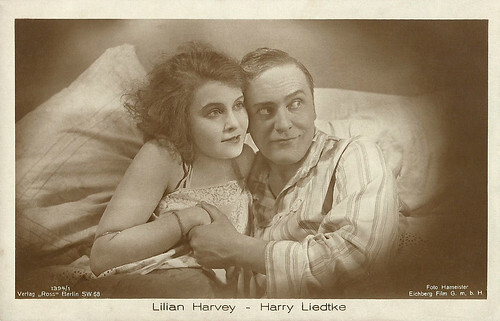
German postcard by Ross Verlag, no. 1394/1, 1927-1928. Photo: Hameister / Eichberg Film G.m.b.H. Lilian Harvey and Harry Liedtke in Liebe und Trompetenblasen/Love and Trumpets (Richard Eichberg, 1925). Collection: Didier Hanson.
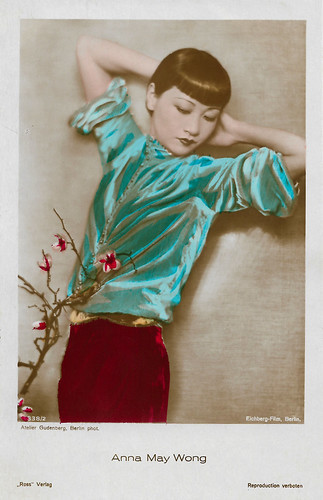
German postcard by Ross Verlag, no. 4338/2, 1929-1930. Photo: Atelier Gudenberg, Berlin / Eichberg-Film, Berlin. Anna May Wong . Collection: Geoffrey Donaldson Institute.
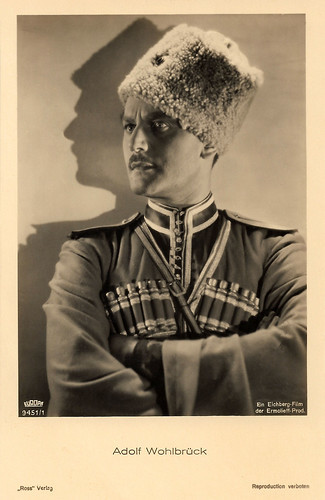
German postcard by Ross Verlag, no. 9451/1, 1935-1936. Photo: Europa / Eichberg Film / Les productions J.N. Ermoliev. Adolf Wohlbrück as Michel in Michel Strogoff (Richard Eichberg, 1936).
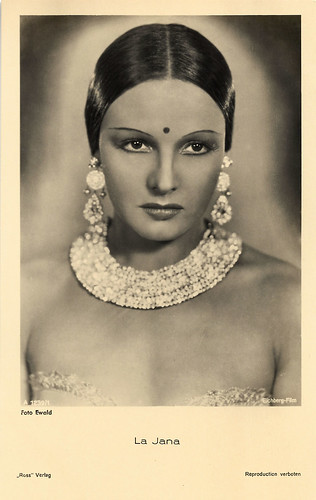
German postcard by Ross Verlag, no. A 1239/1, 1937-1938. Photo: Ewald / Eichberg-Film. La Jana in Das indische Grabmal/The Indian Tomb (Richard Eichberg, 1938).
Frivolous and light film comedies
Richard Albert Eichberg was born in 1888 in Berlin. After grammar school, he turned to acting. In 1906, he got his first engagement in Schaffhausen. In 1907 followed an engagement at the Residenz-Theater in Berlin. From 1909 to 1912, he travelled to South America with a touring company.
Around 1907, Eichberg made his first film appearances in ‘Tonbilder’ (early sound shorts). In 1912 and 1913, he acted in Im Banne der Schuld (Hans Oberländer 1912) and several other dramas at Messter's Projection. Subsequently, he worked with Alfred Duskes and Charles Decroix and for the Eiko studio. After the beginning of the First World War, he switched to film direction and production. From 1915 on, he directed and co-produced several short silent films. His debut was the silent melodrama Strohfeuer/Summer Lightning (1915) situated in the Alps. The success of his first films enabled him to found Eichberg-Film as part of Central-Film-Vertriebs-GmbH. He produced mostly crime melodramas. According to Hans Michael Bock at Filmportal , Eichberg offered "well thought-out action cinema based on technical solidity, turbulence, exoticism and sensations."
He directed Ellen Richter in Bacchanal des Todes (1917), of which a beautiful print was found at the Netherlands Filmmuseum in the early 1990s. His productions were the work of well-rehearsed teams, which initially included Ellen Richter as the female star. Then followed Leontine Kühnberg in such films as Die goldene Mumie (1918) and, from 1919, Eichberg's wife Lee Parry (actually Mathilde Benz) became the star of his films. Eichberg directed Parry in her biggest box-office hit, Monna Vanna (1922), one of his more lavish projects. Another success was Die Motorbraut/The Motorist Bride (1924) with Lee Parry and Hans Mierendorff . The film is also notable for Lilian Harvey as a stunt double for Parry during the mountaineering scenes shot in Switzerland. Harvey quickly graduated to become the top star of Richard Eichberg's production company.
In 1921, Eichberg put his company on its own feet with the help of Münchner Lichtspielkunst AG (Emelka Group). At the beginning of the 1920s, he devoted himself increasingly to film comedies and knew how to appeal to the public's taste, which critics both appreciated and criticised. After he separated from Lee Parry , he introduced Lilian Harvey to the screen. First, she appeared in Leidenschaft. Die Liebschaften der Hella von Gilsa/Passion (1925), followed by her breakthrough film Liebe und Trompetenblasen/Love and Trumpets (1925) with Harry Liedtke and the comedies Die Kleine vom Bummel/The Girl on the Road (1925) with Ernst Winar and Prinzessin Trulala/Princess Trulala (1926) with Dina Gralla .
Then Eichberg coupled Harvey with Willy Fritsch for the first time in Die keusche Susanne/Chaste Susanne (1926). The film premiered at the UFA-Palast am Zoo and was a smash hit on its release. Soon, Eichberg lost Harvey and Fritsch to the big Ufa company, where they would become a beloved couple of late silent and early sound cinema in Germany. Eichberg kept his focus on frivolous and light film comedies, which highly pleased audiences but not the critics. Examples are Durchlaucht Radieschen (1927) with Xenia Desni and Werner Fütterer , and Der Fürst von Pappenheim/The Prince of Pappenheim (1927) with Curt Bois and Mona Maris . In the following years, he discovered Anna May Wong , Martha Eggerth and Kitty Jantzen, who became his second wife.

German postcard by Photochemie, Berlin, no. K. 2637. Photo: Eichberg-Film. Bruno Decarli and Leontine Kühnberg in Uns aber ist gegeben auf keiner Stätte zu ruhen (1918). The film title Uns aber ist gegeben auf keiner Stätte zu ruhen (But to us, it is given to rest on no place) is absent on IMDb and Filmportal . From the six films that Richard Eichberg directed with Leontine Kühnberg in 1918, all for his own company Eichberg-Film, a probable option is Im Zeichen der Schuld (Eichberg, 1918), aka Aus dem Leben eines Vorbestraften (From the life of a convicted man). Filmportal lists this as the only film in which Decarli and Kühnberg played together in an Eichberg film. The plot deals with a man (Decarli) who, convicted of forging his boss's name, kills the bank director and assumes his identity. However, the Early German Film Database does list the film Uns aber ist gegeben, auf keiner Stätte zu ruhen as a separate film (1918), directed by Eichberg, and starring Decarli and Kühnberg. So perhaps, this is a separate film after all.
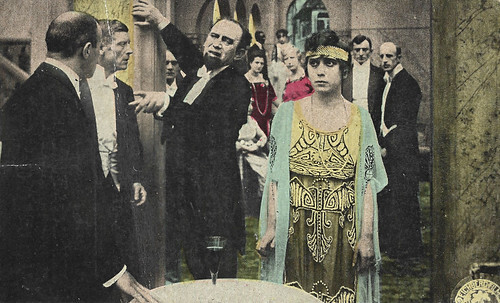
Spanish collector card (cromo) by Chocolat Imperiale, card no. 3 of 6. Photo: Distr. J. Verdaguer, Barcelona / Eichberg-Film. Leontine Kühnberg and Ferdinand Bonn in Die goldene Mumie (Richard Eichberg, 1918).
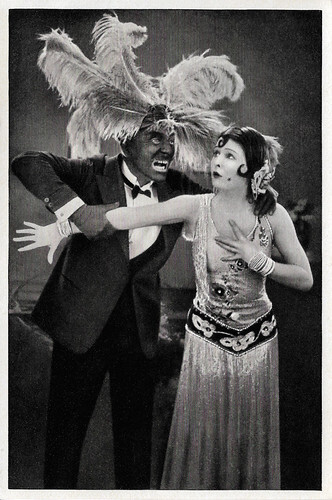
German collectors card by Ross Verlag in the series Vom Werden deutscher Filmkunst - Der Stumme Film, picture no. 123, group 43. Photo: Eichberg-Film. Lilian Harvey and Hans Junkermann in Die tolle Lola/Fabulous Lola (Richard Eichberg, 1927).
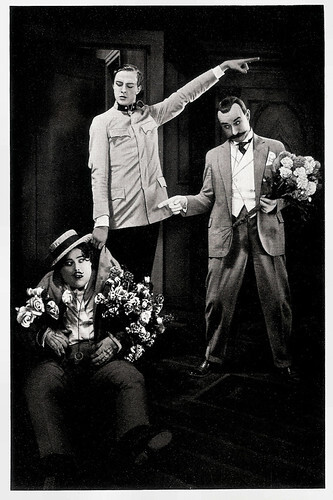
German collectors card by Ross Verlag in the series Vom Werden deutscher Filmkunst - Der Stumme Film, picture no. 199, group 43. Photo: Eichberg-Film. Werner Fuetterer and Hans Junkermann in Durchlaucht Radieschen/Highness Radish (Richard Eichberg, 1927).
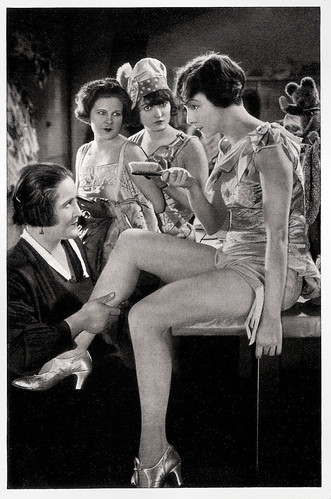
German collectors card by Ross Verlag in the series Vom Werden deutscher Filmkunst - Der Stumme Film, picture no. 184, group 43. Photo: Ufa. Dina Gralla in Das Girl von der Revue/The Girl from the Revue (Richard Eichberg, 1928).
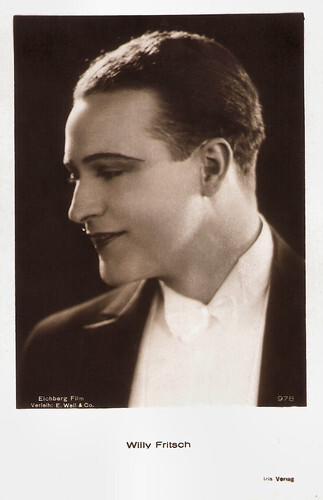
Austrian postcard by Iris Verlag, nr. 978. Photo: Eichberg Film/ Verleih E. Welt & Co. Willy Fritsch in Die keusche Susanne/Chaste Susanne (Richard Eichberg, 1926), one of the rare Eichberg productions in which Fritsch played.
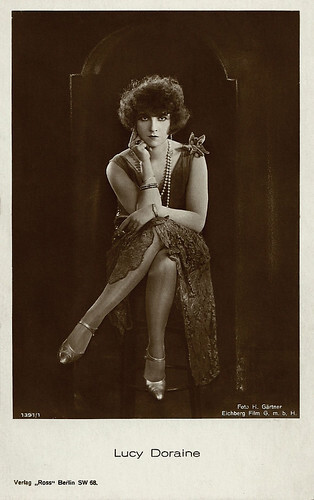
German postcard by Ross Verlag, no. 1391/1, 1927-1928. Photo: H. Gärtner / Eichberg-Film. Lucy Doraine in Der Prinz und die Tänzerin/The Prince and the Dancer (Richard Eichberg, 1926).
A lavishly produced jealousy drama
In 1928, Richard Eichberg went to London to produce sound films at the Elstree Studios of British International Pictures (BIP) as one of the first German directors. The most successful of these productions was the crime film Der Greifer/The Copper (1930) with Hans Albers as a Scotland Yard detective. It is the German-language version of the British film Night Birds, by Eichberg but with an English-speaking cast. Der Greifer was a success in Germany, launching Albers as a major star. In 1958, the film was remade with Albers reprising his role.
After the National Socialists came to power in 1933, Eichberg reduced his productivity and worked mainly abroad. He made three Franco-German co-productions at the Paramount studios in Paris-Joinville. These were multiversion films with French and German casts, such as the historical adventure film Michel Strogoff, le courier du tzar/Der Kurier des Zaren (1935-1936), in co-direction with Jacques de Baroncelli. It was an adaptation of the 1876 novel 'Michael Strogoff' by Jules Verne . Adolf Wohlbrück a.k.a. Anton Walbrook starred in the title role in both the French and the German versions.
In 1937 Eichberg shot in India and Woltersdorf the second adaptation of Thea von Harbou’s script of Der Tiger von Eschnapur/The Tiger of Eschnapur and the second part Das Indische Grabmal/The Indian Tomb, starring exotic dancer La Jana , Frits van Dongen a.k.a. Philip Dorn and Kitty Jantzen. Both parts were released in 1937 and were significant box-office triumphs. I.S. Mowis at IMDb : "Thanks to numerous re-runs on television, Eichberg's version is by far the best known. At the least, it is vastly superior to Fritz Lang 's kitschy 1958 re-visitation with its doctored 'happy ending' (Lang himself declared this one of his notable failures)." Eichberg also shot the French versions of these two films, now with Alice Field and Max Michel. Back in Germany, state pressure became increasingly intense. Reportedly in spring 1939, Eichberg was given the choice of either selling his Swiss villa property and bringing the foreign currency into the Reich or no longer being allowed to direct in Germany. Eichberg then moved to the USA, where he was employed on various stages in New York, for example in the summer of 1942 in the Broadway production of 'The New Moon' and he was the co-financier of Franz Lehar's 'The Merry Widow' at Carnegie Hall. His later move to Hollywood did not bring any new employment for him.
In 1949, he returned to Germany, where his Indian films were being shown again to great acclaim. He settled in Munich and attempted to build on his earlier successes with the lavishly produced jealousy drama Die Reise nach Marrakesch/The Trip to Marrakech (1949) with Luise Ullrich , Paul Dahlke , Karl Ludwig Diehl and Grethe Weiser . Eichberg led a filming expedition to Morocco for location shooting. The final budget amounted to around one and a half million Deutschmarks. The film premiered in Munich on 21 December 1949, aiming for the lucrative Christmas-time release market. It was received with general hostility from critics. While the film was in the same tradition as Eichberg's earlier films, with their exotic settings, it drew more notice for its underlying lesbian theme, which culminates in one female character shooting another dead. The film was a huge flop and ended Eichberg's directing career.
Eichberg produced one more film, the comedy Skandal in der Botschaft/Scandal at the Embassy (Erik Ode, 1950) starring Viktor de Kowa. He then devoted himself to the business of the production company in Munich. It was managed by his son from his second marriage. Richard Eichberg died in Munich, West Germany, in 1952. His grave is in the old section of the Waldfriedhof cemetery in Munich.
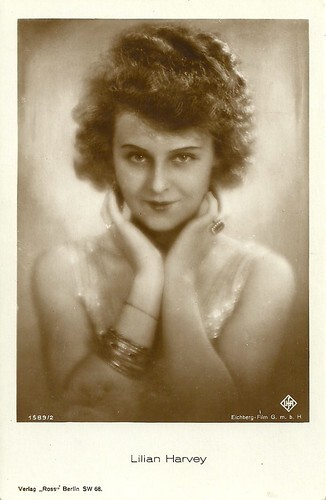
German postcard by Ross Verlag, no. 1589/2, 1927-1928. Photo: Eichberg-Film GmbH. / Ufa. Lilian Harvey acted e.g. in the Eichberg production Die keusche Susanne/Chaste Susanne (Richard Eichberg, 1926).
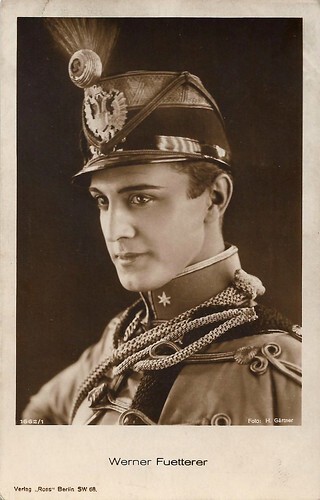
German postcard by Ross Verlag, no. 1662/1, 1927-1928. Photo: H. Gärtner. Werner Fuetterer in Durchlaucht Radieschen (Richard Eichberg, 1926-1927).
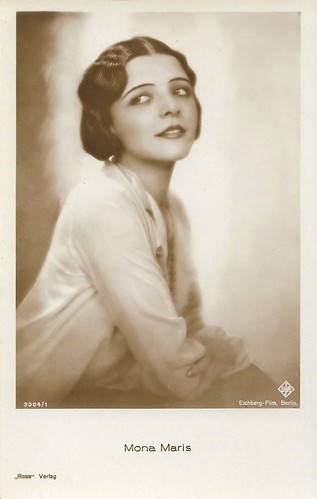
German postcard by Ross Verlag, no. 3004/1, 1927-1928. Photo: Eichberg-Film, Berlin. Ufa. In 1927-1928, Mona Maris acted in several films of Eichberg Film, including Der Fürst von Pappenheim (Richard Eichberg, 1927) distributed by Ufa.

German postcard by Ross Verlag, no. 3870/1, 1928-1929. Photo: Jacobi, Berlin / Eichberg-Film. Fee Malten .
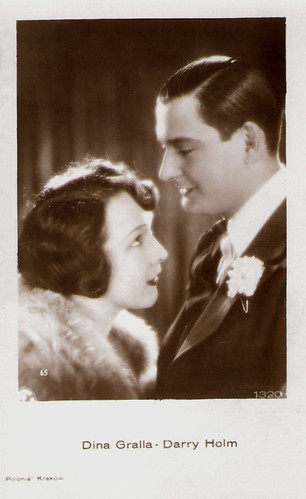
Polish postcard by Polonia, Krakow, no. 1320. Dina Gralla and Harry Halm in Wer wird denn weinen, wenn man auseinandergeht?/No Use Crying If Your Sweetheart Goes Away (Richard Eichberg, 1929).
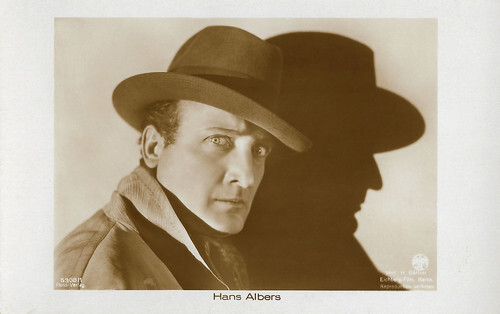
German postcard by Ross Verlag, no. 5308/1. Photo: H. Gärtner / SF / Eichberg-Film, Berlin. Hans Albers in Der Greifer/The Snatcher (Richard Eichberg, 1930).
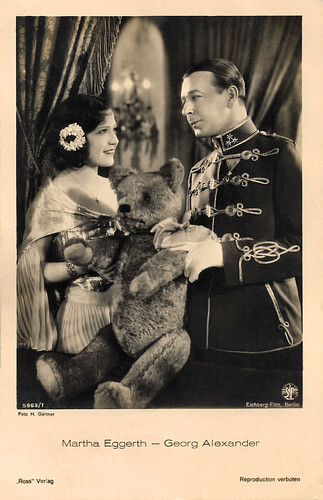
German postcard by Ross Verlag, no. 5969/1, 1930-1931. Photo: H. Gärner / Eichberg-Film / SF. Marta Eggerth and Georg Alexander in Die Bräutigamswitwe/The widow of the groom (Richard Eichberg, 1931).
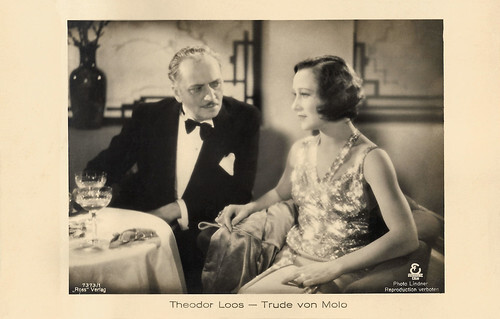
German postcard by Ross Verlag, no. 7373/1, 1932-1933. Photo: Lindner / Eichberg-Film. Theodor Loos and Trude von Molo in Die unsichtbare Front/The Invisible Front (Richard Eichberg, 1933).
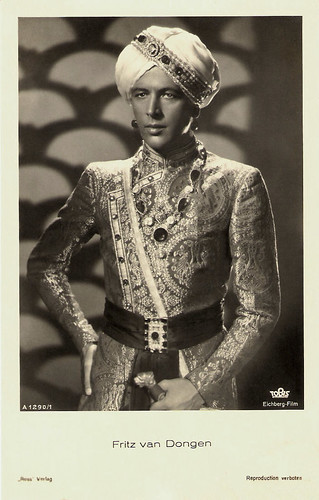
German postcard by Ross Verlag, Berlin, no. A 1290, 1937-1938. Photo: Tobis / Eichberg-Film. Frits van Dongen in Der Tiger von Eschnapur/The Tiger of Eschnapur (Richard Eichberg, 1938).
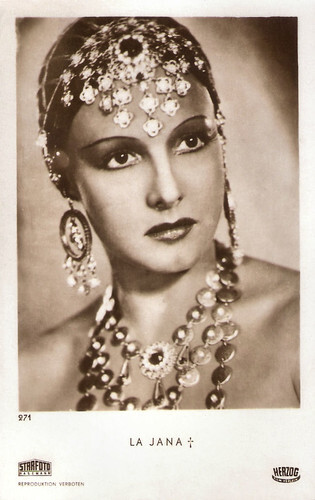
German card by Starfoto Hasemann, no. 271. Photo: Herzog Filmverleih. La Jana in Der Tiger von Eschnapur/The Tiger of Eschnapur (Richard Eichberg, 1938). The card was made for a re-issue of the film after the death of La Jana.
Sources: Hans-Michael Bock (Filmportal - German), (IMDb), Wikipedia (German, Italian and English) and .

German postcard by Photochemie, Berlin, no. K. 1618. Photo: Willinger, Berlin.

German postcard by Ross Verlag, Berlin, no. 877/2, 1925-1926. Photo: Heinrich Gärtner, Berlin / Richard Eichberg-Film, Berlin. In 1925, Lee Parry starred in four films, produced by Richard Eichberg-Film with cinematography by Heinrich Gärtner: Die Motorbraut/The Motor Bride (Richard Eichberg, 1925), Luxusweibchen/Luxury Wife (Erich Schönfelder, 1925), Die Frau mit dem Etwas/The woman With Something (Erich Schönfelder, 1925), and Der Liebeskäfig/The Love Cage (Richard Eichberg, Erich Schönfelder, 1925).

German postcard by Ross Verlag, no. 1394/1, 1927-1928. Photo: Hameister / Eichberg Film G.m.b.H. Lilian Harvey and Harry Liedtke in Liebe und Trompetenblasen/Love and Trumpets (Richard Eichberg, 1925). Collection: Didier Hanson.

German postcard by Ross Verlag, no. 4338/2, 1929-1930. Photo: Atelier Gudenberg, Berlin / Eichberg-Film, Berlin. Anna May Wong . Collection: Geoffrey Donaldson Institute.

German postcard by Ross Verlag, no. 9451/1, 1935-1936. Photo: Europa / Eichberg Film / Les productions J.N. Ermoliev. Adolf Wohlbrück as Michel in Michel Strogoff (Richard Eichberg, 1936).

German postcard by Ross Verlag, no. A 1239/1, 1937-1938. Photo: Ewald / Eichberg-Film. La Jana in Das indische Grabmal/The Indian Tomb (Richard Eichberg, 1938).
Frivolous and light film comedies
Richard Albert Eichberg was born in 1888 in Berlin. After grammar school, he turned to acting. In 1906, he got his first engagement in Schaffhausen. In 1907 followed an engagement at the Residenz-Theater in Berlin. From 1909 to 1912, he travelled to South America with a touring company.
Around 1907, Eichberg made his first film appearances in ‘Tonbilder’ (early sound shorts). In 1912 and 1913, he acted in Im Banne der Schuld (Hans Oberländer 1912) and several other dramas at Messter's Projection. Subsequently, he worked with Alfred Duskes and Charles Decroix and for the Eiko studio. After the beginning of the First World War, he switched to film direction and production. From 1915 on, he directed and co-produced several short silent films. His debut was the silent melodrama Strohfeuer/Summer Lightning (1915) situated in the Alps. The success of his first films enabled him to found Eichberg-Film as part of Central-Film-Vertriebs-GmbH. He produced mostly crime melodramas. According to Hans Michael Bock at Filmportal , Eichberg offered "well thought-out action cinema based on technical solidity, turbulence, exoticism and sensations."
He directed Ellen Richter in Bacchanal des Todes (1917), of which a beautiful print was found at the Netherlands Filmmuseum in the early 1990s. His productions were the work of well-rehearsed teams, which initially included Ellen Richter as the female star. Then followed Leontine Kühnberg in such films as Die goldene Mumie (1918) and, from 1919, Eichberg's wife Lee Parry (actually Mathilde Benz) became the star of his films. Eichberg directed Parry in her biggest box-office hit, Monna Vanna (1922), one of his more lavish projects. Another success was Die Motorbraut/The Motorist Bride (1924) with Lee Parry and Hans Mierendorff . The film is also notable for Lilian Harvey as a stunt double for Parry during the mountaineering scenes shot in Switzerland. Harvey quickly graduated to become the top star of Richard Eichberg's production company.
In 1921, Eichberg put his company on its own feet with the help of Münchner Lichtspielkunst AG (Emelka Group). At the beginning of the 1920s, he devoted himself increasingly to film comedies and knew how to appeal to the public's taste, which critics both appreciated and criticised. After he separated from Lee Parry , he introduced Lilian Harvey to the screen. First, she appeared in Leidenschaft. Die Liebschaften der Hella von Gilsa/Passion (1925), followed by her breakthrough film Liebe und Trompetenblasen/Love and Trumpets (1925) with Harry Liedtke and the comedies Die Kleine vom Bummel/The Girl on the Road (1925) with Ernst Winar and Prinzessin Trulala/Princess Trulala (1926) with Dina Gralla .
Then Eichberg coupled Harvey with Willy Fritsch for the first time in Die keusche Susanne/Chaste Susanne (1926). The film premiered at the UFA-Palast am Zoo and was a smash hit on its release. Soon, Eichberg lost Harvey and Fritsch to the big Ufa company, where they would become a beloved couple of late silent and early sound cinema in Germany. Eichberg kept his focus on frivolous and light film comedies, which highly pleased audiences but not the critics. Examples are Durchlaucht Radieschen (1927) with Xenia Desni and Werner Fütterer , and Der Fürst von Pappenheim/The Prince of Pappenheim (1927) with Curt Bois and Mona Maris . In the following years, he discovered Anna May Wong , Martha Eggerth and Kitty Jantzen, who became his second wife.

German postcard by Photochemie, Berlin, no. K. 2637. Photo: Eichberg-Film. Bruno Decarli and Leontine Kühnberg in Uns aber ist gegeben auf keiner Stätte zu ruhen (1918). The film title Uns aber ist gegeben auf keiner Stätte zu ruhen (But to us, it is given to rest on no place) is absent on IMDb and Filmportal . From the six films that Richard Eichberg directed with Leontine Kühnberg in 1918, all for his own company Eichberg-Film, a probable option is Im Zeichen der Schuld (Eichberg, 1918), aka Aus dem Leben eines Vorbestraften (From the life of a convicted man). Filmportal lists this as the only film in which Decarli and Kühnberg played together in an Eichberg film. The plot deals with a man (Decarli) who, convicted of forging his boss's name, kills the bank director and assumes his identity. However, the Early German Film Database does list the film Uns aber ist gegeben, auf keiner Stätte zu ruhen as a separate film (1918), directed by Eichberg, and starring Decarli and Kühnberg. So perhaps, this is a separate film after all.

Spanish collector card (cromo) by Chocolat Imperiale, card no. 3 of 6. Photo: Distr. J. Verdaguer, Barcelona / Eichberg-Film. Leontine Kühnberg and Ferdinand Bonn in Die goldene Mumie (Richard Eichberg, 1918).

German collectors card by Ross Verlag in the series Vom Werden deutscher Filmkunst - Der Stumme Film, picture no. 123, group 43. Photo: Eichberg-Film. Lilian Harvey and Hans Junkermann in Die tolle Lola/Fabulous Lola (Richard Eichberg, 1927).

German collectors card by Ross Verlag in the series Vom Werden deutscher Filmkunst - Der Stumme Film, picture no. 199, group 43. Photo: Eichberg-Film. Werner Fuetterer and Hans Junkermann in Durchlaucht Radieschen/Highness Radish (Richard Eichberg, 1927).

German collectors card by Ross Verlag in the series Vom Werden deutscher Filmkunst - Der Stumme Film, picture no. 184, group 43. Photo: Ufa. Dina Gralla in Das Girl von der Revue/The Girl from the Revue (Richard Eichberg, 1928).

Austrian postcard by Iris Verlag, nr. 978. Photo: Eichberg Film/ Verleih E. Welt & Co. Willy Fritsch in Die keusche Susanne/Chaste Susanne (Richard Eichberg, 1926), one of the rare Eichberg productions in which Fritsch played.

German postcard by Ross Verlag, no. 1391/1, 1927-1928. Photo: H. Gärtner / Eichberg-Film. Lucy Doraine in Der Prinz und die Tänzerin/The Prince and the Dancer (Richard Eichberg, 1926).
A lavishly produced jealousy drama
In 1928, Richard Eichberg went to London to produce sound films at the Elstree Studios of British International Pictures (BIP) as one of the first German directors. The most successful of these productions was the crime film Der Greifer/The Copper (1930) with Hans Albers as a Scotland Yard detective. It is the German-language version of the British film Night Birds, by Eichberg but with an English-speaking cast. Der Greifer was a success in Germany, launching Albers as a major star. In 1958, the film was remade with Albers reprising his role.
After the National Socialists came to power in 1933, Eichberg reduced his productivity and worked mainly abroad. He made three Franco-German co-productions at the Paramount studios in Paris-Joinville. These were multiversion films with French and German casts, such as the historical adventure film Michel Strogoff, le courier du tzar/Der Kurier des Zaren (1935-1936), in co-direction with Jacques de Baroncelli. It was an adaptation of the 1876 novel 'Michael Strogoff' by Jules Verne . Adolf Wohlbrück a.k.a. Anton Walbrook starred in the title role in both the French and the German versions.
In 1937 Eichberg shot in India and Woltersdorf the second adaptation of Thea von Harbou’s script of Der Tiger von Eschnapur/The Tiger of Eschnapur and the second part Das Indische Grabmal/The Indian Tomb, starring exotic dancer La Jana , Frits van Dongen a.k.a. Philip Dorn and Kitty Jantzen. Both parts were released in 1937 and were significant box-office triumphs. I.S. Mowis at IMDb : "Thanks to numerous re-runs on television, Eichberg's version is by far the best known. At the least, it is vastly superior to Fritz Lang 's kitschy 1958 re-visitation with its doctored 'happy ending' (Lang himself declared this one of his notable failures)." Eichberg also shot the French versions of these two films, now with Alice Field and Max Michel. Back in Germany, state pressure became increasingly intense. Reportedly in spring 1939, Eichberg was given the choice of either selling his Swiss villa property and bringing the foreign currency into the Reich or no longer being allowed to direct in Germany. Eichberg then moved to the USA, where he was employed on various stages in New York, for example in the summer of 1942 in the Broadway production of 'The New Moon' and he was the co-financier of Franz Lehar's 'The Merry Widow' at Carnegie Hall. His later move to Hollywood did not bring any new employment for him.
In 1949, he returned to Germany, where his Indian films were being shown again to great acclaim. He settled in Munich and attempted to build on his earlier successes with the lavishly produced jealousy drama Die Reise nach Marrakesch/The Trip to Marrakech (1949) with Luise Ullrich , Paul Dahlke , Karl Ludwig Diehl and Grethe Weiser . Eichberg led a filming expedition to Morocco for location shooting. The final budget amounted to around one and a half million Deutschmarks. The film premiered in Munich on 21 December 1949, aiming for the lucrative Christmas-time release market. It was received with general hostility from critics. While the film was in the same tradition as Eichberg's earlier films, with their exotic settings, it drew more notice for its underlying lesbian theme, which culminates in one female character shooting another dead. The film was a huge flop and ended Eichberg's directing career.
Eichberg produced one more film, the comedy Skandal in der Botschaft/Scandal at the Embassy (Erik Ode, 1950) starring Viktor de Kowa. He then devoted himself to the business of the production company in Munich. It was managed by his son from his second marriage. Richard Eichberg died in Munich, West Germany, in 1952. His grave is in the old section of the Waldfriedhof cemetery in Munich.

German postcard by Ross Verlag, no. 1589/2, 1927-1928. Photo: Eichberg-Film GmbH. / Ufa. Lilian Harvey acted e.g. in the Eichberg production Die keusche Susanne/Chaste Susanne (Richard Eichberg, 1926).

German postcard by Ross Verlag, no. 1662/1, 1927-1928. Photo: H. Gärtner. Werner Fuetterer in Durchlaucht Radieschen (Richard Eichberg, 1926-1927).

German postcard by Ross Verlag, no. 3004/1, 1927-1928. Photo: Eichberg-Film, Berlin. Ufa. In 1927-1928, Mona Maris acted in several films of Eichberg Film, including Der Fürst von Pappenheim (Richard Eichberg, 1927) distributed by Ufa.

German postcard by Ross Verlag, no. 3870/1, 1928-1929. Photo: Jacobi, Berlin / Eichberg-Film. Fee Malten .

Polish postcard by Polonia, Krakow, no. 1320. Dina Gralla and Harry Halm in Wer wird denn weinen, wenn man auseinandergeht?/No Use Crying If Your Sweetheart Goes Away (Richard Eichberg, 1929).

German postcard by Ross Verlag, no. 5308/1. Photo: H. Gärtner / SF / Eichberg-Film, Berlin. Hans Albers in Der Greifer/The Snatcher (Richard Eichberg, 1930).

German postcard by Ross Verlag, no. 5969/1, 1930-1931. Photo: H. Gärner / Eichberg-Film / SF. Marta Eggerth and Georg Alexander in Die Bräutigamswitwe/The widow of the groom (Richard Eichberg, 1931).

German postcard by Ross Verlag, no. 7373/1, 1932-1933. Photo: Lindner / Eichberg-Film. Theodor Loos and Trude von Molo in Die unsichtbare Front/The Invisible Front (Richard Eichberg, 1933).

German postcard by Ross Verlag, Berlin, no. A 1290, 1937-1938. Photo: Tobis / Eichberg-Film. Frits van Dongen in Der Tiger von Eschnapur/The Tiger of Eschnapur (Richard Eichberg, 1938).

German card by Starfoto Hasemann, no. 271. Photo: Herzog Filmverleih. La Jana in Der Tiger von Eschnapur/The Tiger of Eschnapur (Richard Eichberg, 1938). The card was made for a re-issue of the film after the death of La Jana.
Sources: Hans-Michael Bock (Filmportal - German), (IMDb), Wikipedia (German, Italian and English) and .
Published on June 16, 2024 22:00
June 15, 2024
Marceline Day
American actress Marceline Day (1908-2000) achieved stardom in the mid-1920s, appearing opposite such stars as John Barrymore and Lon Chaney. Adept at comedy, she also starred with top comedians like Buster Keaton and Harry Langdon.
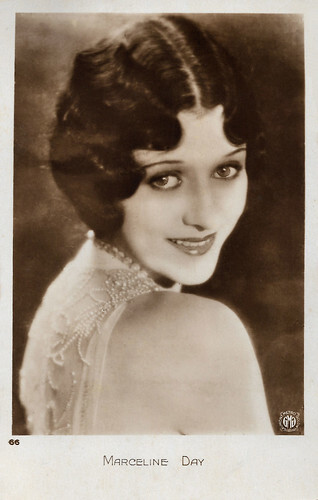
French postcard by Cinémagazine-Édition, Paris, no. 66. Photo: Metro Goldwyn Mayer.
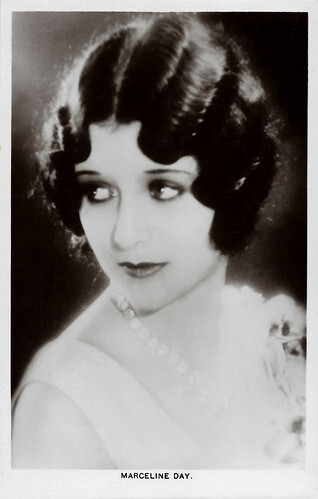
British postcard in the Picturegoer Series, London, no. 307a.
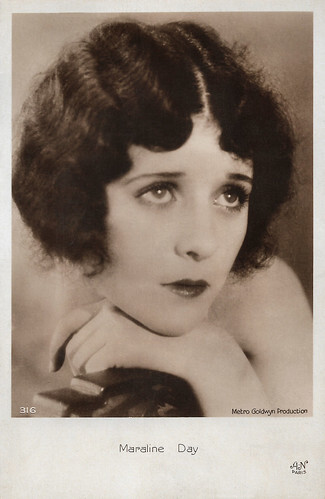
French postcard by A.N., Paris, no. 316. Photo: Metro Goldwyn Mayer.
The sweetheart of some of the top cowboy stars
Marceline Day was born as Marceline Newlin in 1908 in Colorado Springs, Colorado. She was the daughter of Frank and Irene Newlin and the younger sister of actress Alice Day. She was raised in Salt Lake City. She attended Venice High School.
In 1923, she followed her older sister into the film business when Alice became a bathing beauty in one and two-reel comedies for producer Mack Sennett of Keystone Studios. Sennett cast Marceline alongside Harry Langdon in such short comedies as Picking Peaches (Erle C. Kenton, 1924) and The Luck o' the Foolish (Harry Edwards, 1924).
She had a supporting part in the historical drama The Splendid Road (Frank Lloyd, 1925) starring Anna Q. Nilsson , Robert Frazer, and Lionel Barrymore . She co-starred with Richard Talmadge in the action comedy The Wall Street Whiz (Jack Nelson, 1925).
Day also appeared in silent Westerns as the sweetheart of some of the top cowboy stars. For Universal, she starred opposite Hoot Gibson in The Taming of the West (Arthur Rosson, 1925), opposite Jack Hoxie in The White Outlaw (Clifford Smith, 1925) and opposite Art Acord in Western Pluck (Travers Vale, 1926).
Her popularity snowballed and her success eclipsed the career of her sister Alice Day, who was herself now a well-known actress. Marceline co-starred with Lew Cody and Carmel Myers in the romantic drama The Gay Deceiver (1926), directed by John M. Stahl. In 1926, Day was named one of the WAMPAS Baby Stars, a campaign sponsoring newly emerging actresses. Other Baby Stars that year included Joan Crawford , Janet Gaynor , Mary Astor and Dolores del Río . The campaign contributed to Day's popularity.
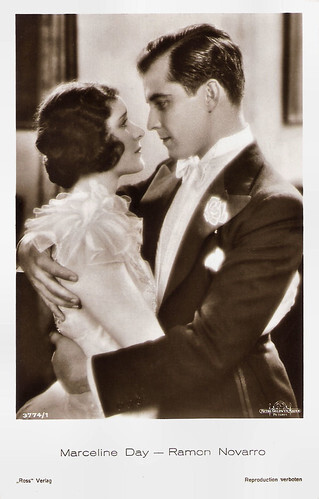
German postcard by Ross Verlag, no. 3774/1, 1928-1929. Photo: Metro-Goldwyn-Mayer. Marceline Day and Ramon Novarro in A Certain Young Man (Hobart Henley, 1928).
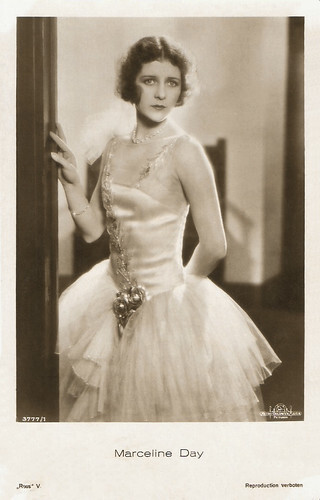
German postcard by Ross Verlag, no. 3777/1, 1928-1929. Photo: Metro Goldwyn Mayer.
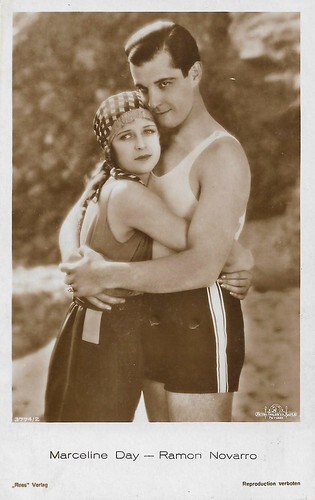
German postcard by Ross Verlag, no. 3774/2, 1928-1929. Photo: Metro-Goldwyn-Mayer. Ramon Novarro and Marceline Day in A Certain Young Man (Hobart Henley, 1928).
One of the most sought-after lost silent films
MGM cast Marceline Day in the romantic adventure The Beloved Rogue (Alan Crossland, 1927) opposite John Barrymore as legendary Parisian poet/vagabond Francois Villon. Then followed the now lost Horror classic London After Midnight (Tod Browning, 1927) starring Lon Chaney .
London After Midnight became the most successful collaborative film between Chaney and Browning, but it received mixed reviews from critics. The eerie sets, and Chaney's stunning vampire make-up, make for intriguing still photographs. The last known copy of the film was destroyed in the 1965 MGM vault fire, making it one of the most sought-after lost silent films.
As Serafina, she was the partner of leading man Ramon Novarro in the adventure film The Road to Romance (John S. Robertson, 1927). Adept at comedy, Day is best remembered for her role in The Cameraman (Edward Sedgwick, 1928), in which she starred as Sally Richards opposite Buster Keaton . The film was a box office hit, grossing $797,000, and was well-received by film critics.
During the rise of the sound film, Day made her transition effortlessly thanks to her pleasant, attractive voice. Her first sound film was The Jazz Age (Lynn Shores, 1929) with Douglas Fairbanks Jr. She appeared with her sister in the musical The Show of Shows (John G. Adolfi, 1929). She also appeared in The Wild Party (Dorothy Arzner, 1929) opposite Clara Bow . The film did very well at the box office. In the early 1930s, she left MGM and had to work mainly for smaller film studios with low budgets. Day was soon reduced to appearing in low-budget thrillers and action pictures.
By 1933, Day made the transition back to the Western genre, appearing in 'B' Westerns starring Tim McCoy, Hoot Gibson , Ken Maynard , Jack Hoxie , and John Wayne . Her last film was The Fighting Parson (Harry L. Fraser, 1933) with Gibson. She appeared in a total of 64 films between 1924 and 1933. In later years, she no longer spoke of her film career and refused numerous requests for interviews from fans or film historians. Marceline Day passed away in 2000 in Cathedral City, California. She was 91. The actress was married twice and had no children. She married furrier Arthur J. Klein in 1930 and was married for a second time in 1959 to John Arthur until he died in 1980.
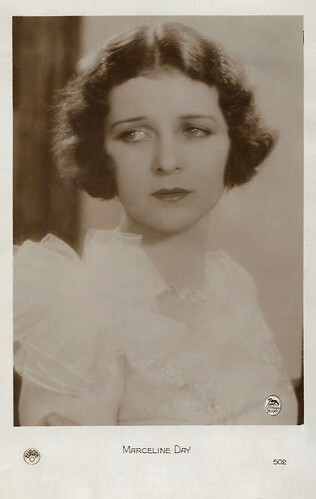
French postcard by Europe, no. 502. Photo: Metro Goldwyn Mayer.
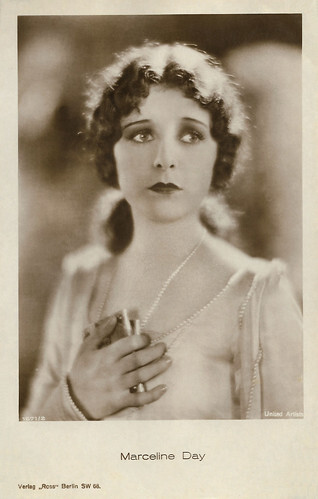
German postcard by Ross Verlag, Berlin, no. 1671/2, 1927-1928. Photo: United Artists.
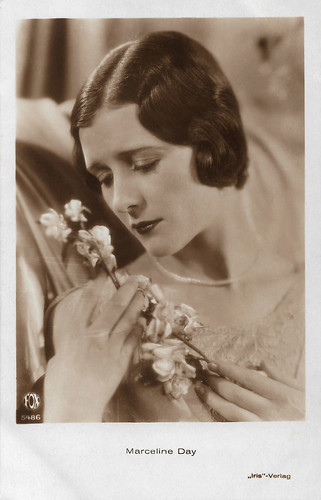
Austrian postcard by Iris Verlag, no. 5486. Photo: Fox. Collection: Geoffrey Donaldson Institute.
Sources: AllMovie, Wikipedia (Dutch, German and English) and .

French postcard by Cinémagazine-Édition, Paris, no. 66. Photo: Metro Goldwyn Mayer.

British postcard in the Picturegoer Series, London, no. 307a.

French postcard by A.N., Paris, no. 316. Photo: Metro Goldwyn Mayer.
The sweetheart of some of the top cowboy stars
Marceline Day was born as Marceline Newlin in 1908 in Colorado Springs, Colorado. She was the daughter of Frank and Irene Newlin and the younger sister of actress Alice Day. She was raised in Salt Lake City. She attended Venice High School.
In 1923, she followed her older sister into the film business when Alice became a bathing beauty in one and two-reel comedies for producer Mack Sennett of Keystone Studios. Sennett cast Marceline alongside Harry Langdon in such short comedies as Picking Peaches (Erle C. Kenton, 1924) and The Luck o' the Foolish (Harry Edwards, 1924).
She had a supporting part in the historical drama The Splendid Road (Frank Lloyd, 1925) starring Anna Q. Nilsson , Robert Frazer, and Lionel Barrymore . She co-starred with Richard Talmadge in the action comedy The Wall Street Whiz (Jack Nelson, 1925).
Day also appeared in silent Westerns as the sweetheart of some of the top cowboy stars. For Universal, she starred opposite Hoot Gibson in The Taming of the West (Arthur Rosson, 1925), opposite Jack Hoxie in The White Outlaw (Clifford Smith, 1925) and opposite Art Acord in Western Pluck (Travers Vale, 1926).
Her popularity snowballed and her success eclipsed the career of her sister Alice Day, who was herself now a well-known actress. Marceline co-starred with Lew Cody and Carmel Myers in the romantic drama The Gay Deceiver (1926), directed by John M. Stahl. In 1926, Day was named one of the WAMPAS Baby Stars, a campaign sponsoring newly emerging actresses. Other Baby Stars that year included Joan Crawford , Janet Gaynor , Mary Astor and Dolores del Río . The campaign contributed to Day's popularity.

German postcard by Ross Verlag, no. 3774/1, 1928-1929. Photo: Metro-Goldwyn-Mayer. Marceline Day and Ramon Novarro in A Certain Young Man (Hobart Henley, 1928).

German postcard by Ross Verlag, no. 3777/1, 1928-1929. Photo: Metro Goldwyn Mayer.

German postcard by Ross Verlag, no. 3774/2, 1928-1929. Photo: Metro-Goldwyn-Mayer. Ramon Novarro and Marceline Day in A Certain Young Man (Hobart Henley, 1928).
One of the most sought-after lost silent films
MGM cast Marceline Day in the romantic adventure The Beloved Rogue (Alan Crossland, 1927) opposite John Barrymore as legendary Parisian poet/vagabond Francois Villon. Then followed the now lost Horror classic London After Midnight (Tod Browning, 1927) starring Lon Chaney .
London After Midnight became the most successful collaborative film between Chaney and Browning, but it received mixed reviews from critics. The eerie sets, and Chaney's stunning vampire make-up, make for intriguing still photographs. The last known copy of the film was destroyed in the 1965 MGM vault fire, making it one of the most sought-after lost silent films.
As Serafina, she was the partner of leading man Ramon Novarro in the adventure film The Road to Romance (John S. Robertson, 1927). Adept at comedy, Day is best remembered for her role in The Cameraman (Edward Sedgwick, 1928), in which she starred as Sally Richards opposite Buster Keaton . The film was a box office hit, grossing $797,000, and was well-received by film critics.
During the rise of the sound film, Day made her transition effortlessly thanks to her pleasant, attractive voice. Her first sound film was The Jazz Age (Lynn Shores, 1929) with Douglas Fairbanks Jr. She appeared with her sister in the musical The Show of Shows (John G. Adolfi, 1929). She also appeared in The Wild Party (Dorothy Arzner, 1929) opposite Clara Bow . The film did very well at the box office. In the early 1930s, she left MGM and had to work mainly for smaller film studios with low budgets. Day was soon reduced to appearing in low-budget thrillers and action pictures.
By 1933, Day made the transition back to the Western genre, appearing in 'B' Westerns starring Tim McCoy, Hoot Gibson , Ken Maynard , Jack Hoxie , and John Wayne . Her last film was The Fighting Parson (Harry L. Fraser, 1933) with Gibson. She appeared in a total of 64 films between 1924 and 1933. In later years, she no longer spoke of her film career and refused numerous requests for interviews from fans or film historians. Marceline Day passed away in 2000 in Cathedral City, California. She was 91. The actress was married twice and had no children. She married furrier Arthur J. Klein in 1930 and was married for a second time in 1959 to John Arthur until he died in 1980.

French postcard by Europe, no. 502. Photo: Metro Goldwyn Mayer.

German postcard by Ross Verlag, Berlin, no. 1671/2, 1927-1928. Photo: United Artists.

Austrian postcard by Iris Verlag, no. 5486. Photo: Fox. Collection: Geoffrey Donaldson Institute.
Sources: AllMovie, Wikipedia (Dutch, German and English) and .
Published on June 15, 2024 22:00
June 14, 2024
Don Ameche
Throughout his 65-year career, American actor Don Ameche (1908-1993) worked in cinema, television, theatre and radio. He was the dapper, moustached leading man in classic Hollywood films of the 1930s and 1940s. In 1986, he won an Oscar for his role as a rejuvenated oldster in Cocoon (1986).
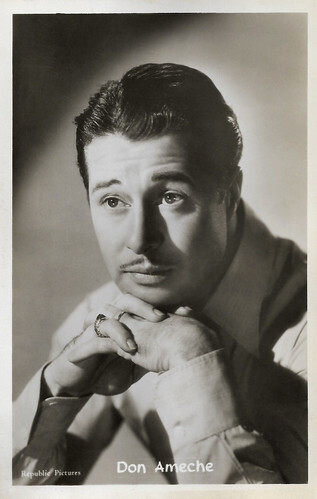
Vintage postcard. Photo: Republic Pictures.
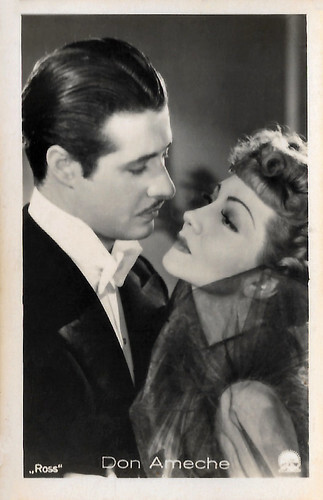
German collector card by Ross Verlag. Photo: Paramount. Don Ameche and Claudette Colbert in Midnight (Mitchell Leisen, 1939).
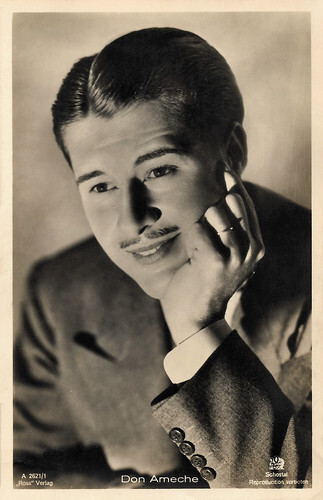
German postcard by Ross Verlag, no. A 2621/1, 1939-1940. Photo: Schostal / 20th Century Fox.
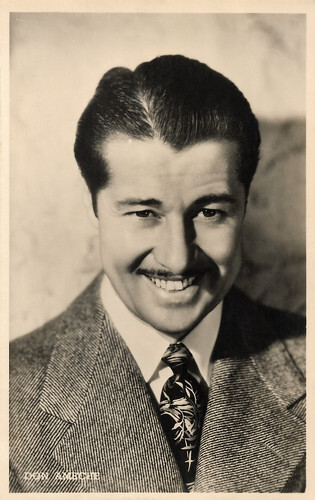
Dutch postcard by J.S.A., 1947. Photo: Universal M.P.E.
A trim figure, pencil-thin moustache, and rich baritone voice
Don Ameche was born Dominic Felix Amici in Kenosha, Wisconsin in 1908. His father, Felice Amici, was a bartender from the Italian village of Montemonaco in the Marche, and his mother was Barbara Etta Hertel. Ameche was the second-oldest of eight children. His brother Jim Ameche (1915-1986) also became an actor and radio presenter.
Ameche attended Marquette University, Loras College, and the University of Wisconsin–Madison. While studying law at the University of Wisconsin, Don performed in student theatre. When a lead actor for a stock company production of 'Excess Baggage' fell out, a friend persuaded him to stand in. After that, he forewent his law career and became a full-time theatrical actor.
He got a juvenile lead in 'Jerry For Short' in New York. A tour in Vaudeville with Texas Guinan followed until she dropped him from the act, dismissing him as "too stiff". Ameche moved in 1930 to Chicago, where he began appearing as an actor in radio productions, which brought him his first popularity. He made his screen debut in a feature short, Beauty at the World's Fair (1933). Ameche moved to Hollywood where he screen-tested with MGM in 1935, but the studio did not want to give him a contract.
The following year, 20th-Century Fox producer Darryl Zanuck brought him to Hollywood. AllMovie : "Ameche, with his trim figure, pencil-thin moustache, and rich baritone voice was neither a conventionally handsome leading man nor the dashing hero type. Instead, he embodied a wholesomeness and bland honesty that made him the ideal co-lead and foil for the more complex heroes." He had his breakthrough in the musical Alexander's Ragtime Band (Henry King, 1938) with Tyrone Power and Alice Faye.
Ameche appeared in several film biographies, including the title role in The Story of Alexander Graham Bell (Irving Cummings, 1939). The film was a tremendous success. Calling the telephone an 'ameche' became popular American slang in the 1940s. Also in 1939, he played a taxi driver who disguises himself as a baron in the Screwball Comedy Midnight (Mitchell Leisen, 1939) alongside Claudette Colbert . Ameche was Alice Faye's leading man in Hollywood Cavalcade (Irving Cummings, 1939). He then played another real-life figure, Stephen Foster, in Swanee River (Sidney Lanfield, 1939). He did a third biopic, Lillian Russell (Irving Cummings, 1940) with Faye, and was top-billed in a war film, Four Sons (Archie Mayo, 1940).
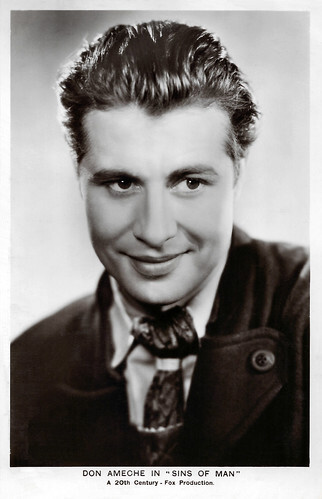
British postcard in the Picturegoer Series, London, no. 1103. Photo: 20th Century Fox. Don Ameche in Sins of Man (Otto Brower, Gregory Ratoff, 1936).
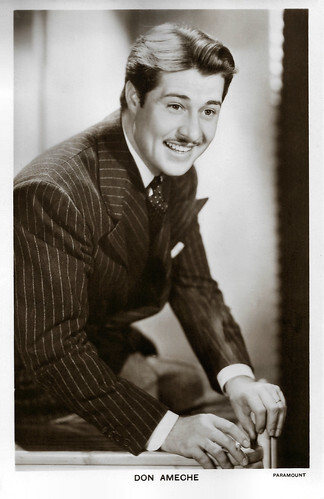
British postcard in the Picturegoer Series, London, no. 1103a. Photo: Paramount.
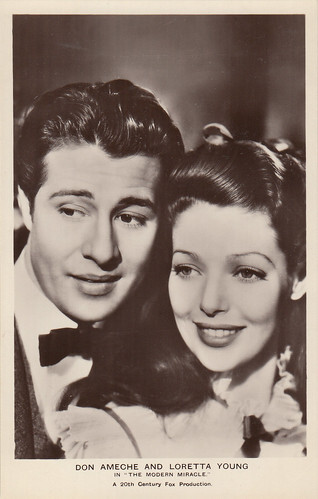
British postcard by Picturegoer, no. FS194. Photo: 20th Century Fox. Loretta Young and Don Ameche in The Story of Alexander Graham Bell (Irving Cummings, 1939). Collection: Marlene Pilaete.
A perfect blend of sophistication, romance, wit and bittersweet sentiment
Don Ameche's favourite role was the bon vivant Henry Van Cleve in Ernst Lubitsch 's melancholy comedy Heaven Can Wait (Ernst Lubitsch, 1943) with Gene Tierney . The film tells the story of a man who has to prove he belongs in Hell by telling his life story.
Brendon Hanley reviews at AllMovie : "Heaven is typical of the "Lubitsch Touch": It's a perfect blend of sophistication, romance, wit and bittersweet sentiment. The benevolent story reveals Don Ameche's life to be as average as any man's, but Lubitsch's genuine tenderness elevates the tale to the majestic. Ameche and Gene Tierney deliver mature, convincing performances, appropriate to the subject matter."
Ameche also appeared in several musicals, such as Down Argentine Way (Irving Cummings, 1940) and Moon Over Miami (Walter Lang, 1941), both alongside Betty Grable . In 1940, he was voted the 21st most popular star in Hollywood. At the same time, he continued to appear on popular radio shows such as 'The Bickersons' opposite Frances Langford and 'The Charlie McCarthy Show'.
After his studio contract with 20th Century Fox ended in the late 1940s, the quality of his film work quickly declined. Ameche concentrated on the then-new medium of television. In 1950 Ameche became the star of Holiday Hotel, on ABC-TV. He also acted in theatre.
In 1955, he appeared for the first time in a Broadway production, in the world premiere of Cole Porter's musical 'Silk Stockings'. He played the male lead alongside Hildegard Knef . On TV, he hosted NBC's International Showtime from 1961 to 1965. He began appearing infrequently in low-budget films during the 1960s and 1970s but made only five films from 1949 to 1983.
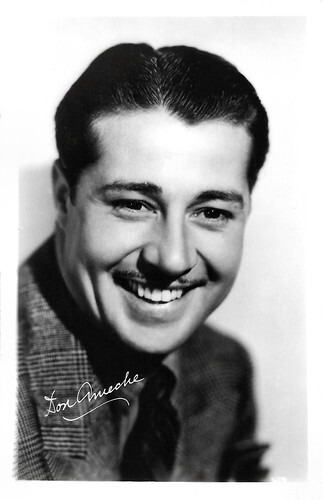
American postcard by EKC.
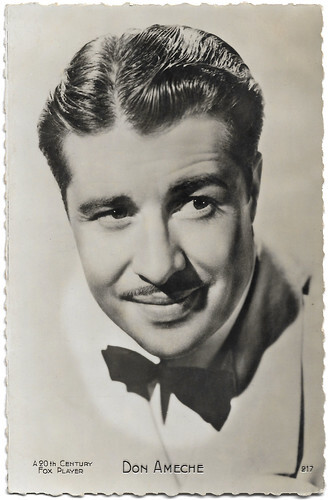
French postcard by Editions P.I., Paris, no. 217. Photo: 20th Century Fox.
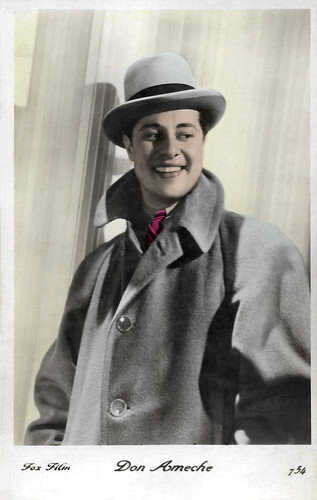
French postcard, no. 754. Photo: Fox Film.
A villainous millionaire
Over 70 years old, Don Ameche made a comeback as a film actor in the 1980s. Director John Landis wanted him to replace the ailing Ray Milland who was cast as the villainous millionaire Mortimer Duke opposite Dan Aykroyd and Eddie Murphy in the comedy Trading Places (John Landis, 1983), also with Ralph Bellamy.
Ameche had not acted in a film for 13 years. When Landis was erroneously told Ameche was dead, a receptionist told him that Ameche was alive as she had seen him on his walks in Santa Monica. Landis found Ameche listed in the phone book. The success of this film and his role revitalised his film career and he acted consistently until only a month before his death.
In 1985, he received an Oscar for Best Supporting Actor for his performance as a retirement home Casanova in Cocoon (Ron Howard, 1985), starring Steve Guttenberg. Further appearances in film comedies include roles in Harry and the Hendersons (William Dear, 1987), Coming to America (John Landis, 1988) starring Eddie Murphy , and Cocoon: The Return (Daniel Petrie, 1988).
He earned good reviews for his role opposite Joe Mantegna in Things Change (David Mamet, 1988). Ameche played an impish shoemaker chosen to take the fall for a mob hit. Michael Hastings at AllMovie : "Ameche's performance is equal parts Marcello Mastroianni and Charles Chaplin : alternately profound and quizzical, he never plays the role merely for slapstick laughs." He made his last brief but memorable performance in Corrina, Corrina (Jessie Nelson, 1994) starring Whoopi Goldberg, shortly before he died.
Don Ameche had been married to Honore Prendergast since 1932 till she died in 1986. They had six children. Don Ameche died of prostate cancer in 1993 at his son Don Jr.'s home in Scottsdale, Arizona. His body was cremated and his ashes buried alongside his wife Honore in Resurrection Catholic Cemetery, known as St. Philomena's Cemetery, in Asbury, Dubuque County, Iowa. Don Ameche was inducted into the Radio Hall of Fame in 1992.
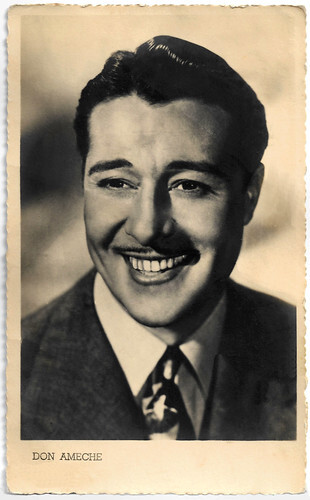
Dutch postcard by S. & v. H. A., no. 1103a. Photo: M.P.E.A.
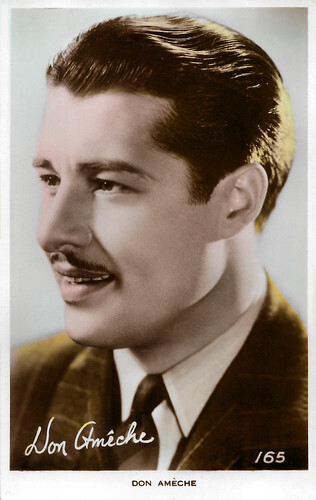
British Art Photo postcard, no. 165.
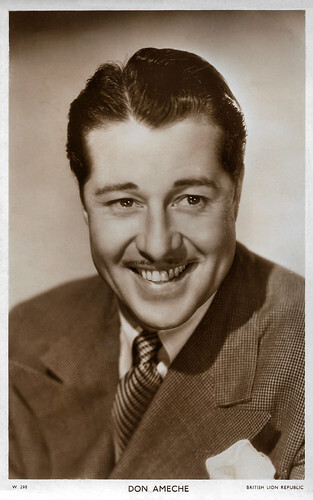
British postcard in the Picturegoer Series, London, no. W. 298. Photo: British Lion Republic.
Sources: Brendon Hanley (AllMovie), Michael Hastings (AllMovie), AllMovie, Wikipedia (German, Dutch, French and English) and .

Vintage postcard. Photo: Republic Pictures.

German collector card by Ross Verlag. Photo: Paramount. Don Ameche and Claudette Colbert in Midnight (Mitchell Leisen, 1939).

German postcard by Ross Verlag, no. A 2621/1, 1939-1940. Photo: Schostal / 20th Century Fox.

Dutch postcard by J.S.A., 1947. Photo: Universal M.P.E.
A trim figure, pencil-thin moustache, and rich baritone voice
Don Ameche was born Dominic Felix Amici in Kenosha, Wisconsin in 1908. His father, Felice Amici, was a bartender from the Italian village of Montemonaco in the Marche, and his mother was Barbara Etta Hertel. Ameche was the second-oldest of eight children. His brother Jim Ameche (1915-1986) also became an actor and radio presenter.
Ameche attended Marquette University, Loras College, and the University of Wisconsin–Madison. While studying law at the University of Wisconsin, Don performed in student theatre. When a lead actor for a stock company production of 'Excess Baggage' fell out, a friend persuaded him to stand in. After that, he forewent his law career and became a full-time theatrical actor.
He got a juvenile lead in 'Jerry For Short' in New York. A tour in Vaudeville with Texas Guinan followed until she dropped him from the act, dismissing him as "too stiff". Ameche moved in 1930 to Chicago, where he began appearing as an actor in radio productions, which brought him his first popularity. He made his screen debut in a feature short, Beauty at the World's Fair (1933). Ameche moved to Hollywood where he screen-tested with MGM in 1935, but the studio did not want to give him a contract.
The following year, 20th-Century Fox producer Darryl Zanuck brought him to Hollywood. AllMovie : "Ameche, with his trim figure, pencil-thin moustache, and rich baritone voice was neither a conventionally handsome leading man nor the dashing hero type. Instead, he embodied a wholesomeness and bland honesty that made him the ideal co-lead and foil for the more complex heroes." He had his breakthrough in the musical Alexander's Ragtime Band (Henry King, 1938) with Tyrone Power and Alice Faye.
Ameche appeared in several film biographies, including the title role in The Story of Alexander Graham Bell (Irving Cummings, 1939). The film was a tremendous success. Calling the telephone an 'ameche' became popular American slang in the 1940s. Also in 1939, he played a taxi driver who disguises himself as a baron in the Screwball Comedy Midnight (Mitchell Leisen, 1939) alongside Claudette Colbert . Ameche was Alice Faye's leading man in Hollywood Cavalcade (Irving Cummings, 1939). He then played another real-life figure, Stephen Foster, in Swanee River (Sidney Lanfield, 1939). He did a third biopic, Lillian Russell (Irving Cummings, 1940) with Faye, and was top-billed in a war film, Four Sons (Archie Mayo, 1940).

British postcard in the Picturegoer Series, London, no. 1103. Photo: 20th Century Fox. Don Ameche in Sins of Man (Otto Brower, Gregory Ratoff, 1936).

British postcard in the Picturegoer Series, London, no. 1103a. Photo: Paramount.

British postcard by Picturegoer, no. FS194. Photo: 20th Century Fox. Loretta Young and Don Ameche in The Story of Alexander Graham Bell (Irving Cummings, 1939). Collection: Marlene Pilaete.
A perfect blend of sophistication, romance, wit and bittersweet sentiment
Don Ameche's favourite role was the bon vivant Henry Van Cleve in Ernst Lubitsch 's melancholy comedy Heaven Can Wait (Ernst Lubitsch, 1943) with Gene Tierney . The film tells the story of a man who has to prove he belongs in Hell by telling his life story.
Brendon Hanley reviews at AllMovie : "Heaven is typical of the "Lubitsch Touch": It's a perfect blend of sophistication, romance, wit and bittersweet sentiment. The benevolent story reveals Don Ameche's life to be as average as any man's, but Lubitsch's genuine tenderness elevates the tale to the majestic. Ameche and Gene Tierney deliver mature, convincing performances, appropriate to the subject matter."
Ameche also appeared in several musicals, such as Down Argentine Way (Irving Cummings, 1940) and Moon Over Miami (Walter Lang, 1941), both alongside Betty Grable . In 1940, he was voted the 21st most popular star in Hollywood. At the same time, he continued to appear on popular radio shows such as 'The Bickersons' opposite Frances Langford and 'The Charlie McCarthy Show'.
After his studio contract with 20th Century Fox ended in the late 1940s, the quality of his film work quickly declined. Ameche concentrated on the then-new medium of television. In 1950 Ameche became the star of Holiday Hotel, on ABC-TV. He also acted in theatre.
In 1955, he appeared for the first time in a Broadway production, in the world premiere of Cole Porter's musical 'Silk Stockings'. He played the male lead alongside Hildegard Knef . On TV, he hosted NBC's International Showtime from 1961 to 1965. He began appearing infrequently in low-budget films during the 1960s and 1970s but made only five films from 1949 to 1983.

American postcard by EKC.

French postcard by Editions P.I., Paris, no. 217. Photo: 20th Century Fox.

French postcard, no. 754. Photo: Fox Film.
A villainous millionaire
Over 70 years old, Don Ameche made a comeback as a film actor in the 1980s. Director John Landis wanted him to replace the ailing Ray Milland who was cast as the villainous millionaire Mortimer Duke opposite Dan Aykroyd and Eddie Murphy in the comedy Trading Places (John Landis, 1983), also with Ralph Bellamy.
Ameche had not acted in a film for 13 years. When Landis was erroneously told Ameche was dead, a receptionist told him that Ameche was alive as she had seen him on his walks in Santa Monica. Landis found Ameche listed in the phone book. The success of this film and his role revitalised his film career and he acted consistently until only a month before his death.
In 1985, he received an Oscar for Best Supporting Actor for his performance as a retirement home Casanova in Cocoon (Ron Howard, 1985), starring Steve Guttenberg. Further appearances in film comedies include roles in Harry and the Hendersons (William Dear, 1987), Coming to America (John Landis, 1988) starring Eddie Murphy , and Cocoon: The Return (Daniel Petrie, 1988).
He earned good reviews for his role opposite Joe Mantegna in Things Change (David Mamet, 1988). Ameche played an impish shoemaker chosen to take the fall for a mob hit. Michael Hastings at AllMovie : "Ameche's performance is equal parts Marcello Mastroianni and Charles Chaplin : alternately profound and quizzical, he never plays the role merely for slapstick laughs." He made his last brief but memorable performance in Corrina, Corrina (Jessie Nelson, 1994) starring Whoopi Goldberg, shortly before he died.
Don Ameche had been married to Honore Prendergast since 1932 till she died in 1986. They had six children. Don Ameche died of prostate cancer in 1993 at his son Don Jr.'s home in Scottsdale, Arizona. His body was cremated and his ashes buried alongside his wife Honore in Resurrection Catholic Cemetery, known as St. Philomena's Cemetery, in Asbury, Dubuque County, Iowa. Don Ameche was inducted into the Radio Hall of Fame in 1992.

Dutch postcard by S. & v. H. A., no. 1103a. Photo: M.P.E.A.

British Art Photo postcard, no. 165.

British postcard in the Picturegoer Series, London, no. W. 298. Photo: British Lion Republic.
Sources: Brendon Hanley (AllMovie), Michael Hastings (AllMovie), AllMovie, Wikipedia (German, Dutch, French and English) and .
Published on June 14, 2024 22:00
June 13, 2024
Walter Rilla
German actor Walter Rilla (1894-1980) began his career in silent films and appeared in over 130 films between 1922 and 1977. In 1933 he took his family and fled the Nazi regime. In London, he played vile, foreign-tongued villains in spy films. He returned to Germany in the 1950s and wrote and directed for TV.
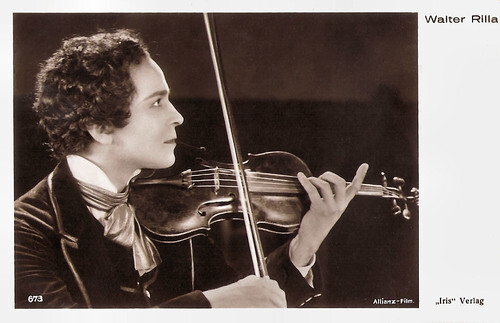
Austrian postcard by Iris Verlag, no. 673. Photo: Allianz-Film / Domo-Strauß-Film GmbH. Walter Rilla in the Austrian-German silent operetta film Hoheit tanzt Walzer/Her Highness Dances the Waltz (Fritz Freisler, 1926). The operetta film is based on the 1912 operetta 'Hoheit tanzt Walzer' by Leo Ascher (music) and Alfred Grünwald (libretto). The German distribution was taken care of by Domo-Strauß-Film. The film was a huge success, both critically and financially, and a major breakthrough for Rilla.
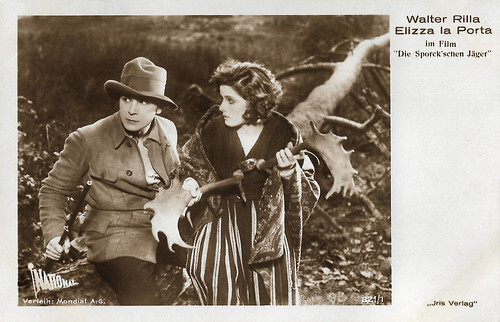
Austrian postcard by Iris Verlag, no. 821/1 Photo: National / Verleih Mondial A.G. Walter Rilla and Eliza La Porta in Die Sporck'schen Jäger/The Sporck Battalion (Holger-Madsen, 1927).
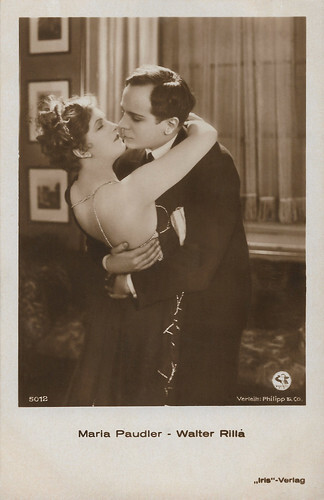
Austrian postcard by Iris-Verlag, no. 5012. Photo: Phoebus Film / Verleih: Philipp & Co. Maria Paudler and Walter Rilla in Die weiße Spinne/The White Spider (Carl Boese, 1927).
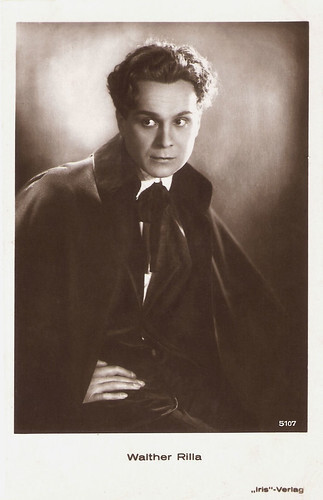
Austrian postcard by Iris-Verlag, no. 5107.
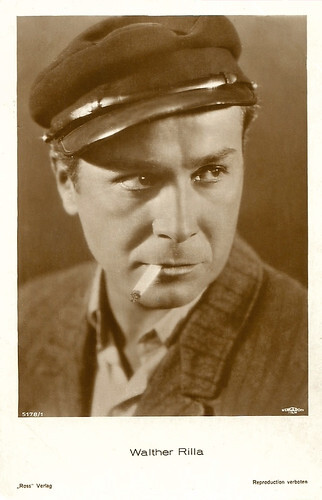
German postcard by Ross Verlag, Berlin, no. 5178/1, 1930-1931. Photo: Wengeroff-Film. Thanks to Walter Rilla expert Gerhild Krebs, we were able to identify the film. This card with Rilla as 'Apache' namely refers to the film Polizeispionin 77/Police Spy 77 (Willi Wolff, 1930). It was Rilla's second male lead in a film starring Ellen Richter, after Wie einst im Mai (Willi Wolff,1926). Polizeispionin 77 is considered a lost film.
One of the most important German character actors
Walter Rilla was born Walter Wilhelm Karl Ernst Rilla in Neunkirchen (near Saarbrücken), Germany, in 1894. He was the son of railway engineer Friedrich Wilhelm Rilla and his wife Caroline, née Gründer. He visited the Fridericianum school in Königsberg and the University of Königsberg. He studied literature, art history and philosophy in Königsberg, Breslau, Lausanne and Berlin.
He worked as a journalist for the Neuesten Breslauer Nachrichten (Latest Breslau News). In 1919 Rilla founded the literary journal Erde (Earth). At the time, he was involved with the Communist Party and, when established with the leftish KAPD party. From 1920 on, he worked as a story editor for the Berliner Theater.
Rilla made his film debut with a small role as the death angel in the Gerhart Hauptmann adaptation Hanneles Himmelfahrt/Hannele's Ascension (Urban Gad, 1922). Soon Rilla became one of the most important German character actors and worked with such other prominent directors as Victor Janson , Max Mack , and Reinhold Schünzel . In 1924 he appeared in one of F. W. Murnau 's rare attempts at comedy, the hilarious Die Finanzen des Grossherzogs/The Finances of the Grand Duke (Friedrich Wilhelm Murnau, 1924) starring Alfred Abel .
A year later he starred opposite Jane Novak in the German-British coproduction Die Prinzessin und der Geiger/The Blackguard (Graham Cutts, 1925) written by the then 26-year-old Alfred Hitchcock . In 1926 Rilla starred opposite Elisabeth Bergner and Conrad Veidt in Der Geigenspieler von Florenz/Impetuous Youth (Paul Czinner, 1926), and two years later he costarred with Carmen Boni and Marlene Dietrich in Prinzessin Olala/Art of Love (Robert Land, 1928).
He made an easy transition into sound film. He played for example Baron Hans von Velten in Namensheirat/Marriage in Name Only (Heinz Paul, 1930), Robert in Männer um Lucie/Men Around Lucie (Alexander Korda, 1931) with Liane Haid , and Lord Windermere in Lady Windermeres Fächer/Lady Windermere's Fan (Heinz Hilpert, 1935).
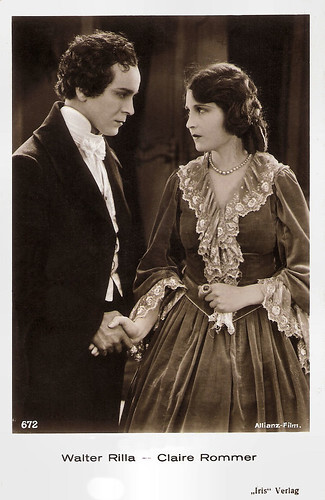
Austrian postcard by Iris Verlag, no. 672. Photo: Allianz-Film / Domo-Strauß-Film GmbH. Walter Rilla and Claire Rommer in the Austrian-German silent operetta film Hoheit tanzt Walzer/Her Highness Dances the Waltz (Fritz Freisler, 1926).
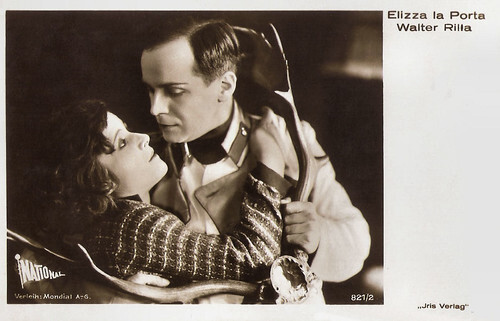
Austrian postcard by Iris Verlag, no. 821/2. Photo: National / Verleih Mondial A.G. Eliza La Porta and Walter Rilla in Die Sporck'schen Jäger/The Sporck Battalion (Holger-Madsen, 1927).
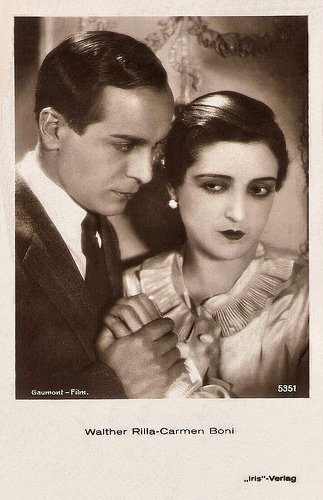
Austrian postcard by Iris-Verlag, no. 5351. Photo: Gaumont-Film. With Carmen Boni .
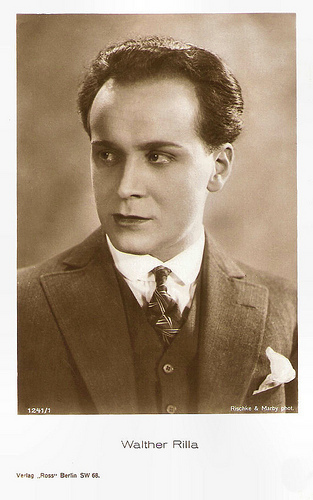
German postcard by Ross Verlag, no. 1241/1, 1927-1928. Photo: Rischke & Marby.
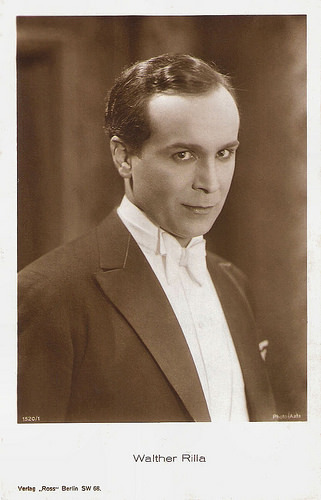
German postcard by Ross Verlag, no. 1520/1, 1927-1928. Photo: Aafa.
Escaping the rising power of Hitler
In 1933 Walter Rilla moved with his family to London to escape the rising power of Adolph Hitler. His wife was Jewish and he refused to separate from her. He had no trouble establishing himself in British films after 1933. He started out in the hits The Scarlet Pimpernel (Harold Young, 1934) featuring Leslie Howard , and Abdul the Damned (Karl Grune, 1935) with Fritz Kortner .
Rilla only appeared in character parts, but he did work with respected directors like Robert Siodmak and Herbert Wilcox on successful British and French productions. He was seen for example as Prince Ernst in the Wilcox staged historical drama Victoria the Great (Herbert Wilcox, 1937) with Anna Neagle , and a year later, again in that role in the sequel, Sixty Glorious Years/Queen of Destiny (Herbert Wilcox, 1938). Other films were the adventure Hell's Cargo/Dangerous Cargo (Harold Huth, 1939), and the romance Black Eyes/False Rapture (Herbert Brenon, 1939).
In 1940 he became a British citizen. During the war years Rilla specialized in sinister foreigners — and, of course, Nazis - in such war films as The Adventures of Tartu/Sabotage Agent (Harold S. Buquet, 1943) starring Robert Donat and Valerie Hobson , and Candlelight in Algeria (George King, 1944) starring James Mason .
Aside from acting, Walter Rilla worked in the UK as a producer and screenwriter, and as an author of radio plays for the BBC. He also published some novels. After the war, Rilla continued his evil film ways in a progression of appearances as sultans, megalomaniacs and corporate villains. Probably the most interesting of these films is the thriller Desperate Moment (Compton Bennett, 1953) starring Dirk Bogarde as a man who tries to clear himself of murder in post-war Germany. Rilla directed one film himself, Behold the Man! (1951).
In 1957 Walter Rilla returned to Germany. There he had his first role in the Thomas Mann adaptation Bekenntnisse des Hochstaplers Felix Krull/Confessions of Felix Krull (Kurt Hoffmann, 1957) alongside Horst Buchholz . He followed this hit with a role in an equally popular film, Scampolo (Alfred Weidenmann, 1958) starring Romy Schneider . He then played in the last Mario Lanza vehicle, For the First Time (Rudolph Maté, 1959).
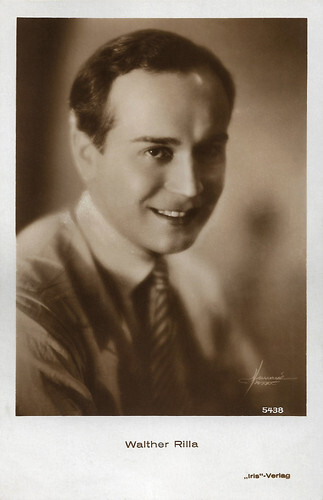
Austrian postcard by Iris-Verlag, no. 5438. Photo: Manassé, Wien (Vienna).
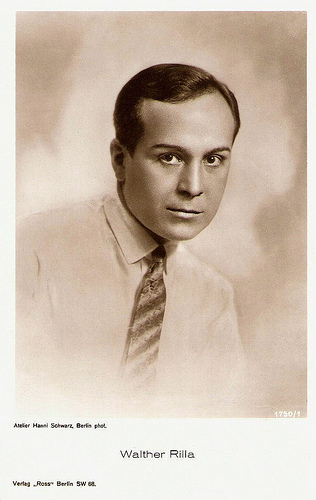
German postcard by Ross Verlag, no. 1750/1, 1927-1928. Photo: Hanni Schwarz, Berlin.
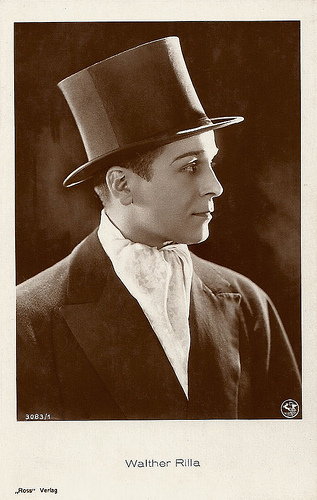
German postcard by Ross Verlag, no. 3083/1, 1928-1929. Photo: Phoebus Film.
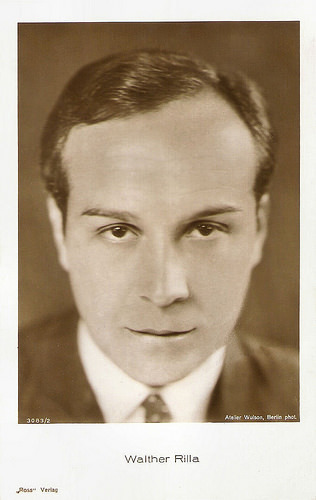
German postcard by Ross Verlag, no. 3083/2, 1928-1929. Photo: Atelier Wulson, Berlin.
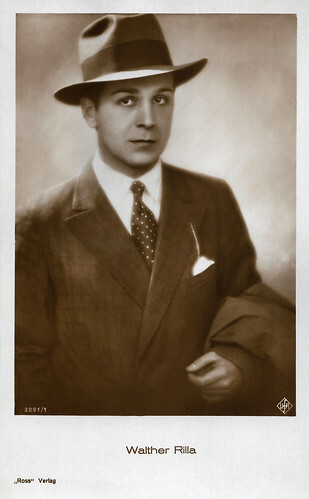
German postcard by Ross Verlag, no. 3291/1, 1928-1929. Photo: Ufa.
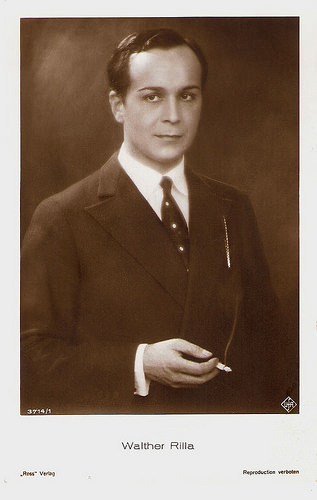
German postcard by Ross Verlag, no. 3714/1, 1928-1929. Photo: Ufa.
Back in Germany
Walter Rilla appeared in the Edgar Wallace film adaptations Der Fälscher von London/The Forger Of London (Harald Reinl, 1960) and Zimmer 13/Room 13 (Harald Reinl, 1964) with Karin Dor . He played Dr. Mabuse in Das Testament des Dr. Mabuse/The Terror of Doctor Mabuse (1962) opposite Gert Fröbe, and Dr. Mabuse and Scotland Yard jagt Dr. Mabuse/Dr. Mabuse vs. Scotland Yard (Paul May, 1963) opposite Peter van Eyck .
In addition, Rilla was a writer, screenwriter, producer, and director of several stage and TV productions, and he worked as a television actor. From 1957 on he had an engagement at the Kleine Komödie in München (Munich). In 1966 he was awarded the Filmband in Gold for his work in German cinema.
Later films include the Spaghetti Western I giorni dell'ira/Gunlaw (Tonino Valerii, 1967) starring Lee van Cleef and Giuliano Gemma , the cult thriller Der Teufel kam aus Akasava/The Devil Came from Akasava (Jesus Franco, 1971) with Fred Williams and Soledad Miranda, and the interesting surrealistic Horror film Malpertuis/The Legend of Doom House (Harry Kümel, 1971) with Mathieu Carrière and Orson Welles .
He made his last screen appearance in the Thomas Mann adaptation Unordnung und frühes Leid/Disorder and Early Torment (Frans Seitz, 1977) with Ruth Leuwerik and Martin Held .
Walter Rilla died in 1980 in Rosenheim, Germany. He had been married twice. First, he married Theresa Klausner, who died in 1948. They had a son, prominent British-based film screenwriter and director Wolf Rilla (1920-2005). Since 1959, Walter Rilla was married to the French writer Alix Degrelle-Hirth du Frênes.
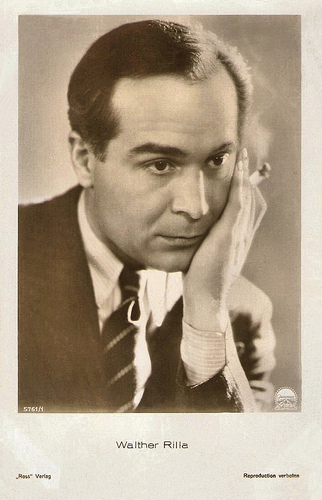
German postcard by Ross Verlag, no. 5761/1, 1930-1931. Photo: Paramount.
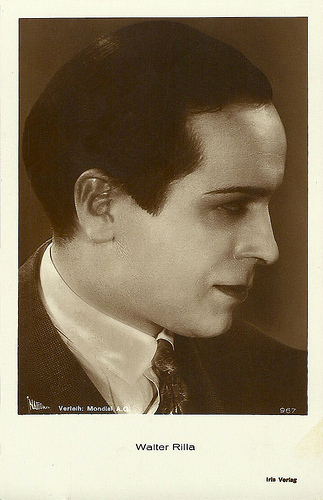
Austrian postcard by Iris Verlag, no. 967. Photo: Mondial / National.
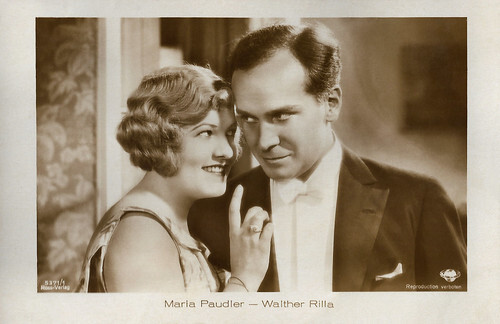
German postcard by Ross Verlag, no. 5371/1, 1930-1931. Photo: Deutsche Universal-Film. Maria Paudler and Walter Rilla in Die große Sehnsucht/The Great Desire (Steve Sekely, 1930).
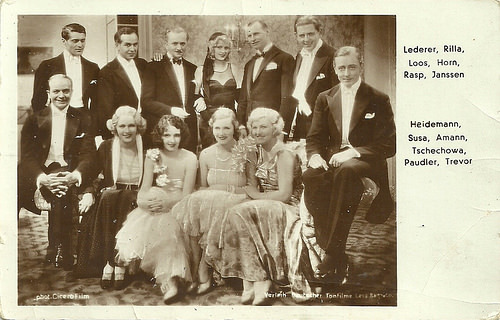
German postcard. Photo: Cicero Film / Distribution Deutsche Tonfilme.
The 'fine fleur' of late silent German cinema stars, united for a photo for an early sound film company. Standing left to right: Francis/Franz Lederer, Walter Rilla, Theodor Loos, Camilla Horn, Fritz Rasp and Walter Janssen, Sitting left to right: Paul Heidemann, Charlotte Susa, Betty Amann, Olga Tschechowa, Maria Paudler and Jack Trevor. This was possibly a promotion postcard for the early sound comedy Die grosse Sehnsucht/The Great Longing (Stefan Szekely a.k.a. Steve Sekely, 1930), in which all acted, mostly as themselves - only Loos and Horn played characters. The plot was an excuse for 35 stars to debut in a talking picture.
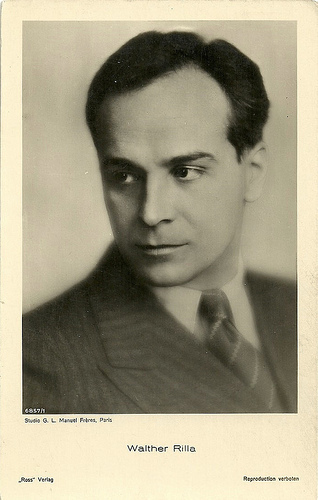
German postcard by Ross Verlag, no. 6857/1, 1931-1932. Photo: Studio G.L. Manuel Frères, Paris.
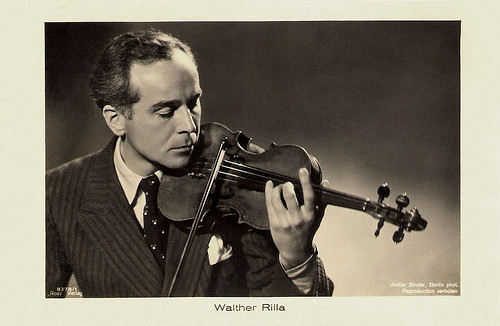
German postcard by Ross Verlag, no. 8378/1, 1933-1934. Photo: Atelier Binder, Berlin. Publicity still for Der Springer von Pontresina/The Champion of Pontresina (Herbert Selpin, 1934).
Sources: Stephanie D’heil (Steffi-line), Hal Erickson (AllMovie), Wikipedia (German), and .

Austrian postcard by Iris Verlag, no. 673. Photo: Allianz-Film / Domo-Strauß-Film GmbH. Walter Rilla in the Austrian-German silent operetta film Hoheit tanzt Walzer/Her Highness Dances the Waltz (Fritz Freisler, 1926). The operetta film is based on the 1912 operetta 'Hoheit tanzt Walzer' by Leo Ascher (music) and Alfred Grünwald (libretto). The German distribution was taken care of by Domo-Strauß-Film. The film was a huge success, both critically and financially, and a major breakthrough for Rilla.

Austrian postcard by Iris Verlag, no. 821/1 Photo: National / Verleih Mondial A.G. Walter Rilla and Eliza La Porta in Die Sporck'schen Jäger/The Sporck Battalion (Holger-Madsen, 1927).

Austrian postcard by Iris-Verlag, no. 5012. Photo: Phoebus Film / Verleih: Philipp & Co. Maria Paudler and Walter Rilla in Die weiße Spinne/The White Spider (Carl Boese, 1927).

Austrian postcard by Iris-Verlag, no. 5107.

German postcard by Ross Verlag, Berlin, no. 5178/1, 1930-1931. Photo: Wengeroff-Film. Thanks to Walter Rilla expert Gerhild Krebs, we were able to identify the film. This card with Rilla as 'Apache' namely refers to the film Polizeispionin 77/Police Spy 77 (Willi Wolff, 1930). It was Rilla's second male lead in a film starring Ellen Richter, after Wie einst im Mai (Willi Wolff,1926). Polizeispionin 77 is considered a lost film.
One of the most important German character actors
Walter Rilla was born Walter Wilhelm Karl Ernst Rilla in Neunkirchen (near Saarbrücken), Germany, in 1894. He was the son of railway engineer Friedrich Wilhelm Rilla and his wife Caroline, née Gründer. He visited the Fridericianum school in Königsberg and the University of Königsberg. He studied literature, art history and philosophy in Königsberg, Breslau, Lausanne and Berlin.
He worked as a journalist for the Neuesten Breslauer Nachrichten (Latest Breslau News). In 1919 Rilla founded the literary journal Erde (Earth). At the time, he was involved with the Communist Party and, when established with the leftish KAPD party. From 1920 on, he worked as a story editor for the Berliner Theater.
Rilla made his film debut with a small role as the death angel in the Gerhart Hauptmann adaptation Hanneles Himmelfahrt/Hannele's Ascension (Urban Gad, 1922). Soon Rilla became one of the most important German character actors and worked with such other prominent directors as Victor Janson , Max Mack , and Reinhold Schünzel . In 1924 he appeared in one of F. W. Murnau 's rare attempts at comedy, the hilarious Die Finanzen des Grossherzogs/The Finances of the Grand Duke (Friedrich Wilhelm Murnau, 1924) starring Alfred Abel .
A year later he starred opposite Jane Novak in the German-British coproduction Die Prinzessin und der Geiger/The Blackguard (Graham Cutts, 1925) written by the then 26-year-old Alfred Hitchcock . In 1926 Rilla starred opposite Elisabeth Bergner and Conrad Veidt in Der Geigenspieler von Florenz/Impetuous Youth (Paul Czinner, 1926), and two years later he costarred with Carmen Boni and Marlene Dietrich in Prinzessin Olala/Art of Love (Robert Land, 1928).
He made an easy transition into sound film. He played for example Baron Hans von Velten in Namensheirat/Marriage in Name Only (Heinz Paul, 1930), Robert in Männer um Lucie/Men Around Lucie (Alexander Korda, 1931) with Liane Haid , and Lord Windermere in Lady Windermeres Fächer/Lady Windermere's Fan (Heinz Hilpert, 1935).

Austrian postcard by Iris Verlag, no. 672. Photo: Allianz-Film / Domo-Strauß-Film GmbH. Walter Rilla and Claire Rommer in the Austrian-German silent operetta film Hoheit tanzt Walzer/Her Highness Dances the Waltz (Fritz Freisler, 1926).

Austrian postcard by Iris Verlag, no. 821/2. Photo: National / Verleih Mondial A.G. Eliza La Porta and Walter Rilla in Die Sporck'schen Jäger/The Sporck Battalion (Holger-Madsen, 1927).

Austrian postcard by Iris-Verlag, no. 5351. Photo: Gaumont-Film. With Carmen Boni .

German postcard by Ross Verlag, no. 1241/1, 1927-1928. Photo: Rischke & Marby.

German postcard by Ross Verlag, no. 1520/1, 1927-1928. Photo: Aafa.
Escaping the rising power of Hitler
In 1933 Walter Rilla moved with his family to London to escape the rising power of Adolph Hitler. His wife was Jewish and he refused to separate from her. He had no trouble establishing himself in British films after 1933. He started out in the hits The Scarlet Pimpernel (Harold Young, 1934) featuring Leslie Howard , and Abdul the Damned (Karl Grune, 1935) with Fritz Kortner .
Rilla only appeared in character parts, but he did work with respected directors like Robert Siodmak and Herbert Wilcox on successful British and French productions. He was seen for example as Prince Ernst in the Wilcox staged historical drama Victoria the Great (Herbert Wilcox, 1937) with Anna Neagle , and a year later, again in that role in the sequel, Sixty Glorious Years/Queen of Destiny (Herbert Wilcox, 1938). Other films were the adventure Hell's Cargo/Dangerous Cargo (Harold Huth, 1939), and the romance Black Eyes/False Rapture (Herbert Brenon, 1939).
In 1940 he became a British citizen. During the war years Rilla specialized in sinister foreigners — and, of course, Nazis - in such war films as The Adventures of Tartu/Sabotage Agent (Harold S. Buquet, 1943) starring Robert Donat and Valerie Hobson , and Candlelight in Algeria (George King, 1944) starring James Mason .
Aside from acting, Walter Rilla worked in the UK as a producer and screenwriter, and as an author of radio plays for the BBC. He also published some novels. After the war, Rilla continued his evil film ways in a progression of appearances as sultans, megalomaniacs and corporate villains. Probably the most interesting of these films is the thriller Desperate Moment (Compton Bennett, 1953) starring Dirk Bogarde as a man who tries to clear himself of murder in post-war Germany. Rilla directed one film himself, Behold the Man! (1951).
In 1957 Walter Rilla returned to Germany. There he had his first role in the Thomas Mann adaptation Bekenntnisse des Hochstaplers Felix Krull/Confessions of Felix Krull (Kurt Hoffmann, 1957) alongside Horst Buchholz . He followed this hit with a role in an equally popular film, Scampolo (Alfred Weidenmann, 1958) starring Romy Schneider . He then played in the last Mario Lanza vehicle, For the First Time (Rudolph Maté, 1959).

Austrian postcard by Iris-Verlag, no. 5438. Photo: Manassé, Wien (Vienna).

German postcard by Ross Verlag, no. 1750/1, 1927-1928. Photo: Hanni Schwarz, Berlin.

German postcard by Ross Verlag, no. 3083/1, 1928-1929. Photo: Phoebus Film.

German postcard by Ross Verlag, no. 3083/2, 1928-1929. Photo: Atelier Wulson, Berlin.

German postcard by Ross Verlag, no. 3291/1, 1928-1929. Photo: Ufa.

German postcard by Ross Verlag, no. 3714/1, 1928-1929. Photo: Ufa.
Back in Germany
Walter Rilla appeared in the Edgar Wallace film adaptations Der Fälscher von London/The Forger Of London (Harald Reinl, 1960) and Zimmer 13/Room 13 (Harald Reinl, 1964) with Karin Dor . He played Dr. Mabuse in Das Testament des Dr. Mabuse/The Terror of Doctor Mabuse (1962) opposite Gert Fröbe, and Dr. Mabuse and Scotland Yard jagt Dr. Mabuse/Dr. Mabuse vs. Scotland Yard (Paul May, 1963) opposite Peter van Eyck .
In addition, Rilla was a writer, screenwriter, producer, and director of several stage and TV productions, and he worked as a television actor. From 1957 on he had an engagement at the Kleine Komödie in München (Munich). In 1966 he was awarded the Filmband in Gold for his work in German cinema.
Later films include the Spaghetti Western I giorni dell'ira/Gunlaw (Tonino Valerii, 1967) starring Lee van Cleef and Giuliano Gemma , the cult thriller Der Teufel kam aus Akasava/The Devil Came from Akasava (Jesus Franco, 1971) with Fred Williams and Soledad Miranda, and the interesting surrealistic Horror film Malpertuis/The Legend of Doom House (Harry Kümel, 1971) with Mathieu Carrière and Orson Welles .
He made his last screen appearance in the Thomas Mann adaptation Unordnung und frühes Leid/Disorder and Early Torment (Frans Seitz, 1977) with Ruth Leuwerik and Martin Held .
Walter Rilla died in 1980 in Rosenheim, Germany. He had been married twice. First, he married Theresa Klausner, who died in 1948. They had a son, prominent British-based film screenwriter and director Wolf Rilla (1920-2005). Since 1959, Walter Rilla was married to the French writer Alix Degrelle-Hirth du Frênes.

German postcard by Ross Verlag, no. 5761/1, 1930-1931. Photo: Paramount.

Austrian postcard by Iris Verlag, no. 967. Photo: Mondial / National.

German postcard by Ross Verlag, no. 5371/1, 1930-1931. Photo: Deutsche Universal-Film. Maria Paudler and Walter Rilla in Die große Sehnsucht/The Great Desire (Steve Sekely, 1930).

German postcard. Photo: Cicero Film / Distribution Deutsche Tonfilme.
The 'fine fleur' of late silent German cinema stars, united for a photo for an early sound film company. Standing left to right: Francis/Franz Lederer, Walter Rilla, Theodor Loos, Camilla Horn, Fritz Rasp and Walter Janssen, Sitting left to right: Paul Heidemann, Charlotte Susa, Betty Amann, Olga Tschechowa, Maria Paudler and Jack Trevor. This was possibly a promotion postcard for the early sound comedy Die grosse Sehnsucht/The Great Longing (Stefan Szekely a.k.a. Steve Sekely, 1930), in which all acted, mostly as themselves - only Loos and Horn played characters. The plot was an excuse for 35 stars to debut in a talking picture.

German postcard by Ross Verlag, no. 6857/1, 1931-1932. Photo: Studio G.L. Manuel Frères, Paris.

German postcard by Ross Verlag, no. 8378/1, 1933-1934. Photo: Atelier Binder, Berlin. Publicity still for Der Springer von Pontresina/The Champion of Pontresina (Herbert Selpin, 1934).
Sources: Stephanie D’heil (Steffi-line), Hal Erickson (AllMovie), Wikipedia (German), and .
Published on June 13, 2024 22:00
June 12, 2024
Françoise Hardy (1944-2024)
French singer, actress and astrologer Françoise Hardy (1944) passed away on 11 June 2024. Hardy was the original Yé-yé girl with her trademark jeans and leather jacket. She was one of the most popular French music stars of the 1960s and occasionally appeared in international films. She represented Monaco at the Eurovision Song Contest in 1963 and placed 6th. Françoise Hardy died after years of illness - she suffered from lymphoma and laryngeal cancer - at the age of 80. She remains an icon of fashion, music and style.
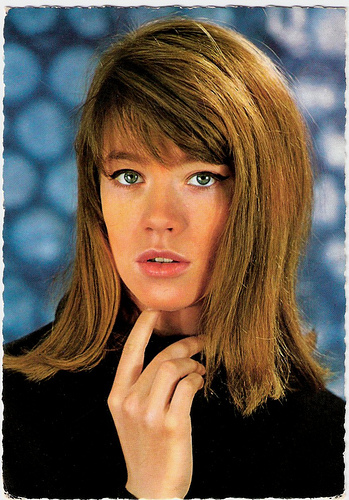
French postcard by Editions Publistar, no. 788. Photo: Nisak.
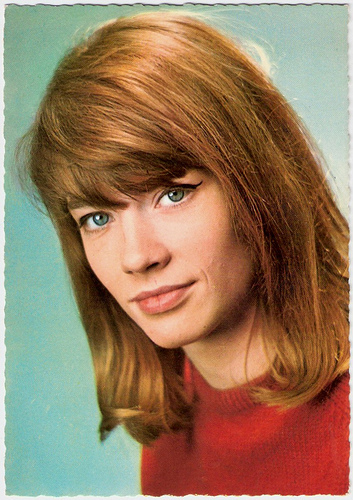
French postcard by E.D.U.G. Photo: Sam Lévin.
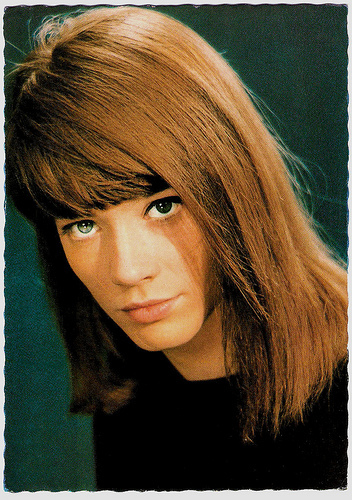
French postcard by E.D.U.G., no. 283. Photo: Sam Lévin.
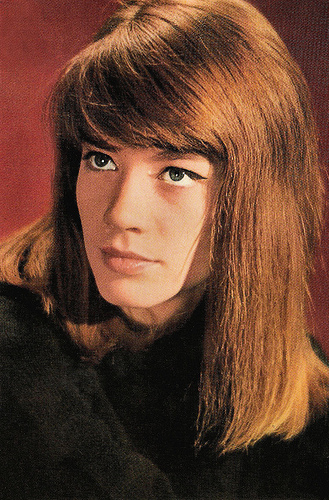
French postcard by E.D.U.G., no. 313. Photo: Sam Lévin.
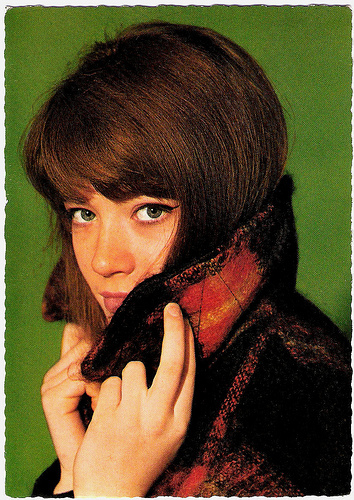
French postcard by Publistar, no. 858. Photo: Pierre Spitzer / Disques Vogue.
Ultimate girl-next-door made good
Françoise Madeleine Hardy was born in 1944 in Paris. She grew up with her younger sister Michèle Hardy in the 9th arrondissement. Their unmarried mother worked as an assistant accountant. The introvert Françoise was sent to La Bruyère, a rather strict convent school for girls. The tall, thin girl with long legs grew up to be an extremely studious and pious student who found it difficult to overcome her shyness.
On her sixteenth birthday, she received a guitar from her mostly absent father as a reward for passing her baccalaureate. She started to write her own songs in her free time, inspired by the music she heard on the radio. Françoise was a passionate music fan, listening to Georges Guétary ’s operettas from an early age, before progressing to French chanson stars Charles Trenet and Cora Vaucaire.
She enrolled at the Petit Conservatoire de Mireille, a legendary 1960s singing school, and at the Political Science Faculty at the Sorbonne. In late 1961 she answered a newspaper advertisement looking for young singers, and Hardy signed her first contract with the record label Vogue at the age of 17. With her shy temperament, her soft voice and her quiet natural beauty, Françoise Hardy was the ultimate girl-next-door made good.
In April 1962, her first record 'Oh Oh Chéri' appeared, written by Johnny Hallyday 's habitual writing duo, and three of Françoise’s own compositions including 'Tous Les Garçons Et Les Filles' (All the Boys and Girls).
This last track greatly impressed Daniel Filipacchi, presenter of Radio Europe’s cult music show Salut les Copains, who went on to play the song almost non-stop. It became a phenomenal box office hit, riding the wave of the Yé-yé (or Yeah-yeah - the French rock and roll craze), with two million sales. She first appeared on television in 1962 during an interlude in a programme reporting the results of a presidential referendum. The shy Hardy suddenly found herself at the very forefront of the French music scene.
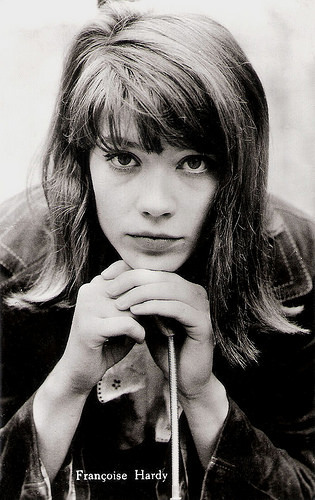
Dutch postcard by Gebr. Spanjersberg N.V., Rotterdam, no. ?103. Photo: Vogue.
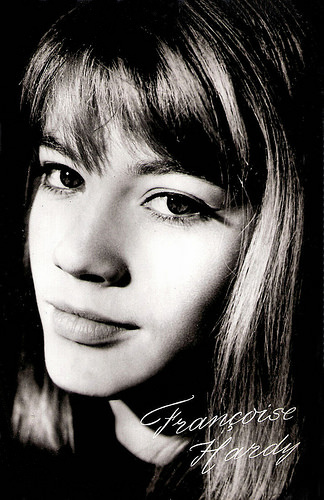
Dutch postcard by 't Sticht, Utrecht, no. AX 5543.
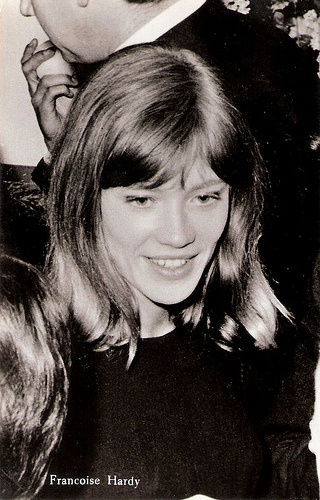
Dutch postcard by Gebr. Spanjersberg N.V., Rotterdam (SPARO). Photo: Vogue.
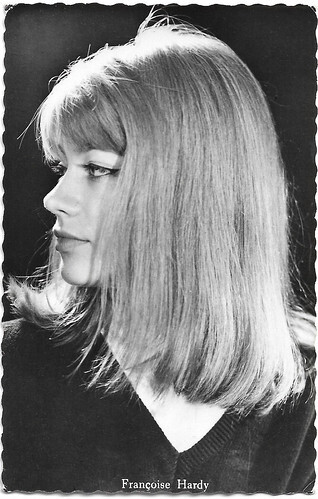
Dutch postcard, no. 1086. Photo: Vogue.
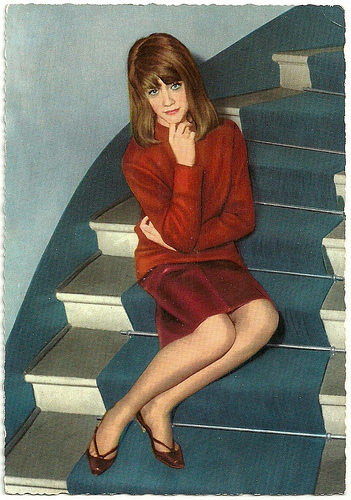
German postcard by Krüger. Photo: Pierre Spitzer.
Modern young trendsetter
Françoise Hardy soon began to appear on the cover of all the top music magazines of the day. During a photo shoot for the magazine Salut les Copains, she fell in love with photographer Jean-Marie Perier. Like a Pygmalion, he transformed the young singer from a shy, gauche-looking schoolgirl into a modern young trendsetter.
She made her first film appearance opposite Jean-Louis Trintignant in the comedy Château en Suède/Nutty, Naughty Chateau (Roger Vadim, 1963) based on a novel by Françoise Sagan. According to RFI Musique , "Françoise’s role in the film earned her much acclaim, and many critics declared that a great acting career lay ahead of her".
In the following years, she appeared in an uncredited appearance in the final scene of What's New Pussycat? (Clive Donner, Richard Talmadge, 1965) starring Peter O'Toole , and in Grand Prix (John Frankenheimer, 1966) starring James Garner .
In France, Hardy played the leading role in the crime drama Une Balle au Cœur/Devil at My Heels (Jean-Daniel Pollet, 1965) opposite Samy Frey . She appeared in a scene from the Nouvelle Vague masterpiece Masculin, féminin (Jean-Luc Godard, 1966) with Jean-Pierre Léaud . Other films in which she appeared include Les colombes/The Doves (Jean-Claude Lord, 1972) and the TV musical Émilie jolie (Jean-Christophe Averty, 1980) with Georges Brassens .
Her songs are featured on many film soundtracks. 'Tous Les Garçons et Les Filles', for instance, plays during the British film Metroland (Philip Saville, 1997), during The Dreamers (Bernardo Bertolucci, 2003), and during The Statement (Norman Jewison, 2003). Another song, 'L'Amitié' (1965), plays during the end credits of Les Invasions barbares/The Barbarian Invasions (Denys Arcand, 2003) which won the Academy Award for Best Foreign Language Film. 'Le temps de l'amour' can be heard on the soundtracks of Moonrise Kingdom (Wes Anderson, 2012) and Trainyard Dogs (Ryan Prince, 2016).
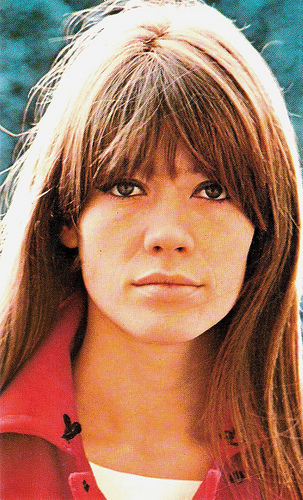
French postcard by Publistar, no. 1362. Photo: Jean-Marie Perier.
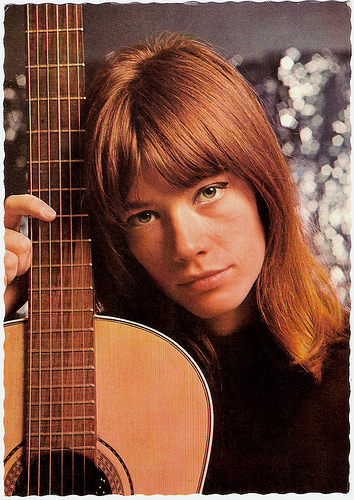
French postcard by Starcolor, Marseille, no. 951. Photo: Patrick de Mervellec.
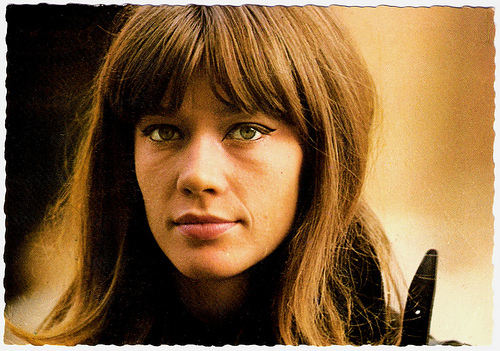
French postcard by Starcolor, Marseille, no. 972. Photo: Jean-Marie Perier.
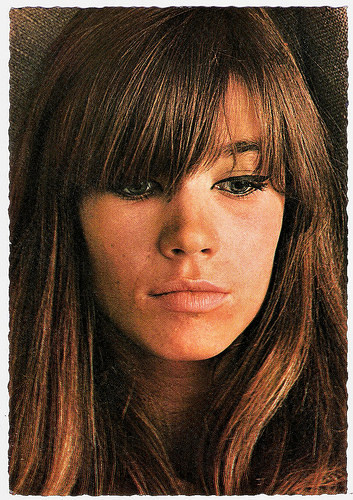
French postcard by Publistar, Paris, no. 1134. Photo: Jean-Marie Perier.
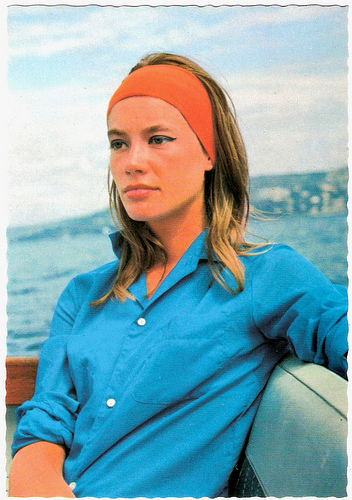
German postcard by ISV, no. H 132.
The sheer force of the emotion
Françoise Hardy was not interested in anything other than her singing career, and it went smoothly. In 1963 her début album had been released to general critical acclaim. That year she also came fifth for Monaco (!) in the Eurovision Song Contest with 'L'amour s'en va' (Love Goes Away), and she was awarded the Grand Prix Du Disque of the Charles Cros Academy.
The following year, she set off on an extensive European tour which included an appearance in Italy at the famous San Remo Festival. Here she performed 'Parla mi di te' (Tell me about you). She sang in French, English, Italian, Spanish, and German. Even though Hardy's voice was neither extremely powerful nor strikingly unusual, the singer continued to woo audiences throughout her career with her exceptional lyrics and the sheer force of the emotion she put into her performances.
In 1981, she married her long-time companion, actor/singer Jacques Dutronc , with whom she had a son, Thomas Dutronc, in 1973. In 1994, she collaborated with the British pop group Blur for their 'La Comedie' version of 'To The End', and in 2000, she made a comeback with the album 'Clair Obscur'. Her son played guitar and her husband sang the duet 'Puisque Vous Partez En Voyage' (Till You Leave on a Voyage). Iggy Pop and Étienne Daho also took part.
Françoise Hardy continued her successful career of more than 50 years. In 2010, she released a new album of original material, 'La Pluie sans parapluie' (Rain without an umbrella). In 2012, Hardy recorded her 27th album and published the book 'L'Amour fou'. In 2015, after two years of silence, a second book was published under the title 'Avis non-autorisé...' (Unauthorized opinion). In this book, she reflects on old age, her interests and her annoyances. She lived near Paris and although Dutronc lived in Monticello, Corsica, they remained married.
In March 2021, Françoise Hardy announced that she could not sing anymore as a consequence of cancer treatments. On 11 June 2024, she died of laryngeal cancer in Paris, at the age of 80.
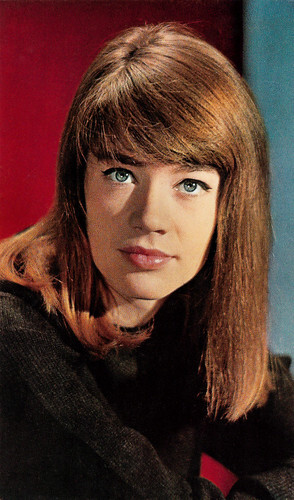
French postcard by E.D.U.G., offered by Corvisart, Epinal, no. 287. Photo: Sam Lévin.
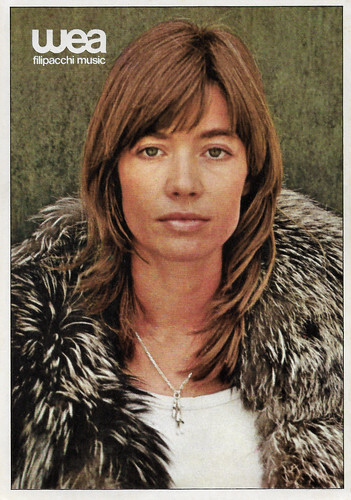
French collector card in the Hit Collection series by Figure Panini, no. 41. Photo: WEA / Filipachi Music.
Françoise Hardy sings L'amour s'en va at the Eurovision Contest of 1963. Source: Joao Velada (YouTube).
Francoise Hardy sings Comment te dire adieu (How to Say Farewell) in 1968. Source: Etoile Matutine (YouTube). This hit song was written by Serge Gainsbourg .
Scene from What's New Pussycat (1965) with Peter O'Toole , Romy Schneider and Peter Sellers . Source: Rocco And Fratelli (YouTube).
Sources: Warren Silbert (Françoise Hardy - All Over the World - now defunct), Frankenstein (Commencement - French), Radio France Internationale (French), Official Françoise Hardy website (French), Wikipedia, and .

French postcard by Editions Publistar, no. 788. Photo: Nisak.

French postcard by E.D.U.G. Photo: Sam Lévin.

French postcard by E.D.U.G., no. 283. Photo: Sam Lévin.

French postcard by E.D.U.G., no. 313. Photo: Sam Lévin.

French postcard by Publistar, no. 858. Photo: Pierre Spitzer / Disques Vogue.
Ultimate girl-next-door made good
Françoise Madeleine Hardy was born in 1944 in Paris. She grew up with her younger sister Michèle Hardy in the 9th arrondissement. Their unmarried mother worked as an assistant accountant. The introvert Françoise was sent to La Bruyère, a rather strict convent school for girls. The tall, thin girl with long legs grew up to be an extremely studious and pious student who found it difficult to overcome her shyness.
On her sixteenth birthday, she received a guitar from her mostly absent father as a reward for passing her baccalaureate. She started to write her own songs in her free time, inspired by the music she heard on the radio. Françoise was a passionate music fan, listening to Georges Guétary ’s operettas from an early age, before progressing to French chanson stars Charles Trenet and Cora Vaucaire.
She enrolled at the Petit Conservatoire de Mireille, a legendary 1960s singing school, and at the Political Science Faculty at the Sorbonne. In late 1961 she answered a newspaper advertisement looking for young singers, and Hardy signed her first contract with the record label Vogue at the age of 17. With her shy temperament, her soft voice and her quiet natural beauty, Françoise Hardy was the ultimate girl-next-door made good.
In April 1962, her first record 'Oh Oh Chéri' appeared, written by Johnny Hallyday 's habitual writing duo, and three of Françoise’s own compositions including 'Tous Les Garçons Et Les Filles' (All the Boys and Girls).
This last track greatly impressed Daniel Filipacchi, presenter of Radio Europe’s cult music show Salut les Copains, who went on to play the song almost non-stop. It became a phenomenal box office hit, riding the wave of the Yé-yé (or Yeah-yeah - the French rock and roll craze), with two million sales. She first appeared on television in 1962 during an interlude in a programme reporting the results of a presidential referendum. The shy Hardy suddenly found herself at the very forefront of the French music scene.

Dutch postcard by Gebr. Spanjersberg N.V., Rotterdam, no. ?103. Photo: Vogue.

Dutch postcard by 't Sticht, Utrecht, no. AX 5543.

Dutch postcard by Gebr. Spanjersberg N.V., Rotterdam (SPARO). Photo: Vogue.

Dutch postcard, no. 1086. Photo: Vogue.

German postcard by Krüger. Photo: Pierre Spitzer.
Modern young trendsetter
Françoise Hardy soon began to appear on the cover of all the top music magazines of the day. During a photo shoot for the magazine Salut les Copains, she fell in love with photographer Jean-Marie Perier. Like a Pygmalion, he transformed the young singer from a shy, gauche-looking schoolgirl into a modern young trendsetter.
She made her first film appearance opposite Jean-Louis Trintignant in the comedy Château en Suède/Nutty, Naughty Chateau (Roger Vadim, 1963) based on a novel by Françoise Sagan. According to RFI Musique , "Françoise’s role in the film earned her much acclaim, and many critics declared that a great acting career lay ahead of her".
In the following years, she appeared in an uncredited appearance in the final scene of What's New Pussycat? (Clive Donner, Richard Talmadge, 1965) starring Peter O'Toole , and in Grand Prix (John Frankenheimer, 1966) starring James Garner .
In France, Hardy played the leading role in the crime drama Une Balle au Cœur/Devil at My Heels (Jean-Daniel Pollet, 1965) opposite Samy Frey . She appeared in a scene from the Nouvelle Vague masterpiece Masculin, féminin (Jean-Luc Godard, 1966) with Jean-Pierre Léaud . Other films in which she appeared include Les colombes/The Doves (Jean-Claude Lord, 1972) and the TV musical Émilie jolie (Jean-Christophe Averty, 1980) with Georges Brassens .
Her songs are featured on many film soundtracks. 'Tous Les Garçons et Les Filles', for instance, plays during the British film Metroland (Philip Saville, 1997), during The Dreamers (Bernardo Bertolucci, 2003), and during The Statement (Norman Jewison, 2003). Another song, 'L'Amitié' (1965), plays during the end credits of Les Invasions barbares/The Barbarian Invasions (Denys Arcand, 2003) which won the Academy Award for Best Foreign Language Film. 'Le temps de l'amour' can be heard on the soundtracks of Moonrise Kingdom (Wes Anderson, 2012) and Trainyard Dogs (Ryan Prince, 2016).

French postcard by Publistar, no. 1362. Photo: Jean-Marie Perier.

French postcard by Starcolor, Marseille, no. 951. Photo: Patrick de Mervellec.

French postcard by Starcolor, Marseille, no. 972. Photo: Jean-Marie Perier.

French postcard by Publistar, Paris, no. 1134. Photo: Jean-Marie Perier.

German postcard by ISV, no. H 132.
The sheer force of the emotion
Françoise Hardy was not interested in anything other than her singing career, and it went smoothly. In 1963 her début album had been released to general critical acclaim. That year she also came fifth for Monaco (!) in the Eurovision Song Contest with 'L'amour s'en va' (Love Goes Away), and she was awarded the Grand Prix Du Disque of the Charles Cros Academy.
The following year, she set off on an extensive European tour which included an appearance in Italy at the famous San Remo Festival. Here she performed 'Parla mi di te' (Tell me about you). She sang in French, English, Italian, Spanish, and German. Even though Hardy's voice was neither extremely powerful nor strikingly unusual, the singer continued to woo audiences throughout her career with her exceptional lyrics and the sheer force of the emotion she put into her performances.
In 1981, she married her long-time companion, actor/singer Jacques Dutronc , with whom she had a son, Thomas Dutronc, in 1973. In 1994, she collaborated with the British pop group Blur for their 'La Comedie' version of 'To The End', and in 2000, she made a comeback with the album 'Clair Obscur'. Her son played guitar and her husband sang the duet 'Puisque Vous Partez En Voyage' (Till You Leave on a Voyage). Iggy Pop and Étienne Daho also took part.
Françoise Hardy continued her successful career of more than 50 years. In 2010, she released a new album of original material, 'La Pluie sans parapluie' (Rain without an umbrella). In 2012, Hardy recorded her 27th album and published the book 'L'Amour fou'. In 2015, after two years of silence, a second book was published under the title 'Avis non-autorisé...' (Unauthorized opinion). In this book, she reflects on old age, her interests and her annoyances. She lived near Paris and although Dutronc lived in Monticello, Corsica, they remained married.
In March 2021, Françoise Hardy announced that she could not sing anymore as a consequence of cancer treatments. On 11 June 2024, she died of laryngeal cancer in Paris, at the age of 80.

French postcard by E.D.U.G., offered by Corvisart, Epinal, no. 287. Photo: Sam Lévin.

French collector card in the Hit Collection series by Figure Panini, no. 41. Photo: WEA / Filipachi Music.
Françoise Hardy sings L'amour s'en va at the Eurovision Contest of 1963. Source: Joao Velada (YouTube).
Francoise Hardy sings Comment te dire adieu (How to Say Farewell) in 1968. Source: Etoile Matutine (YouTube). This hit song was written by Serge Gainsbourg .
Scene from What's New Pussycat (1965) with Peter O'Toole , Romy Schneider and Peter Sellers . Source: Rocco And Fratelli (YouTube).
Sources: Warren Silbert (Françoise Hardy - All Over the World - now defunct), Frankenstein (Commencement - French), Radio France Internationale (French), Official Françoise Hardy website (French), Wikipedia, and .
Published on June 12, 2024 22:00
June 11, 2024
Jewel Carmen
American actress Jewel Carmen (1897-1984) appeared in more than 40 silent films. She peaked in the later 1910s at Triangle and Fox opposite the actors Douglas Fairbanks and William Farnum. Her film The Bat (1926) was one of the inspirations for 'Batman'.
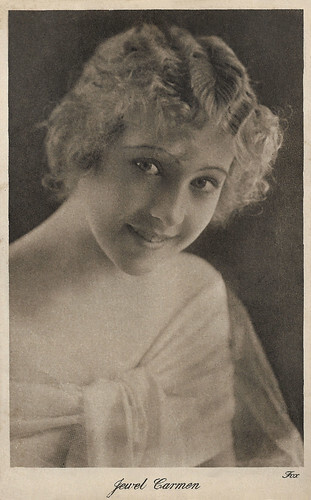
British postcard by Cinema Chat. Photo: Fox.
Méliès, Keystone, Fine Arts and Fox
Jewel Carmen was born Florence Lavina Quick in Portland, Oregon, in 1897. She was the daughter of farmer and carpenter Amos William Quick and Minerva Quick. In 1911, Amos left his wife and children to seek work in Los Angeles. Quick moved with her mother to Los Angeles a year later, following her father. She aspired to be an actress and within two weeks, she found work as a film extra for the DeMille Company.
When she was only 15, she made her film debut credited as Florence La Vinci in The Will of Destiny (1912) for the American production company of French pioneer Georges Méliès. According to The Moving Picture World on 17 August 1912, "The acting is good and the photography is commendable." For Méliès, she also appeared in another short, A Son's Example (1912) with Ray Gallagher and Richard Stanton.
Then she moved to Keystone and played in the short comedy The Professor's Daughter (Mack Sennett, 1913) opposite Fred Mace and Ford Sterling. For Keystone, she acted in 13 films and was renamed Evelyn Quick. To Mack Sennett, she claimed she was 17, as 16 was the minimal age at Keystone. She hit the newspapers in 1913 when the 15-year-old Carmen was involved in a case of statutory rape against the wealthy 35-year-old automobile dealer William La Casse, but as she couldn't prove her age, the case was dropped. Among her other Keystone comedies are The Gangsters (Henry Lehrmann, 1913) starring Fatty Arbuckle and Cupid in a Dental Parlor (Henry Lehrmann, 1913) as the love of Fred Mace.
After the scandal, Quick took three years off. At 19, she resumed her film career under the name Jewel Carmen in her first feature-length production, the adventure film Daphne and the Pirate (Christy Cabanne, 1916). D.W. Griffith was the screenwriter for this Fine Arts production which starred Lilian Gish as Daphne. Nine more films followed that year, including Sunshine Dad (Edward Dillon, 1916) and The Children in the House (Sidney Franklin, Chester M. Franklin, 1916) with Norma Talmadge . In the adventure films Manhattan Madness (Allan Dwan, 1916) and Flirting with Fate (Christy Cabanne, 19160, she co-starred with Douglas Fairbanks. On the side that year, she was in short comedies at L-Ko, still under the name of Evelyn Quick. She had a bit role as a harem favourite in the classic Intolerance: Love's Struggle Throughout the Ages (D.W. Griffith, 1916).
Jewel Carmen went on to six films in 1917 for the Fox Film Corporation. These included the Charles Dickens adaptation A Tale of Two Cities (Frank Lloyd, 1917) opposite William Farnum . She also played Cosette in Lloyd's Victor Hugo adaptation Les Miserables (Frank Lloyd, 1917) starring William Farnum as Jean Valjean. Carmen was the star of Lloyd's The Kingdom of Love (Frank Lloyd, 1917). In 1918, she starred for Fox in five films including the Western Lawless Love (1918). Then her career halted.
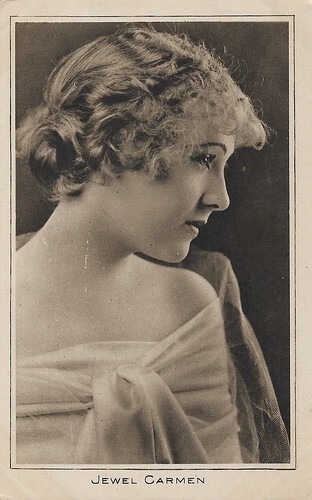
British postcard in the "Pictures" Portrait Gallery by Ed. Pictures Ltd., London, no. 10. Photo: Fox.
Ongoing lawsuits
After Confession (Sidney Franklin, 1918), Jewel Carmen went to court to free herself from her contract with Fox. Amidst the ongoing lawsuits, which she partly won, she married director Roland West. When her contract with Fox stopped, she left the film industry for three years.
Carmen returned to the screen at Metro in the mystery Nobody (Roland West, 1921). That year, she also starred in West's The Silver Lining (Roland West, 1921) with Virginia Valli .
Three years later, she played a small part at Fox in You Can't Get Away with It (Rowland V. Lee, 1924) starring Percy Marmont and Malcolm McGregor. The film was a remake of her film Fallen Angel (Robert Thornby, 1918).
Her final fling with the cinema was The Bat (Roland West, 1926), with Jack Pickford, Louise Fazenda and Tullio Carminati . A master crook known as 'The Bat' because of his disguise announces a jewel theft in advance but is foiled by a rival crook at the scene of the crime. Bob Kane stated in the documentary 'The Comic Book Greats' that this thriller was one of the inspirations for 'Batman'. Wes Connors at IMDb : 'Jack Pickford (as Brooks Bailey) and West's wife, Jewel Carmen (as Dale Ogden), lead the ensemble cast. This was Ms. Carmen's last feature film; she was a fairly big star, but worked less as her popularity grew."
Carmen later became known for her connection to the scandal surrounding the death of actress Thelma Todd in 1935. Todd was found with carbon monoxide poisoning in her car, which was parked and running in the garage of the Castillo del Mar. This was a residence of Carmen and West in Pacific Palisades, where Carmen's parents were living. Various scenarios about who the culprit was passed, including West who had an affair with Todd and gangster Lucky Luciano. In the end, Todd's death was ruled accidental. Carmen separated from Roland West and withdrew from public life. Jewel Carmen died of lymphoma at Helix View Nursing Home in El Cajon, California, in 1984 at the age of 86.
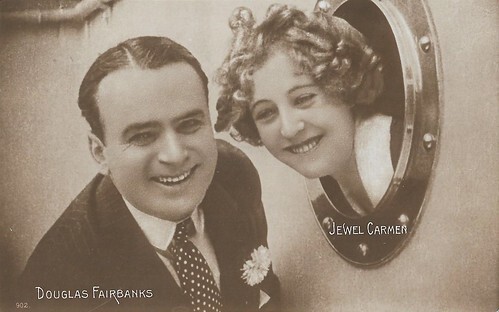
Swedish postcard by Förlag Nordisk Konst, Stockholm, no. 902. With Douglas Fairbanks .
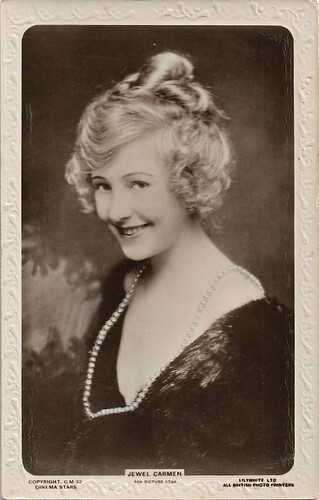
British postcard by Lilywhite Ltd. in the Cinema Stars series, no. C M-32. Photo: Fox.
Sources: Wes Connors (IMDb), (IMDb), Wikipedia and .

British postcard by Cinema Chat. Photo: Fox.
Méliès, Keystone, Fine Arts and Fox
Jewel Carmen was born Florence Lavina Quick in Portland, Oregon, in 1897. She was the daughter of farmer and carpenter Amos William Quick and Minerva Quick. In 1911, Amos left his wife and children to seek work in Los Angeles. Quick moved with her mother to Los Angeles a year later, following her father. She aspired to be an actress and within two weeks, she found work as a film extra for the DeMille Company.
When she was only 15, she made her film debut credited as Florence La Vinci in The Will of Destiny (1912) for the American production company of French pioneer Georges Méliès. According to The Moving Picture World on 17 August 1912, "The acting is good and the photography is commendable." For Méliès, she also appeared in another short, A Son's Example (1912) with Ray Gallagher and Richard Stanton.
Then she moved to Keystone and played in the short comedy The Professor's Daughter (Mack Sennett, 1913) opposite Fred Mace and Ford Sterling. For Keystone, she acted in 13 films and was renamed Evelyn Quick. To Mack Sennett, she claimed she was 17, as 16 was the minimal age at Keystone. She hit the newspapers in 1913 when the 15-year-old Carmen was involved in a case of statutory rape against the wealthy 35-year-old automobile dealer William La Casse, but as she couldn't prove her age, the case was dropped. Among her other Keystone comedies are The Gangsters (Henry Lehrmann, 1913) starring Fatty Arbuckle and Cupid in a Dental Parlor (Henry Lehrmann, 1913) as the love of Fred Mace.
After the scandal, Quick took three years off. At 19, she resumed her film career under the name Jewel Carmen in her first feature-length production, the adventure film Daphne and the Pirate (Christy Cabanne, 1916). D.W. Griffith was the screenwriter for this Fine Arts production which starred Lilian Gish as Daphne. Nine more films followed that year, including Sunshine Dad (Edward Dillon, 1916) and The Children in the House (Sidney Franklin, Chester M. Franklin, 1916) with Norma Talmadge . In the adventure films Manhattan Madness (Allan Dwan, 1916) and Flirting with Fate (Christy Cabanne, 19160, she co-starred with Douglas Fairbanks. On the side that year, she was in short comedies at L-Ko, still under the name of Evelyn Quick. She had a bit role as a harem favourite in the classic Intolerance: Love's Struggle Throughout the Ages (D.W. Griffith, 1916).
Jewel Carmen went on to six films in 1917 for the Fox Film Corporation. These included the Charles Dickens adaptation A Tale of Two Cities (Frank Lloyd, 1917) opposite William Farnum . She also played Cosette in Lloyd's Victor Hugo adaptation Les Miserables (Frank Lloyd, 1917) starring William Farnum as Jean Valjean. Carmen was the star of Lloyd's The Kingdom of Love (Frank Lloyd, 1917). In 1918, she starred for Fox in five films including the Western Lawless Love (1918). Then her career halted.

British postcard in the "Pictures" Portrait Gallery by Ed. Pictures Ltd., London, no. 10. Photo: Fox.
Ongoing lawsuits
After Confession (Sidney Franklin, 1918), Jewel Carmen went to court to free herself from her contract with Fox. Amidst the ongoing lawsuits, which she partly won, she married director Roland West. When her contract with Fox stopped, she left the film industry for three years.
Carmen returned to the screen at Metro in the mystery Nobody (Roland West, 1921). That year, she also starred in West's The Silver Lining (Roland West, 1921) with Virginia Valli .
Three years later, she played a small part at Fox in You Can't Get Away with It (Rowland V. Lee, 1924) starring Percy Marmont and Malcolm McGregor. The film was a remake of her film Fallen Angel (Robert Thornby, 1918).
Her final fling with the cinema was The Bat (Roland West, 1926), with Jack Pickford, Louise Fazenda and Tullio Carminati . A master crook known as 'The Bat' because of his disguise announces a jewel theft in advance but is foiled by a rival crook at the scene of the crime. Bob Kane stated in the documentary 'The Comic Book Greats' that this thriller was one of the inspirations for 'Batman'. Wes Connors at IMDb : 'Jack Pickford (as Brooks Bailey) and West's wife, Jewel Carmen (as Dale Ogden), lead the ensemble cast. This was Ms. Carmen's last feature film; she was a fairly big star, but worked less as her popularity grew."
Carmen later became known for her connection to the scandal surrounding the death of actress Thelma Todd in 1935. Todd was found with carbon monoxide poisoning in her car, which was parked and running in the garage of the Castillo del Mar. This was a residence of Carmen and West in Pacific Palisades, where Carmen's parents were living. Various scenarios about who the culprit was passed, including West who had an affair with Todd and gangster Lucky Luciano. In the end, Todd's death was ruled accidental. Carmen separated from Roland West and withdrew from public life. Jewel Carmen died of lymphoma at Helix View Nursing Home in El Cajon, California, in 1984 at the age of 86.

Swedish postcard by Förlag Nordisk Konst, Stockholm, no. 902. With Douglas Fairbanks .

British postcard by Lilywhite Ltd. in the Cinema Stars series, no. C M-32. Photo: Fox.
Sources: Wes Connors (IMDb), (IMDb), Wikipedia and .
Published on June 11, 2024 22:00
Paul van Yperen's Blog
- Paul van Yperen's profile
- 13 followers
Paul van Yperen isn't a Goodreads Author
(yet),
but they
do have a blog,
so here are some recent posts imported from
their feed.



